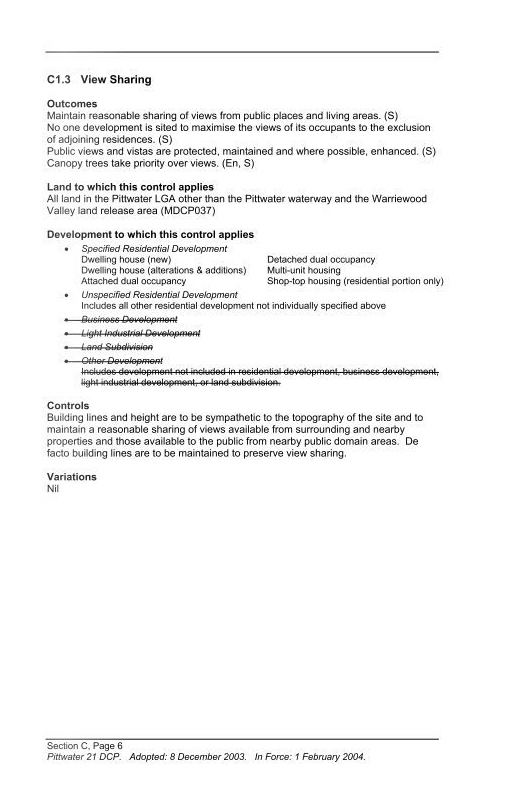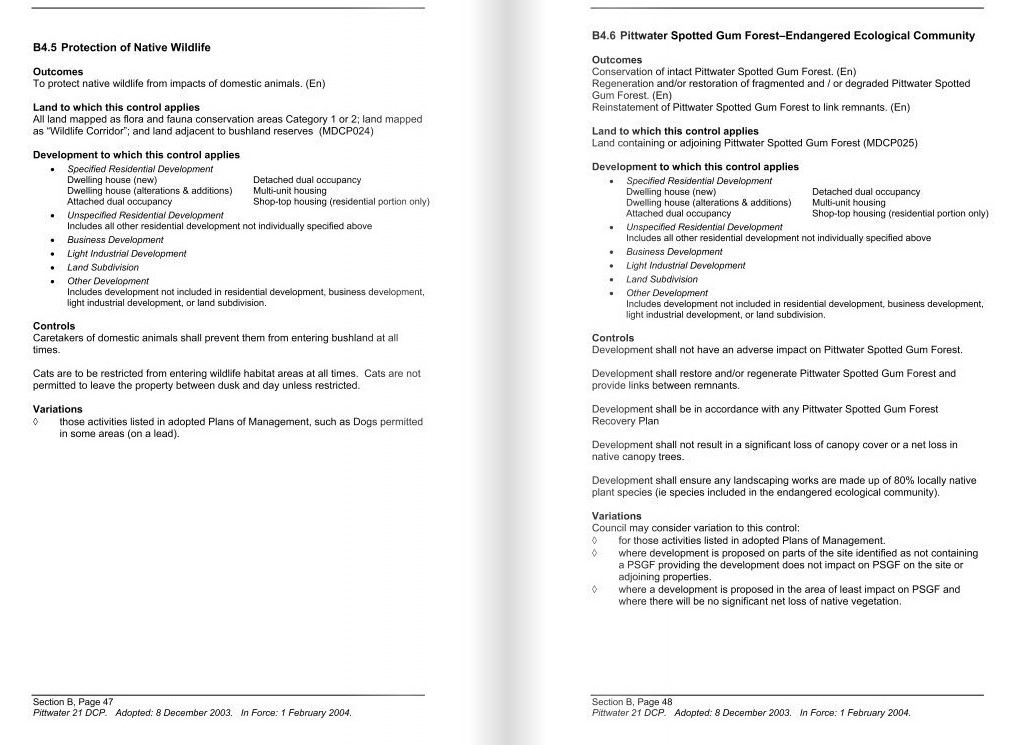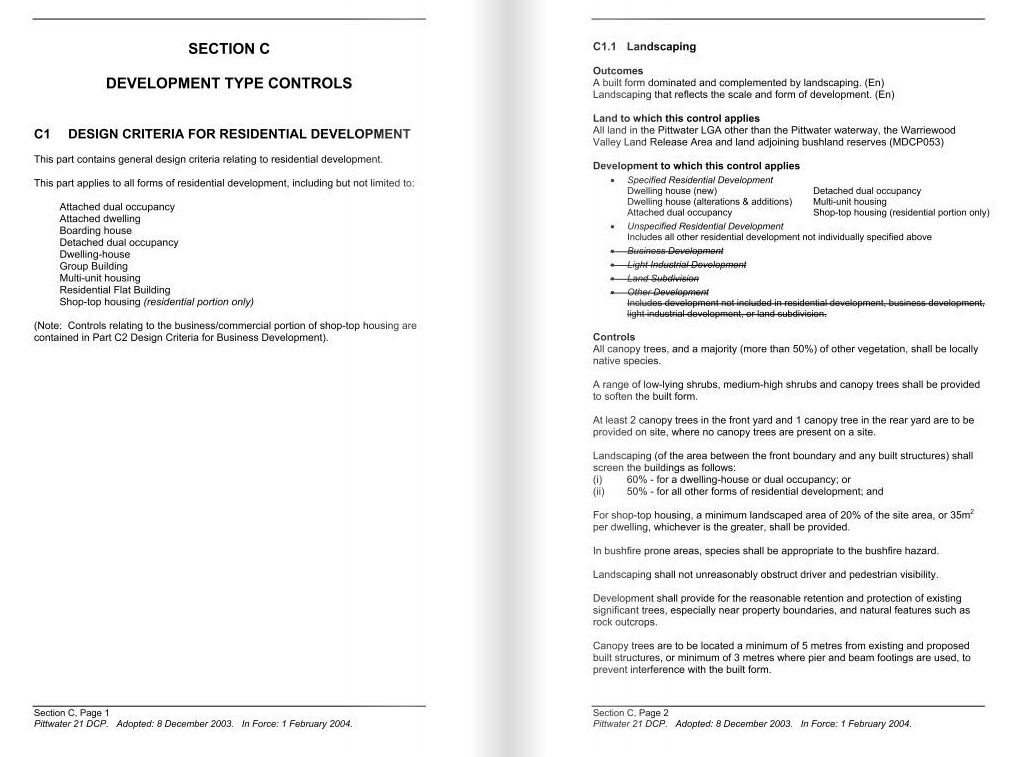Inbox and environment news: Issue 568
January 22 - 28 2023: Issue 568
Barrenjoey Rally 2023
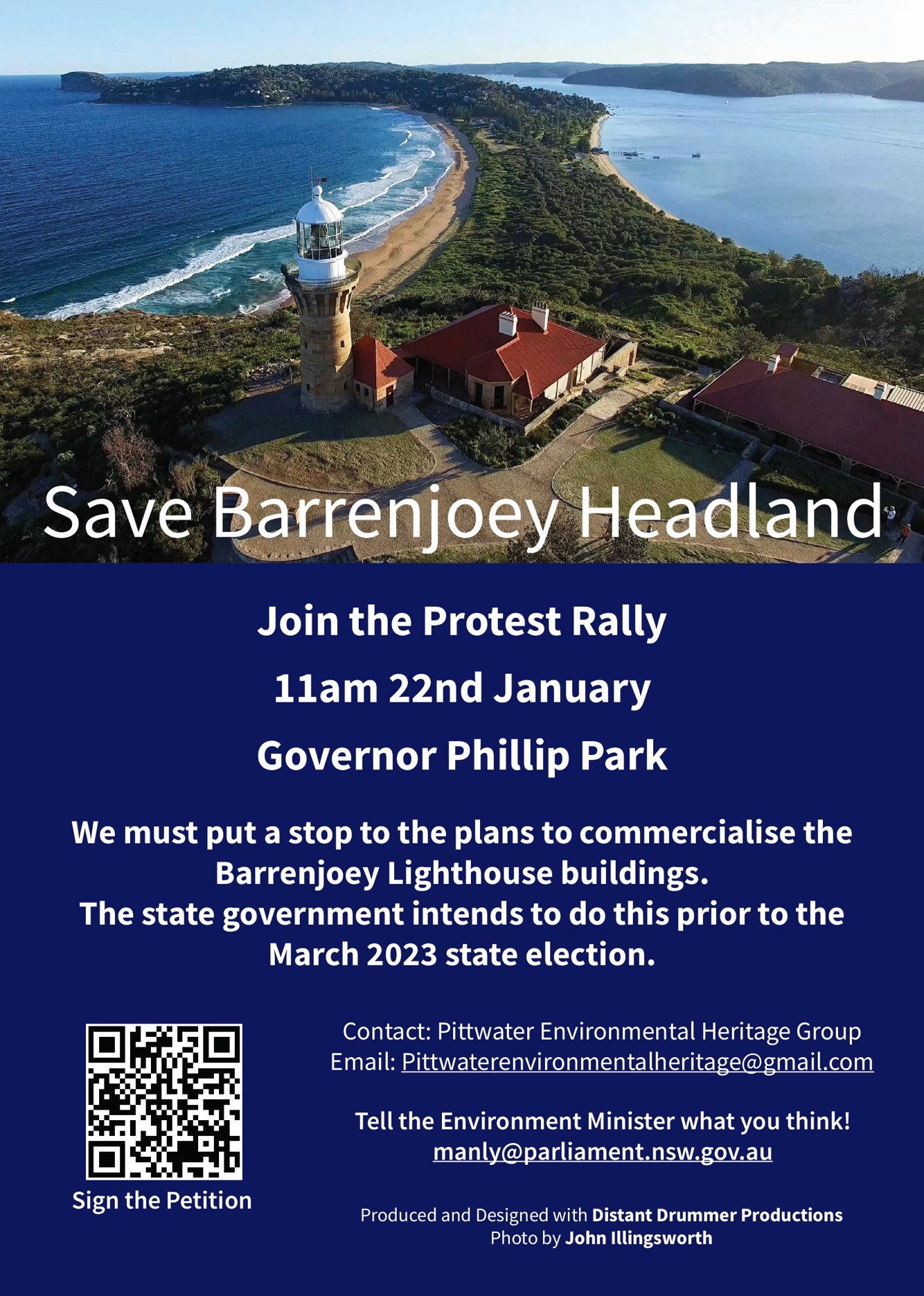
Newly Installed Synthetic 'Soft' Pad At Newport Beach Outdoor Youth Space Already Deteriorating: The Holes In Choosing A Poison Over The Natural More Apparent In 2023
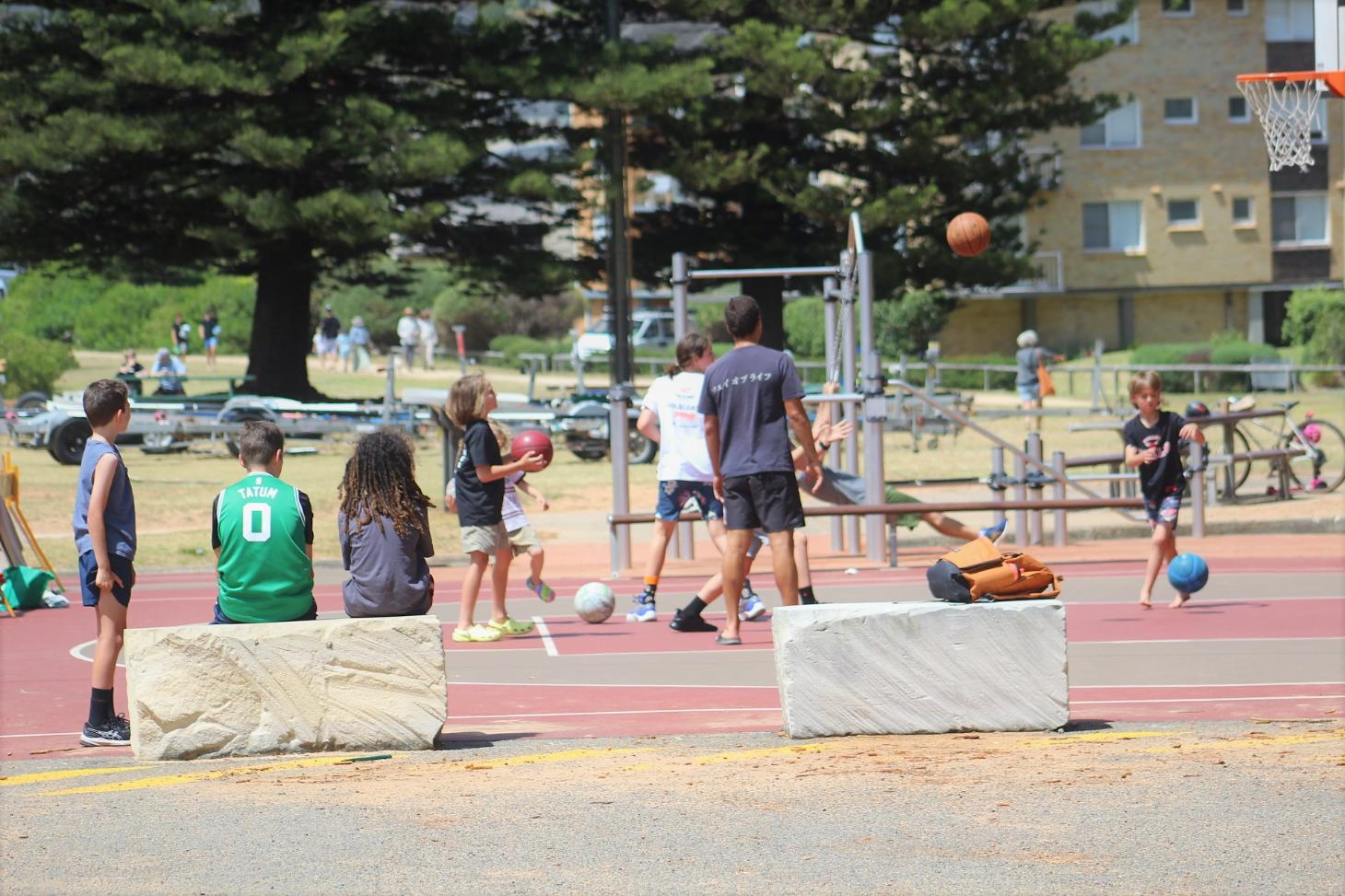
In December 2019 the council stated it was 'looking at an opportunity to modify a part of the Newport Beach car park (adjacent to the Newport Surf Life Saving Club) to potentially provide a new outdoor space for our youth.'
By March 2020 the council had feedback from residents which included main themes of:
- alternative location
- natural materials
- anti-social behaviour
- impact to the surf life saving club
- other elements not included in the design (i.e. lighting, netball court, table tennis table).
By December 2020 council announced they had a revised plan. However using natural materials was ignored, as was an alternative location.
In late March 2021 construction had commenced and was quickly completed with concrete, a new outdoor gym, half basketball court and handball court installed by May 2021.
By November 2022 it was evident that the 'soft-fall' area, a synthetic pad installed as part of the gym equipment underlay, was deteriorating - this has since enlarged.
Toxic pollutants and plastics introduced into the beach environment is the result of this deterioration.
Paradoxically, the enlarging pit is catching the 'soft' in the natural beach sand that comprises Newport Beach.
November 2022 a year and a half on from installation
In 2021 a concerned resident contact Pittwater Online about the council's plans to install synthetic turf next to another area beside a waterway after the failure of a synthetic turf installation at Forestville.
Melwood Oval at Forestville has had a synthetic field installed and during heavy rains Julia Walsh witnessed "pulverised rubber" washing off and down pathways.
"It's not just the plastics that you can see, it's the plastics you can't see," Julia stated in 2021.
"The biggest concern is that we're putting these fields in water catchment zones."
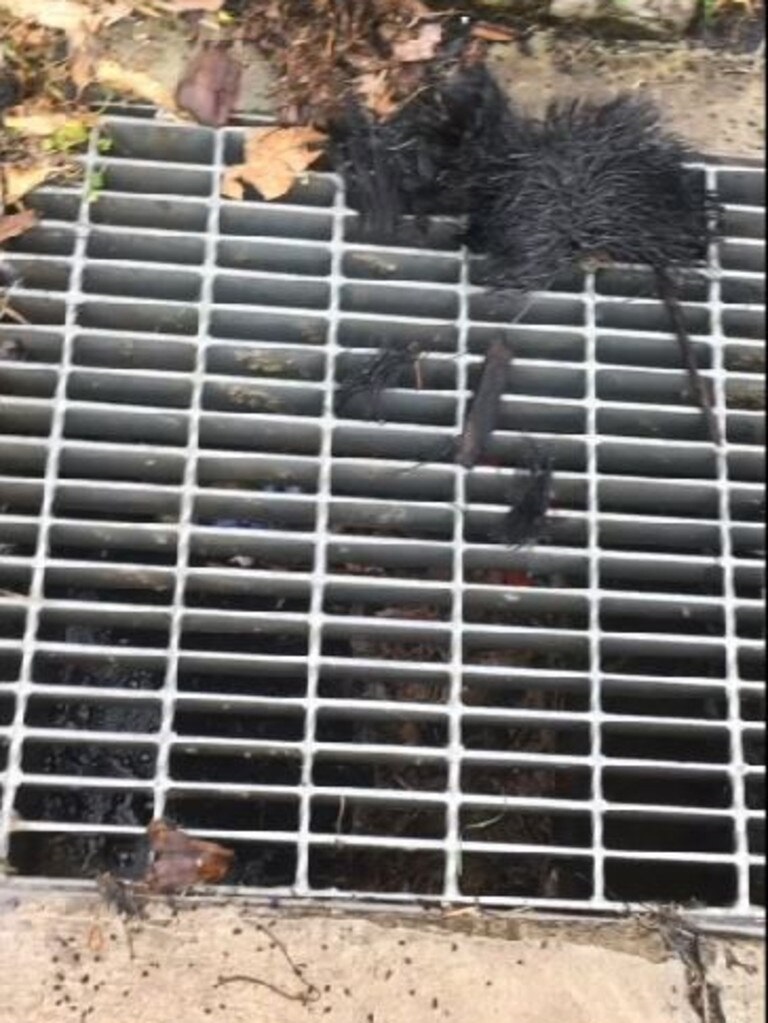
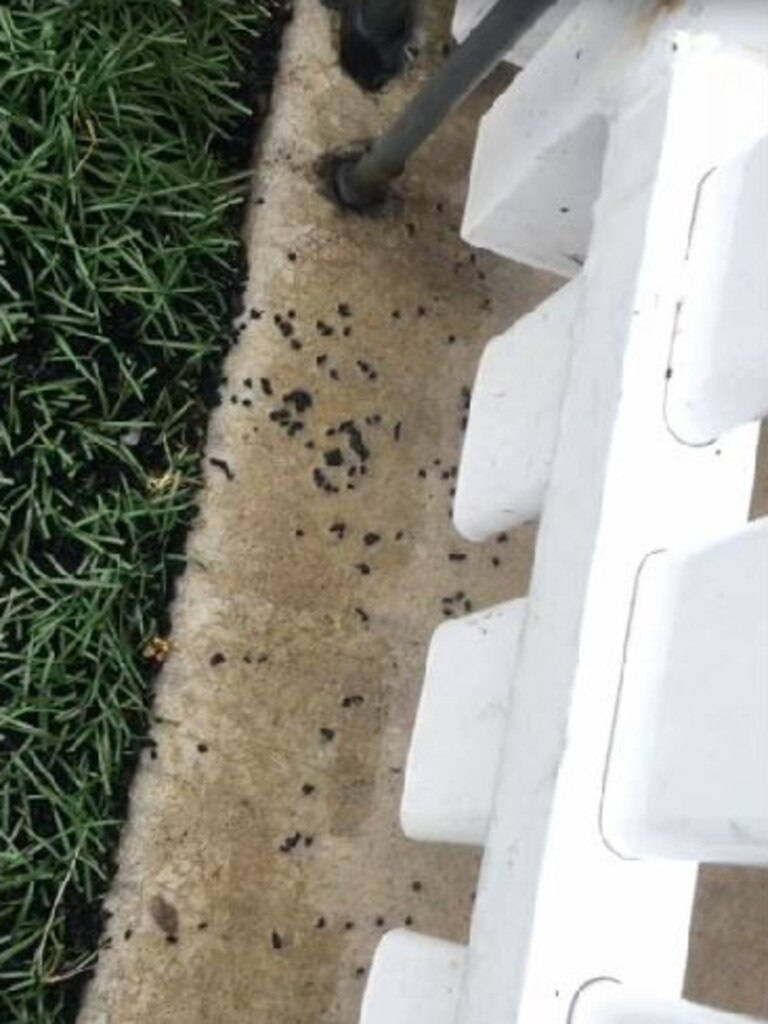
Melwood Oval - synthetic field fragmenting. Images: supplied.
At the March 2021 council meeting, councillors Stuart Sprott and Roslyn Harrison called for council to halt approvals of synthetic fields pending a NSW Government investigation into sustainable alternatives, which was called for by then Planning Minister Rob Stokes. Their response was not supported by other councillors.
The Independent review into the design, use and impacts of synthetic turf in public open spaces by the NSW Chief Scientist and Engineer tabled an initial report in February 2022, with the final report due mid-year. This has not as yet been made public if it has been completed. The February 2022 interim report may be accessed at: www.chiefscientist.nsw.gov.au/independent-reports/synthetic-turf-in-public-spaces
On December 22nd 2022 the NSW Department of Planning and Environment stated it 'is working closely with councils, industry and government agencies to create guidelines to assist decision making on the use of synthetic turf, which will be released in 2023.'
Julia Walsh sent in a video update on one of the grassed areas for which synthetic fields is proposed, alongside Manly Creek, taken after rains in February-March 2022.
Millers Reserve at Manly Vale is among seven greenspaces across the LGA that will be "upgraded" to a synthetic surface, with a $203,000 tender already awarded for the works. Millers Reserve is located beside Manly Creek, which flows to Manly Dam, and Ms Walsh is concerned about run-off there.
Seven new synthetic ovals are planned for our area, including one being touted for Careel Bay, which floods during rain events with refuse carried into the wetlands alongside these. Careel Bay is a Wildlife Preservation Area (WPA) due to its importance to resident wildlife as well as migratory birds, many of which are endangered species.
Pittwater Council installed a watering system at the 'mini soccer' fields to keep the grass green at the Careel Bay playing fields just prior to being amalgamated into the NBC LGA. This system has not been seen in operation during drier periods since.
Football players across the state like synthetic surfaces as these are always available and not susceptible to the dry times that make much used surfaces dust bowls, or the mud that can come with too much rain.
However, the synthetic fields not only permanently eliminate these green spaces as habitat for birds and other wildlife foraging, they heat up areas and when deteriorating, pollute environment and are ingested by species living in these environments.
There are also problems during flood events, as seen in these images:
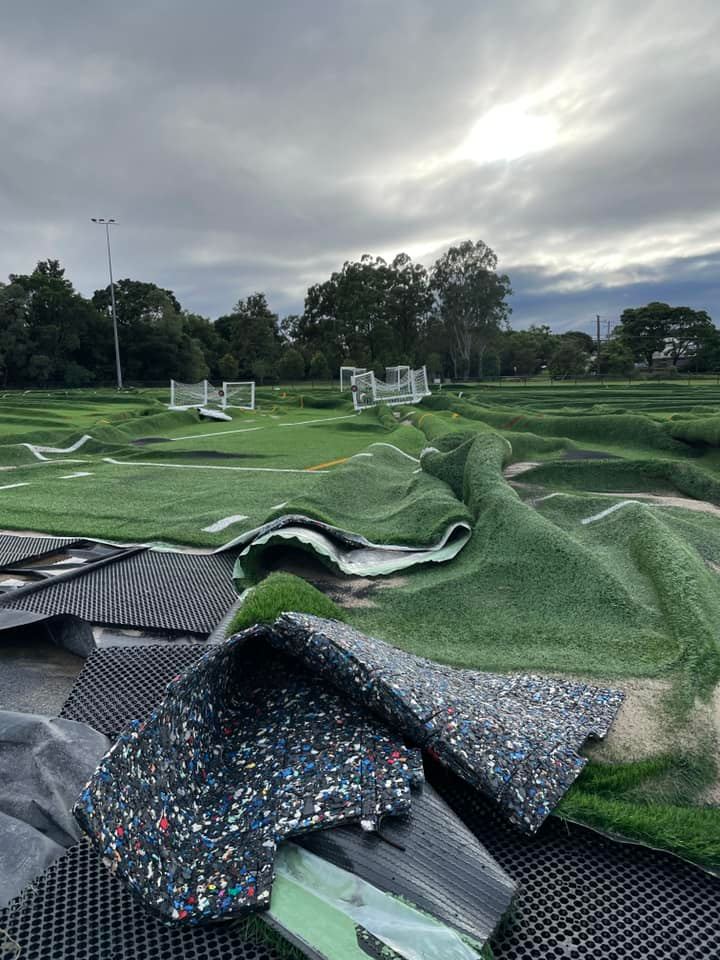

Mitchelton football field No 2 in Everton Park Brisbane after rains there - February 28, 2022. The rest of their fields are grassed areas and these were quickly restored/cleaned to allow commencement of their Season in March. From the Mitchelton football Club Facebook page.
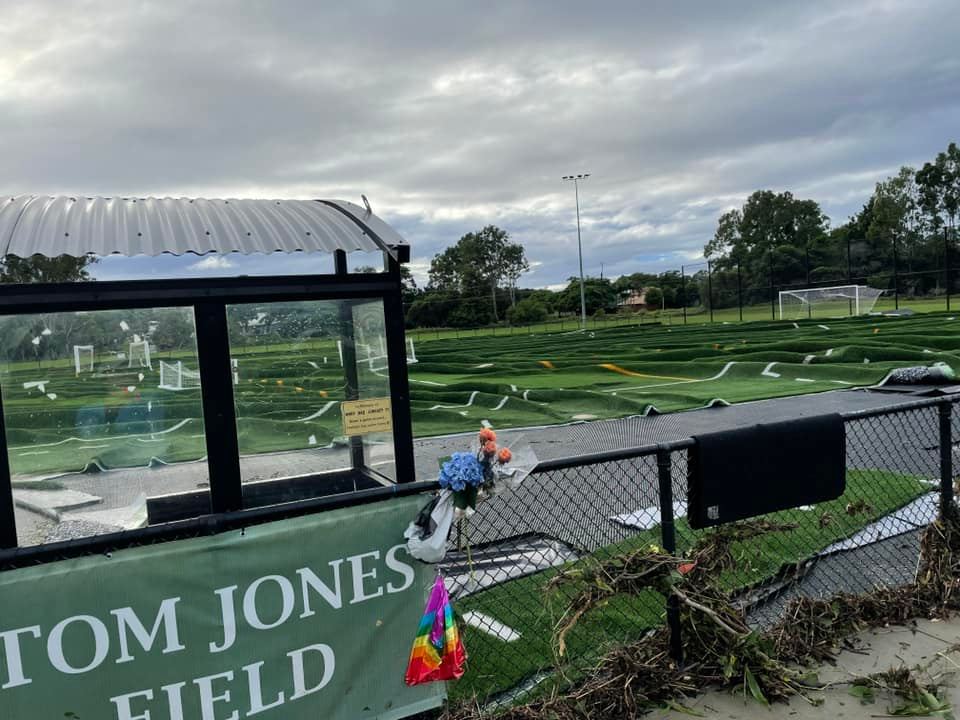
Mitchelton football field No 2 in Brisbane after rains there - February 28, 2022. From the Mitchelton football Club Facebook page.

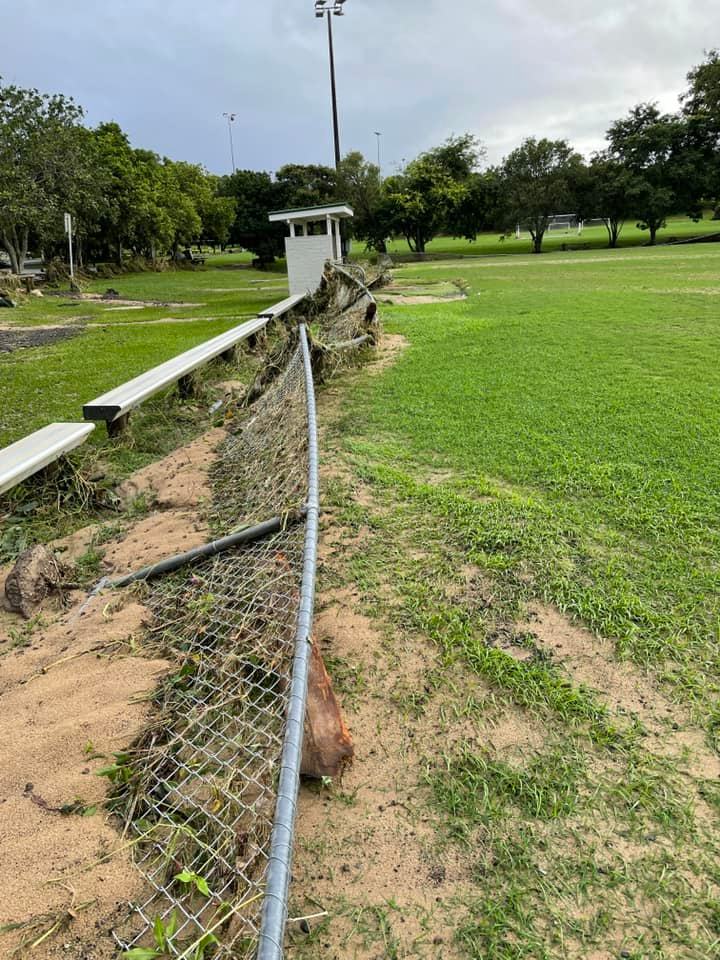
Mitchelton football club - Fields 1, 3-4 in Brisbane after rains there, and perimeter's - February 28, 2022. From the Mitchelton football Club Facebook page.
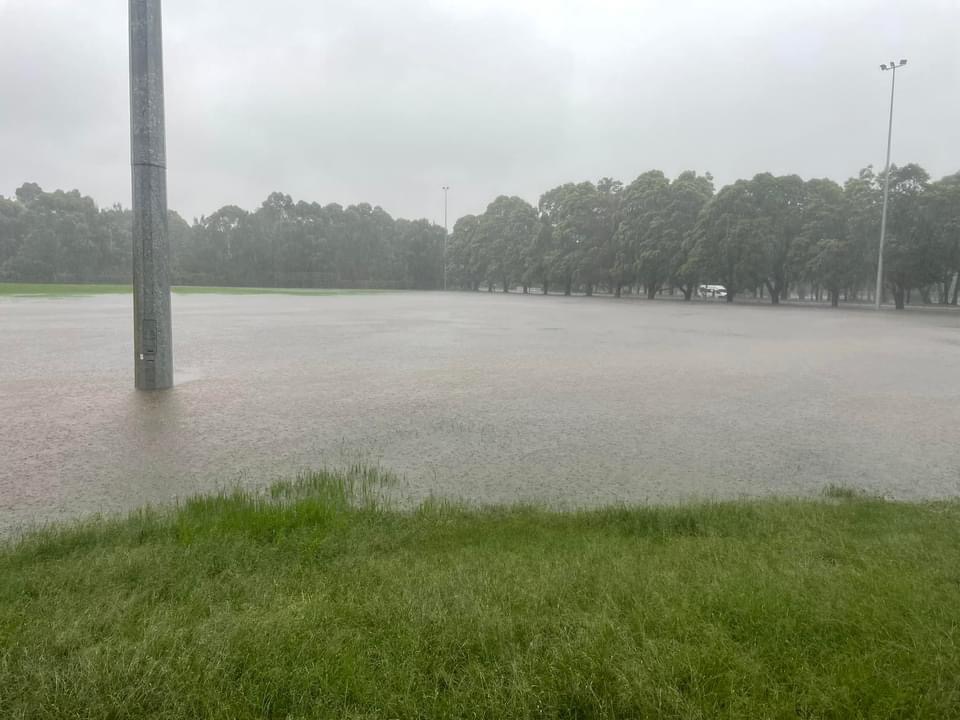
Millers Reserve submerged by water after the heavy rains, March 2022
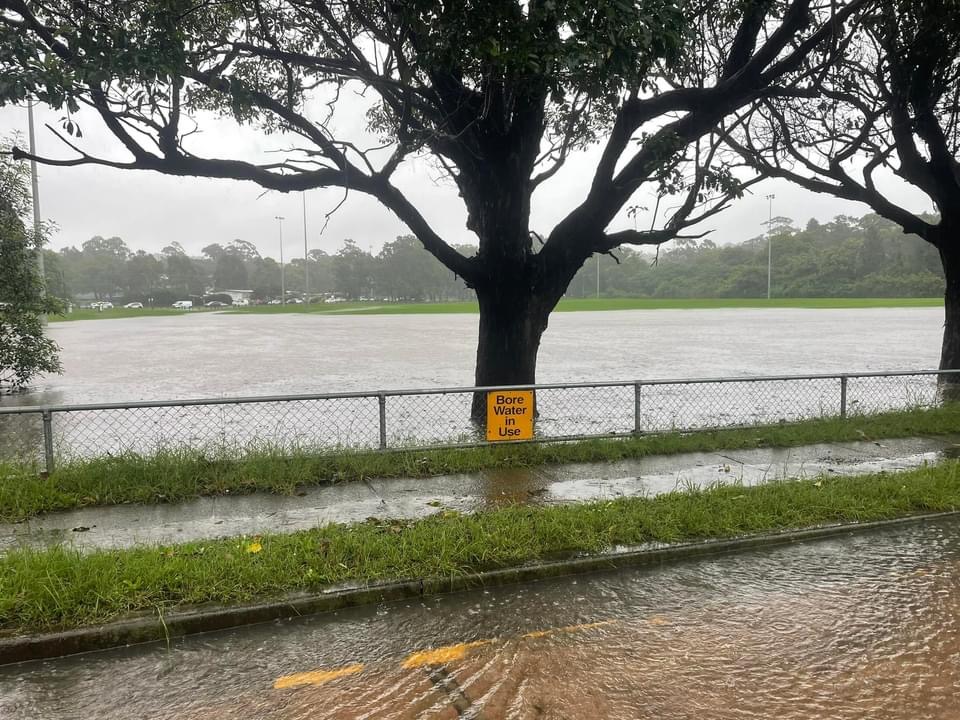
Millers Reserve submerged by water after the heavy rains, March 2022
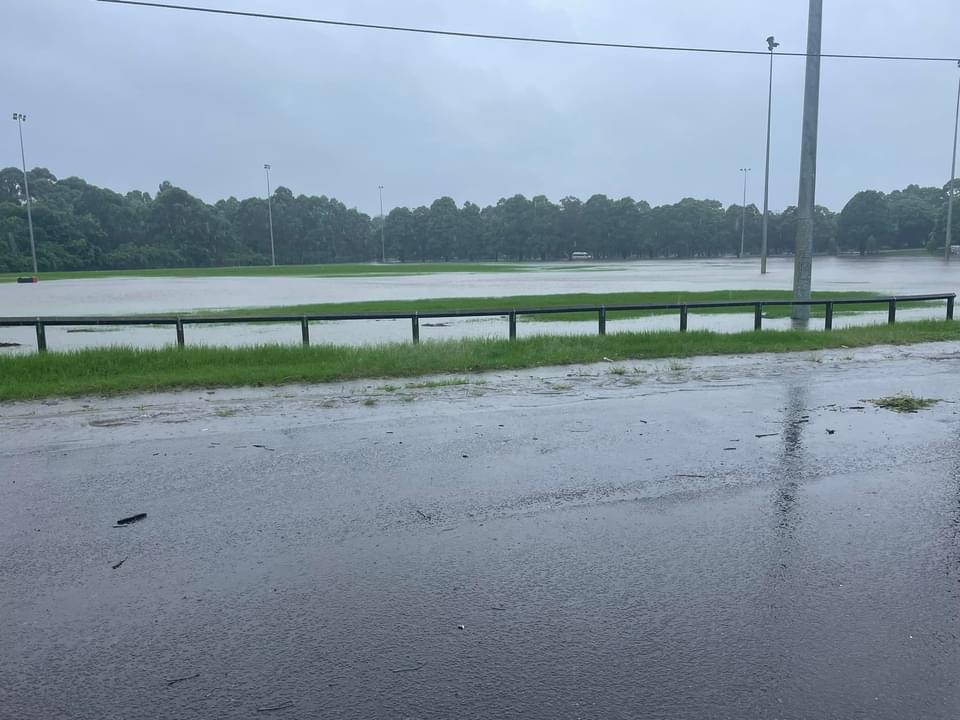
Millers Reserve submerged by water after the heavy rains, March 2022
More on this once the final report is released. Julia's latest video runs below.
Reinstalled Synthetic Field At Cromer Costs 1.3 Million - Field 2 1.45 Million
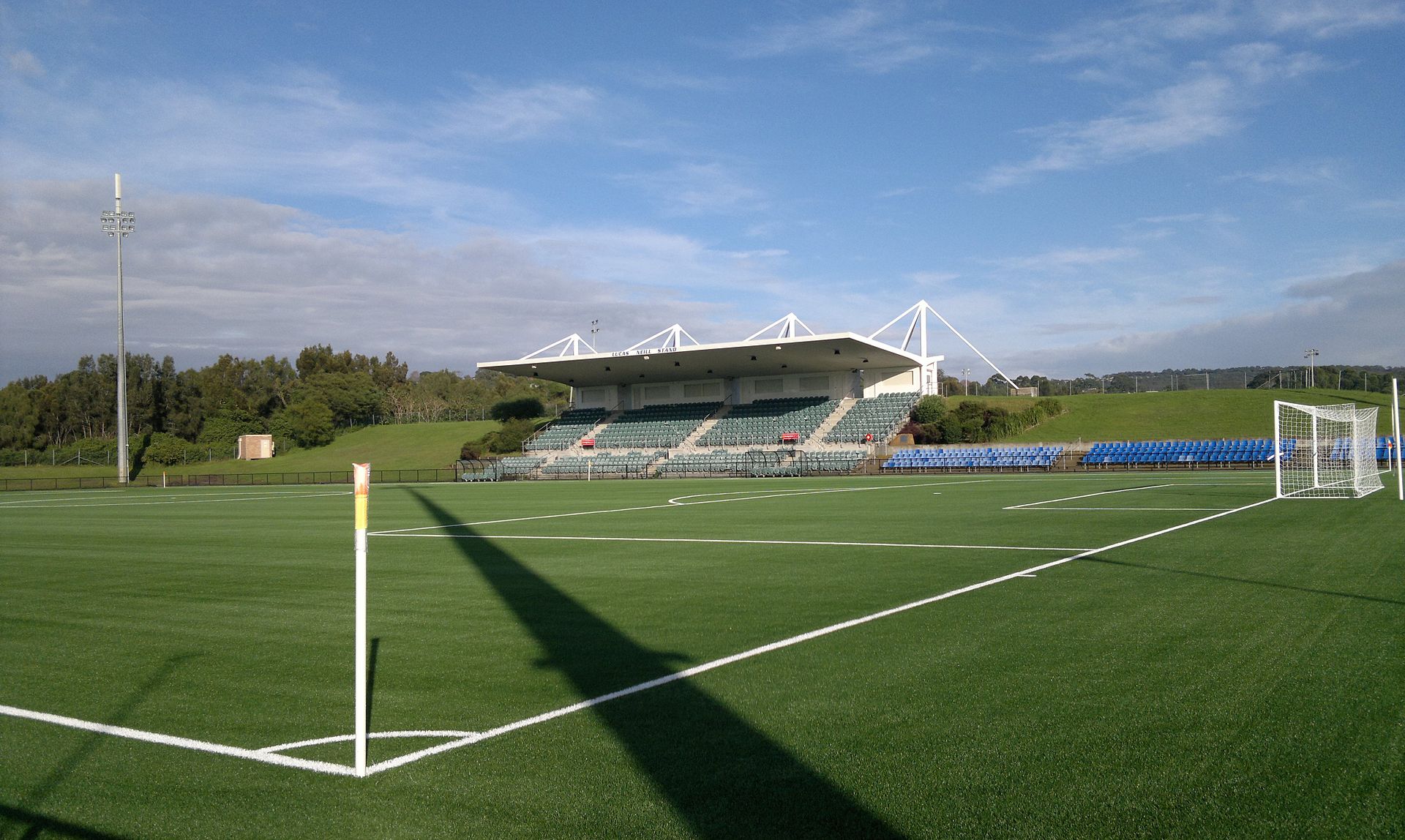
“Having the World Cup on home soil is a once-in-a-lifetime opportunity that will inspire young girls and boys to lace up the boots and emulate their football heroes,” Mr Henskens said.
“With six months to go before the tournament kicks off, there is already an enormous buzz around football and this program will help local clubs capitalise on excitement by running programs that will boost participation in the sport.
“It will also deliver funding to improve infrastructure, creating more modern and accessible facilities for communities across NSW.”
Examples of eligible project types and project components included are listed as:
- New or upgraded synthetic or turf pitches, including improvements to pitch drainage, irrigation or resurfacing.
- Amenity buildings such as kiosks, club rooms, gender neutral change rooms, grandstands, seating, lighting, shade/shelter, or storage spaces that are universally designed.
Staged components of a larger facility development are eligible, providing the stage being applied for meets the fund eligibility criteria.
A Participation Stream forms part of the NSW Football Legacy Fund - Infrastructure Fund.
Synthetic Turf Health - Environment Hazards: EC To Implement Ban On Microplastic Infill For Synthetic Turf Systems
In America city after city is banning the use of synthetic turf or rubber (soft fall) due to the chemical components in these poisoning the environment or the heat they create where installed. A report by 9 News in February 2022 found one field in Sydney reaches up to 88C despite the weather at the time only being 28C.
In the US ground-up tyres used in synthetic turf or rubber 'soft fall' can contain heavy metals, benzene, VOCs and other carcinogens that can present a health threat. The material emits high levels of methane, a potent greenhouse gas, and sheds microplastics and other chemicals into waterways.
This 'soft fall' materials are installed as squash and tennis courts or as the base of children's playgrounds.
The same product of ground up tyres is also being sold in Australia and recommended by installers for use as 'rubber flooring' in children's playgrounds 'to keep them safe'.
In Australia, passenger vehicle tyres contain approximately 16% natural rubber, 30% synthetic rubber, 23% carbon black, 16% metal and 6% textile.
In January 2022 University of Queensland scientists published 'Concentrations of Tire Additive Chemicals and Tire Road Wear Particles in an Australian Urban Tributary'. They had taken water samples from the middle of Cubberla Creek beside Brisbane’s M5 motorway after four storms in late 2020 and found the tyre-derived compound 6PPD-quinone. This same substance has been linked to massive die-offs of coho salmon across the U.S. West Coast.
The levels of 6PPD-quinone in the creek, which feeds into the Brisbane River, peaked at concentrations comparable to those found to be killing Seattle’s salmon. As much as 700kg of tiny tyre particles, up to 0.2mm wide and some much smaller, were estimated to wash off the roads and into the catchment after each storm.
Study lead author, Dr Rauert said they found elevated levels of the chemical for two days after storms.
“The aquatic species living there are going to be exposed [to the chemical] over this period. The amount of tyre wear we found was also very surprising.
“We have no idea of the effect of these particles or if fish are ingesting them. There are so many unknowns in this field. We should be worried, but we need to know more.”
Dr Rauert and colleagues were planning to take samples at other sites throughout Queensland. That research was published in December 2022 as 'Tyre additive chemicals, tyre road wear particles and high production polymers in surface water at 5 urban centres in Queensland, Australia'
Abstract for Concentrations of Tire Additive Chemicals and Tire Road Wear Particles in an Australian Urban Tributary
Tire road wear particles (TRWPs) are one of the largest sources of microplastics to the urban environment with recent concerns as they also provide a pathway for additive chemicals to leach into the environment. Stormwater is a major source of TRWPs and associated additives to urban surface water, with additives including the antioxidant derivative N-(1,3-dimethylbutyl)-N′-phenyl-p-phenylenediamine-quinone (6PPD-quinone) demonstrating links to aquatic toxicity at environmentally relevant concentrations. The present study used complementary analysis methods to quantify both TRWPs and a suite of known tire additive chemicals (including 6PPD-quinone) to an urban tributary in Australia during severe storm events. Concentrations of additives increased more than 40 times during storms, with a maximum concentration of 2760 ng/L for ∑15additives, 88 ng/L for 6PPD-quinone, and a similar profile observed in each storm. TRWPs were detected during storm peaks with a maximum concentration between 6.4 and 18 mg/L, and concentrations of TRWPs and all additives were highly correlated. Contaminant mass loads to this catchment were estimated as up to 100 g/storm for ∑15additives, 3 g/storm for 6PPD-quinone, and between 252 and 730 kg of TRWPs/storm. While 6PPD-quinone concentrations in this catchment were lower than previous studies, elevated concentrations post storm suggest prolonged aquatic exposure. [1.]
Abstract from Tyre additive chemicals, tyre road wear particles and high production polymers in surface water at 5 urban centres in Queensland, Australia
Plastics pollution is a global issue impacting every part of our environment. Tyre road wear particle (TRWP) plastics pollution is thought to be one of the largest pollution sources in urban environments. These plastics are also of concern due to the presence of additive chemicals, incorporated during manufacture, that can be released into the surrounding environment. This study aimed to provide information on concentrations of a range of anthropogenic plastics related pollutants in the Australian environment through a scoping study of surface water in 5 key urban centres around Queensland, Australia. Samples were analysed for a suite of 15 common tyre additive chemicals, TRWPs and 6 common high production polymers, and included the new transformation product of concern 6PPD-quinone which has recent reports of causing mass mortality events in certain aquatic species. The additives were ubiquitously detected (2.9-1440 ng/L) with 6PPD-quinone concentrations lower than in previous studies (<0.05-24 ng/L) and TRWPs detected at 18 of the 21 sites (<MDL to between 690 and 1990 μg/L). Of the high production polymers, polyethylene and polypropylene were detected at the highest concentrations (16-1750 and <0.7-37 μg/L respectively) with profiles highly variable between sites. A traffic related additive profile was determined at 7 sites, which all had nearby traffic related sources. Concentrations of additive chemicals were significantly correlated with average daily traffic volumes (p = 0.006), although concentrations of TRWPs were not correlated. Generally, concentrations were in line with or lower than concentrations in other geographical regions, although it is noted samples were collected during the dry season and further sampling during the tropical wet season would be of interest. [2.]
In September 2022 the European Commission (EC) recommendations for restrictions for the placing of intentionally added microplastics onto the European market (Annex XVII REACH1) recommended a ban on the future sale of microplastic infill for synthetic turf systems as the most effective way to reduce microplastic emissions.
The EC's findings follow research published earlier in 2022 that, for the first time, detected microplastic pollution in human blood, with scientists from the Vrije Universiteit Amsterdam in the Netherlands finding the tiny particles in almost 80% of people tested.
The impact of microplastic pollution in on the body's health is as yet unknown, but researchers found microplastics cause damage to human cells in the laboratory. The effect of microplastics on wildlife has been well documented; a decline in feeding behaviour and fertility, a slow and painful death - even worms change their behaviour when microplastics are present in soil, leading to deterioration of the same and all dependent on it, all that grows from soil.
While the EC legislation will only apply to member nations in Europe, it is expected to impact the use of recycled rubber and plastic as an infill in synthetic sports and playgrounds worldwide.
The deterioration of the recently installed synthetic turf safety surface at Newport Beach show appropriate siting should be considered for these products. If residents prefer their children to fall onto soft sand and grass, and respond in feedback that 'natural' materials be used, they realise or know which may be better for their health, for the environment, for keeping the place cooler and their children safer.
The use of synthetic materials that need to be renewed or reinstalled is expensive. The growing evidence presented through research of the impact on people's health, the environment they live in and the flora and fauna also present, appends another costing in discussions of the use of, and siting for products such as cement and synthetic turf or rubber 'soft-fall' matting in public spaces, especially if this is made from old tyres.
Newport's Outdoor Youth Space is popular with youngsters and oldsters, a great facility for these 'us too' residents and a credit to the work council has accomplished. The few holes now apparent, in the view of what is already here due to our careless disregard for the environment, and the hole now visible in one of the materials used, could easily be mitigated. More trees and less concrete and sandstone blocks would cool it down, more grass and sand to remove the poisons and keep the 'soft' safety element in would fit back in with the natural whole cycles.
There's a hole in the bucket...
- Rauert, Cassandra; Charlton, Nathan; Okoffo, Elvis D.; Stanton, Ryan S.; Agua, Alon R.; Pirrung, Michael C.; et al. (2022): Concentrations of Tire Additive Chemicals and Tire Road Wear Particles in an Australian Urban Tributary. ACS Publications. Collection. https://doi.org/10.1021/acs.est.1c07451
- Rauert C, Vardy S, Daniell B, Charlton N, Thomas KV. Tyre additive chemicals, tyre road wear particles and high production polymers in surface water at 5 urban centres in Queensland, Australia. Sci Total Environ. 2022 Dec 15;852:158468. doi: 10.1016/j.scitotenv.2022.158468. Epub 2022 Sep 6. PMID: 36075411. DOI: 10.1016/j.scitotenv.2022.158468
Saving Pittwater From The Chainsaws: Community Forum At Warriewood - Thursday February 2nd 2023, At 7pm + 'Concreting Our Coast: The Developer Onslaught Destroying Our Coastal Villages And Environment' Report Released
Protecting Pittwater's spectacular environment from inappropriate development will be the focus of a public forum featuring Greens NSW MP Cate Faehrmann on February 2nd.
Pittwater Greens Councillor Miranda Korzy said the forum will look at how we can strengthen and enforce local planning and development rules.
“Many of us in Pittwater are distressed by the all too common sound of chainsaws destroying our trees and massive excavations for modern mansions,” Ms Korzy said.
“This forum is for those of us who still treasure the vision of Pittwater as a collection of villages connected by the bush, beach and water,” Ms Korzy said.
Speakers, including Environment and Planning lawyer James Ryan, will discuss problems with NBC’s Conservation Zones Review, its new Local Environment Plan, Development Applications and the NSW government’s planning regime.
It will take place on February 2, 7pm - 9pm, in the Angophora Room, Nelson Heather Centre, at 5 Jacksons Rd, Warriewood.
The Council's recent Conservation Review ignored the Pittwater Council's 60/40 ruling for Environmentally sensitive blocks in Pittwater, and 50/50 for all others, as in the Pittwater 21 Development Control Plan (DCP). Planners told councillors they estimate that in the former Pittwater LGA, 3,613 properties will move from a Conservation zone to an R (residential) zone, and 1,328 from an R zone to a C zone, resulting in an overall loss of 2,285 properties from C zones.
The former Manly LGA will lose just 54 properties from the C zone while the former Warringah will lose just 1.
Residents state this document has been drafted so a new DCP will fit in with what occurs in the former Warringah Council area.
''The 'Warringah methodology and formulas' are already being seen in over the height limit and filling the whole block developments being passed by council show little knowledge of or respect for what was formulated by residents and adopted for Pittwater by Pittwater Council. It's as though this approach commenced as soon as the amalgamated councils did and everything else other than Warringah council practice and approach was thrown out.''
Residents state that DA breaches have had a very detrimental effect, including:
- an accumulative loss of local native flora and fauna, many of it endangered (one report suggests a devastating loss of 19,650 trees from DAs alone since 2018, many mature local natives); and
- an addition of ugly, monster homes (many breaching the 8.5 metre height, some by more than a whopping 40%) - and other developments which do not fit the local character of the area.
Many of the breaches concern clear cut rules such as the 60:40 rule under C1.1 Landscaping, 4.3 Building Height, 7.6 Biodiversity, B4 Controls Relating to Natural Environment, B3 Hazard Controls and B5 Water Management, along with breaches of not blocking out the view of the public along our coasts and waterways, C1.3.
Trees that are required to be retained suddenly die, some poisoned deliberately, some with their roots flooded until they fall over.
In every suburb and every street plans with height breaches, to fill the whole block with concrete, to remove all vegetation or hillside, are passed by the council.
Along with the required by State Government housing densification, drafted and passed by the Northern Beaches Council, the destruction of what many love about Pittwater is already taking place and scheduled to be increased.
filling the block at Bilgola - photo taken January 2023. Photo supplied
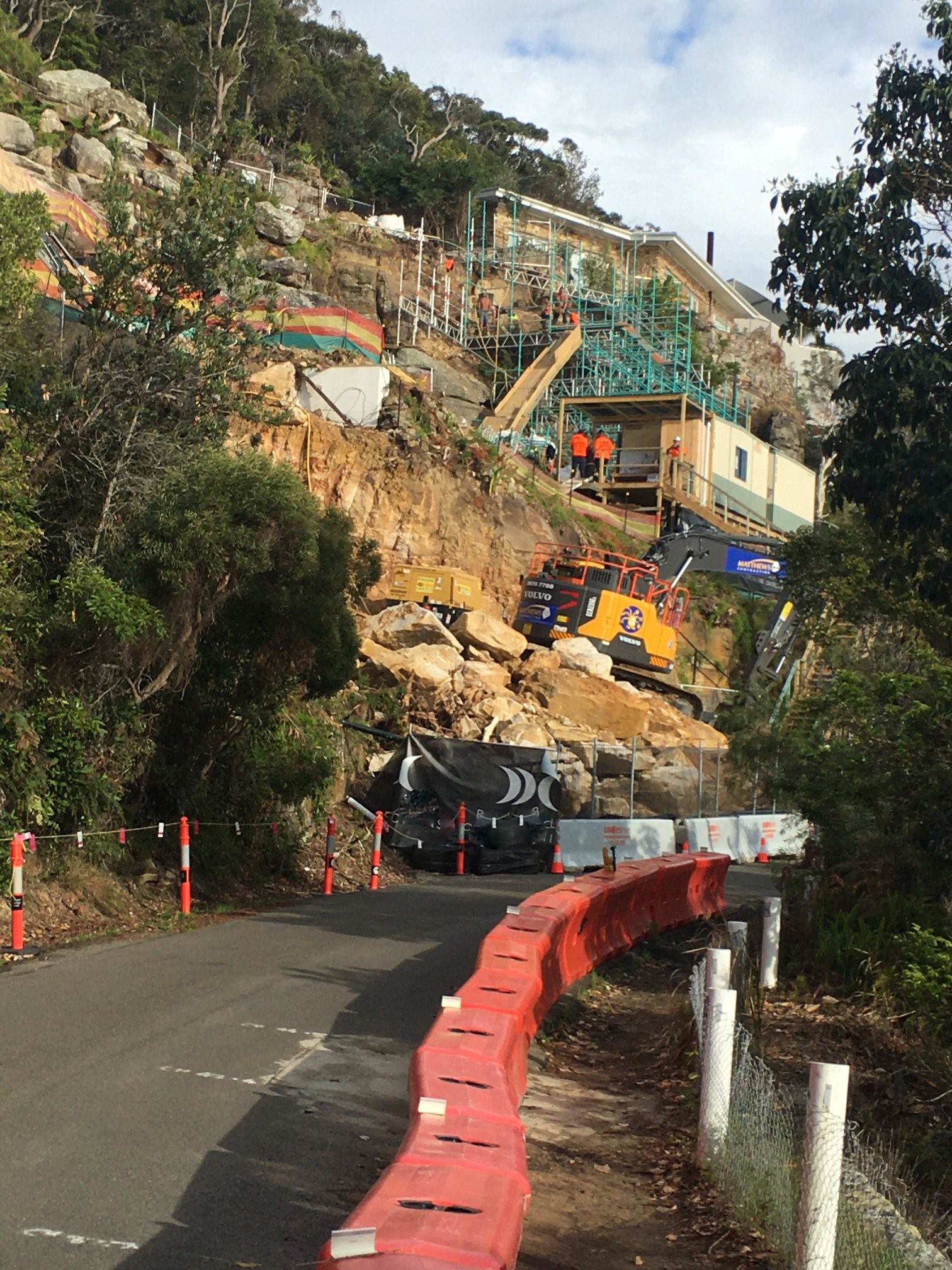
razing the hillside at Palm Beach. Photo supplied

every single tree removed from this site of a 3-storey development at Newport. Photo supplied
The 'Desired character of Pittwater' in the finalised 21DCP states:
Any future growth of Pittwater must conserve, protect and enhance the natural environment and beauty of the area. Development will need to be ecologically sustainable and considerate of the natural hazards of the area that have helped to shape the region, which will ensure a safe and good quality of life for the community and future generations.
Pittwater will remain water orientated with recreational use of the waterways and public access to these waterways being actively promoted. Improved access by both pedestrian and cycle paths needs to be provided around the waterways and through the area. The built environment shall not extend above existing ridgelines, and shall remain below existing tree canopy levels.
The environmental objectives of this DCP are to:
a)conserve and enhance the ecological integrity, biodiversity, wildlife corridors, aquatic habitats, water quality, environmental heritage and environmental significance of Pittwater;
b) maintain the natural beauty of the area by retaining natural landforms, minimising land excavation and fill, and by minimising erosion, pollution and other forces that may impact on the landscape;
c)prescribe limits to urban development having regard to the potential impacts of development on the natural environment, natural hazards, and the provision, capacity and management of infrastructure; and
d) plan, design and site development to achieve the principles of ecologically sustainable development
As well;
Future development will maintain a building height limit below the tree canopy, and minimise bulk and scale.
Natural scenic views from the Bicentennial Walkway will be preserved.
Pittwater 21DCP - updated in 2015 to include heritage conservation areas like Ruskin Rowe, Avalon Beach
Pittwater 21DCP 2014 - wildlife and spotted gums
Pittwater 21DCP 2014 - the 60/40 and 50/50 plan and rules
The phrase 'enhance wildlife corridors' is repeated for each location throughout the document. Fences, where needed, are also to enable wildlife to pass through them as a place steeped in so much retention of native vegetation across urban blocks makes these wildlife corridors as well, at tree canopy level and at grounded shrub and grass level.
At the 2022 LGNSW a Motion to address the loss of wildlife in blocks submitted for development was passed - but has not, as yet, been ratified at NSW State Government level. In fact, the incumbent government is still passing approvals to raze Listed critically endangered woodlands and species - such as Sydney's Koalas. An overview of that long overdue structure is available in the October 2022 report:
Such a standard would include requirements for:
- Pre-clearance surveys to be carried out to establish which species are present on the site, including identification of any threatened and native species.
- The identification of suitable nearby areas where wildlife could possibly be relocated.
- The provision of possum, glider and bat boxes sufficiently in advance of vegetation clearing to allow wildlife time to discover the boxes and become familiar with them.
- Compliance with the NSW Code of Practice for Injured, Sick and Orphaned Protected Fauna and the licencing requirements contained in the Biodiversity Conservation Act 2016.
- Best practice for wildlife handling and care (including contact with local wildlife rescue groups).
- Reporting of injured or killed fauna to the NSW Department of Planning, Industry and Environment to enable the data to be used in statewide biodiversity monitoring programs.
The premise of this is that mandatory pre-clearance surveys to establish what wildlife lives there before works commence, and to document this in a formal way, should be required on any site that has vegetation and for which a DA has been approved. The experience is that often vegetation is removed before an application is submitted, often leaving wildlife with no home. Wildlife then ends up on roads dead or dies after being displaced/evicted. More in: Ringtail Posse 2023: The Generation Witnessing An Extinction Of Urban Wildlife
The 2014 Pittwater 21 Development Control Plan (DCP) itself has been modified since Pittwater Council was subsumed into what many residents now call the 'Greater Warringah' council. Some of these changes were made prior to the first election for Northern Beaches Councillors on September 9th 2017, when Pittwater's representation was reduced to 3 Councillors for a 'Pittwater Ward' out of 15 overall, after Pittwater Council was dismantled by the State Government and forcibly amalgamated with Warringah and Manly in March 2016.
Those changes to Pittwater Council's DCP include:
Date Adopted - Date in Effect
- 27 June 2017 8 July 2017: Removal of Preliminary Section and Repeal of Notification Policy (Appendix 1)
- 26 July 2017 7 August 2017: Harmonisation of Flood controls across all three DCP's. Removal of Appendix 8 and Appendix 15.
- 22 8 August 2017 28 August 2017: Harmonisation of Tree and Bushland Vegetation control across all three DCP's. Addition of Appendix 16-19.
- 19 Dec 2017 13 Jan 2018: Changes made to Control C6.11
- 25 Sept 2018 20 Oct 2018: Tree and Waste Management amendments made to A1, A5 B4.22, C1.12, C2.9 and C3.10
- 26 Nov 2019 1 Dec 2019: Removal of Section A.5 Exhibition, Advertisement and Notification of Applications to give effect to the Northern Beaches Community Participation Plan
These changes to the do not include, as yet, include amendments by the State Government to the Pittwater Local Environmental Plan 2014:
Standard Instrument (Local Environmental Plans) Amendment (Land Use Zones) Order 2021 (650) (amended by Standard Instrument (Local Environmental Plans) Amendment (Land Use Zones) Order 2022 (726)), Sch 3 (not commenced — to commence on 26.4.2023). See also: Planning Legislation Amendment Bill 2019.
The response to the Northern Beaches Council allowing serious breaches of the LEP, DCP and EP&A Act has seen community groups such as the Pittwater Environmental Heritage Group launched, and the Ku-Ring-Gai GeoRegion: A New Concept In Landscape Conservation and UNESCO Proposal being advanced.
At the October Pittwater Community Forum regarding the proposed 'one size fits all Rezoning' a number of Resolutions were passed that would see a lot more trees left standing and a lot less overdevelopment in inappropriate areas, such as known flood zones, or oversized and over height limit concrete filling the whole block with every skerrick of habitat razed from the same.
Mona Vale Residents Association member Marcia Rackham spoke to the Northern Beaches Council Meeting held in October 2022, presenting the Resolutions that stemmed from that Community Forum. That address was:
Presentation of Resolutions to Council. Draft Review Conservation Zones Pittwater LGA.
I would like to begin by acknowledging the Garigal people on whose land we are conducting this meeting this evening and pay my respects to ancestors past, present and emerging.
On Sunday 16th October a planning forum was held in the Memorial Hall in Mona Vale to high light and discuss the proposed changes to land zoning in the Pittwater local government area. This was a very well attended meeting and was supported by the following 11 Pittwater interest groups:
- Bayview and Church Point Residents Assoc
- Canopy Keepers
- Church Point Friends
- Clareville and Bilgola Plateau Residents Assoc
- Mona Vale Residents Assoc
- Palm Beach Protection Group
- Pittwater Environmental Heritage Group
- Pittwater Community Alliance
- Pittwater Natural Heritage Assoc
- West Pittwater Community Association
- and the Palm Beach/ Whale Beach Assoc.
The purpose of the forum was to try and get a better result for Pittwater from the review in terms of nature conservation, protection of visual quality and scenic character of the natural and built environment, into the future for the Pittwater LGA.
We had several speakers and had some distinguished guests for our Q and A panel. What was evident during the meeting was just how confused people are about the proposal to re-zone vast parcels of land throughout the suburbs of Pittwater from a conservation zoning into an R? zone. I have used the term R? purposefully as it is unclear what R zoning, we have the potential to move into if reclassified. Many in the Pittwater community have no idea this is happening. Only seven years out from a very up to date LEP council is wishing to change the rules again. It was very evident when comparing mapping for the now three combined councils that Pittwater was rich in conservation zones. These proposed changes to conservation zoning will tip the balance heavily into residential zoning along ridgelines, steep sloping land, canopied forests all contributing to areas that possess bucket loads of scenic beauty. Scenic beauty that has been completely omitted from the review yet is the very essence of the Pittwater LGA.
We understand that residents can book an onsite visit from council to inspect their property prior to the review being finalised but it is unclear on the “your say” page as to how this can be arranged, surely an oversight on council’s part.
The criteria that council has set for conservation zones is also hotly contested by the community. We consider the methodology to be flawed. Has council really considered what the implications could be for the community of Pittwater if things that we value so highly are downgraded to the degree that they have been in the draft review. And why change a zoning from Environmental living to conservation when the former classification in many instances is a much better fit.
Out of our forum the following three resolutions were recorded all with an overwhelming majority.
Resolution 1.
That the medium Environmental value criteria that form the basis of the conservation zones review should be changed as follows:
- Biodiversity Corridor and urban tree canopy be given a High Environmental Value.
- Ridgeline or Escarpment given a High Environmental Value
- Geotechnical Planning Class: C3 Hawkesbury Sandstone with slope >25 degrees or C5 Narrabeen Group with slope >15 degrees be included in Hazard criteria.
Resolution 2.
We the residents of the Northern Beaches Council area, believe the bushland landscape of the former Pittwater Local Government area is its predominant feature. With the built form secondary, and that this must be maintained in the future local environmental plan and development control plan.
We therefore call on NBC, in the former Pittwater area, to:
- Rule out rezoning of C4 land to residential.
- Apply conservation zonings to properties where any significant environmental values or hazards are present.
- Create scenic foreshore protection areas from shorelines to ridges.
- Retain all heritage conservation areas and investigate those proposed- but not yet implemented- by the former Pittwater Council.
Resolution 3.
This meeting strongly objects to the proposed reduction in the numbers of properties in Conservation Zones in the area of Pittwater ward within Northern Beaches Council LGA.
Such rezoning will enable a greater level of development and consequent reduction in native flora and fauna, green space and the unique natural character of the Pittwater area.
We ask that all candidates for Pittwater in the coming State election declare their position on:
- The proposed changes to conservation zones.
- The establishment of a scenic foreshore protection area.
- What planning controls they will support to address our concerns.
Thank you.
On Thursday February 2nd 2023, at 7pm the public forum titled 'Saving Pittwater from the Chainsaws' will be held in the Angophora Room, Nelson Heather Centre, 5 Jackson Road Warriewood.
The organisers ask; ''Do you want Pittwater to remain “a series of villages connected by bush, beach and water”? If so, please join us for a discussion about how we can strengthen and enforce our local planning and development rules.
Join Greens MP Cate Faehrmann, planning and environmental lawyer James Ryan and Northern Beaches Councillor Miranda Korzy to learn more about issues related to the new Northern Beaches Local Environment Plan, Development Applications and the NSW government’s planning regime.''
This is a Free event. Residents can reserve their spot: www.eventbrite.com/e/saving-pittwater-from-the-chainsaws-tickets-517387408667
Concreting our coast: New report released
In related news, on Thursday January 19th Greens MP and planning spokesperson Cate Faehrmann released a report, 'Concreting our Coast: The developer onslaught destroying our coastal villages and environment'.
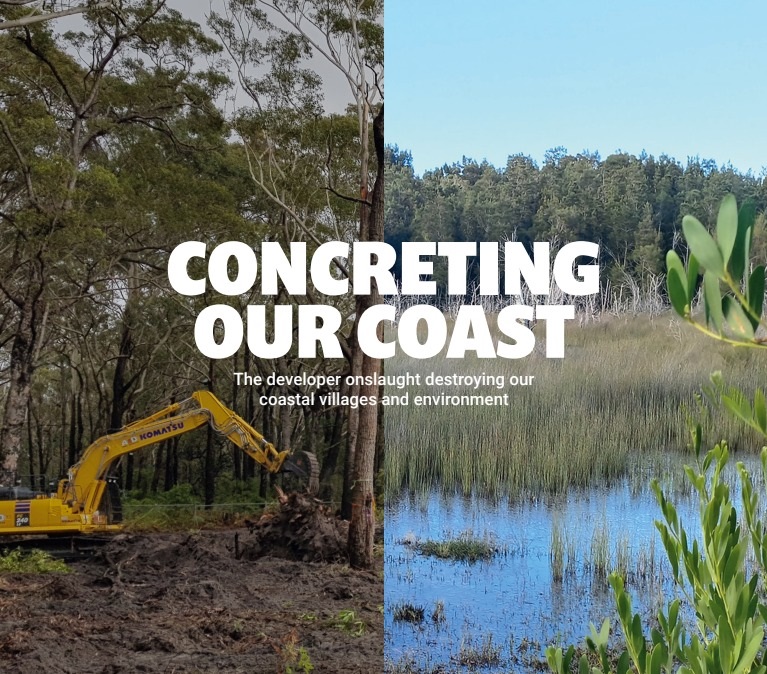 The 40-page report documents 20 case studies from the length of the NSW coast. of new housing developments that pose a serious cumulative threat to bushland, wildlife and coastal villages.
The 40-page report documents 20 case studies from the length of the NSW coast. of new housing developments that pose a serious cumulative threat to bushland, wildlife and coastal villages.
“In town after town, community groups are fighting damaging and inappropriate developments that threaten to overwhelm their already struggling local services and infrastructure, and wipe out much of the precious bushland that surrounds them,” said Cate Faehrmann.
“This report shows just how scary the big picture is. The NSW Liberal-National government has given developers the green light to bulldoze thousands of hectares of bushland for development. Everywhere you look, our precious coast is about to disappear under a layer of concrete and houses crammed together like sardines.
“We’re not talking about a couple of small bush blocks here. We’re talking about the destruction of very environmentally sensitive areas, as well as Aboriginal cultural heritage, on a massive scale. If it’s not stopped, our beautiful NSW coast will be unrecognisable in a matter of a few short years.
“Much of the bushland destined to be clearfelled on the South Coast is the last remaining habitat for wildlife after the Black Summer fires. Greater gliders, glossy black cockatoos, swift parrots, powerful owls - these animals have nowhere left to go, and the sheer scale of all of these developments could well push them to extinction.
“The report also shows that many of the new developments are planned on floodplains and wetlands, or in areas of high bushfire risk.
“There is no way we should be building homes in these risky locations. The last four years have shown just how much the climate crisis is affecting our homes, with more and more extreme weather events.”
“Many of these proposed developments are off the back of ‘zombie DAs’ that were approved decades ago avoiding any need to undertake the type of environmental or cultural heritage impact scrutiny required today,” said Ms Faehrmann.
More than 25 local community groups, many which formed to fight these developments, have signed onto a set of Framework Principles to Save our Coast.
Claire Haywood from the Culburra Residents & Ratepayers Action Group said,
“There is other already cleared land available in the Shoalhaven region that is not prone to flooding and closer to existing infrastructure that could and should be developed to assist with the housing shortage.
As a coastal village, Culburra does not have the infrastructure in terms of roads and facilities to support a permanent threefold increase in population.
When you have 80 per cent of Shoalhaven bushland burnt to the ground, any future coastal land development must be done in a responsible and respectful manner to everyone who shares that land.''
Cat Holloway from the Callala Environmental Alliance has said
''The 40ha in Callala Bay slated for development is diverse Coastal Lowland Forest, a habitat type designated as “critically endangered”.
More than 1000 submissions opposed the development plan on environmental grounds - more than 97% of the community spoke out against this destruction of Greater Glider and other threatened species habitat.
People need affordable homes, near jobs, transport, health facilities and infrastructure. We don’t more overpriced real estate and expensive rentals. We don’t need more dangerous traffic, more polluted waterways or more properties at risk from bushfire.''
Coupled with the pre-Christmas 2022 announcement by the State Government of the NSW Reconstruction Authority Corporation Formally Announced - Has Powers To Acquire and Develop Land: Potential Local Implications, it becomes clear that Pittwater is not standing along in trying to protect what attracts so many visitors and why so many choose to live here.
Image: Concreting our Coast report cover.
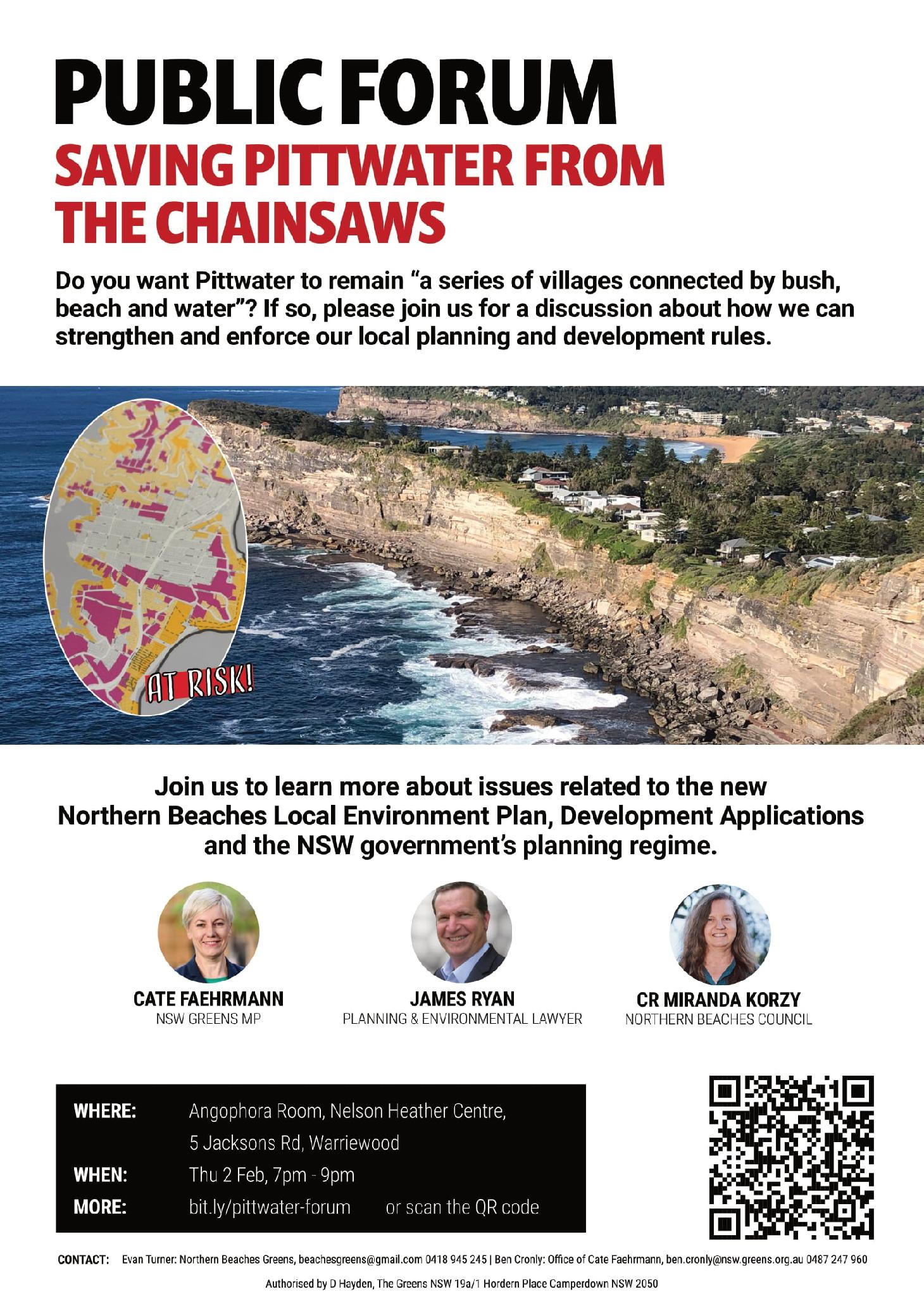
NSW Labor - Independents Commit To Serious Koala Protection: Candidate For Manly Visits Forests-Candidate For Pittwater States We Must Save Habitat
Friday January 20, 2023
Key independent MPs and candidates took to NSW State Forests today to shine a light on the need for forest protection ahead of the upcoming New South Wales election.
MPs Justin Field (MLC) and Sue Higginson (MLC) were joined by candidates Joeline Hackman (Independent for Manly), Karen Freyer (Independent for Vaucluse) and Liza Butler (Labor - South Coast) on a visit to native state forests which are earmarked for logging.
The tour included logged and unlogged parts of the biodiversity rich Boyne, Benandarah and Brooman state forests, which are home to large populations of endangered species including the swift parrot and the southern greater and yellow-bellied gliders.
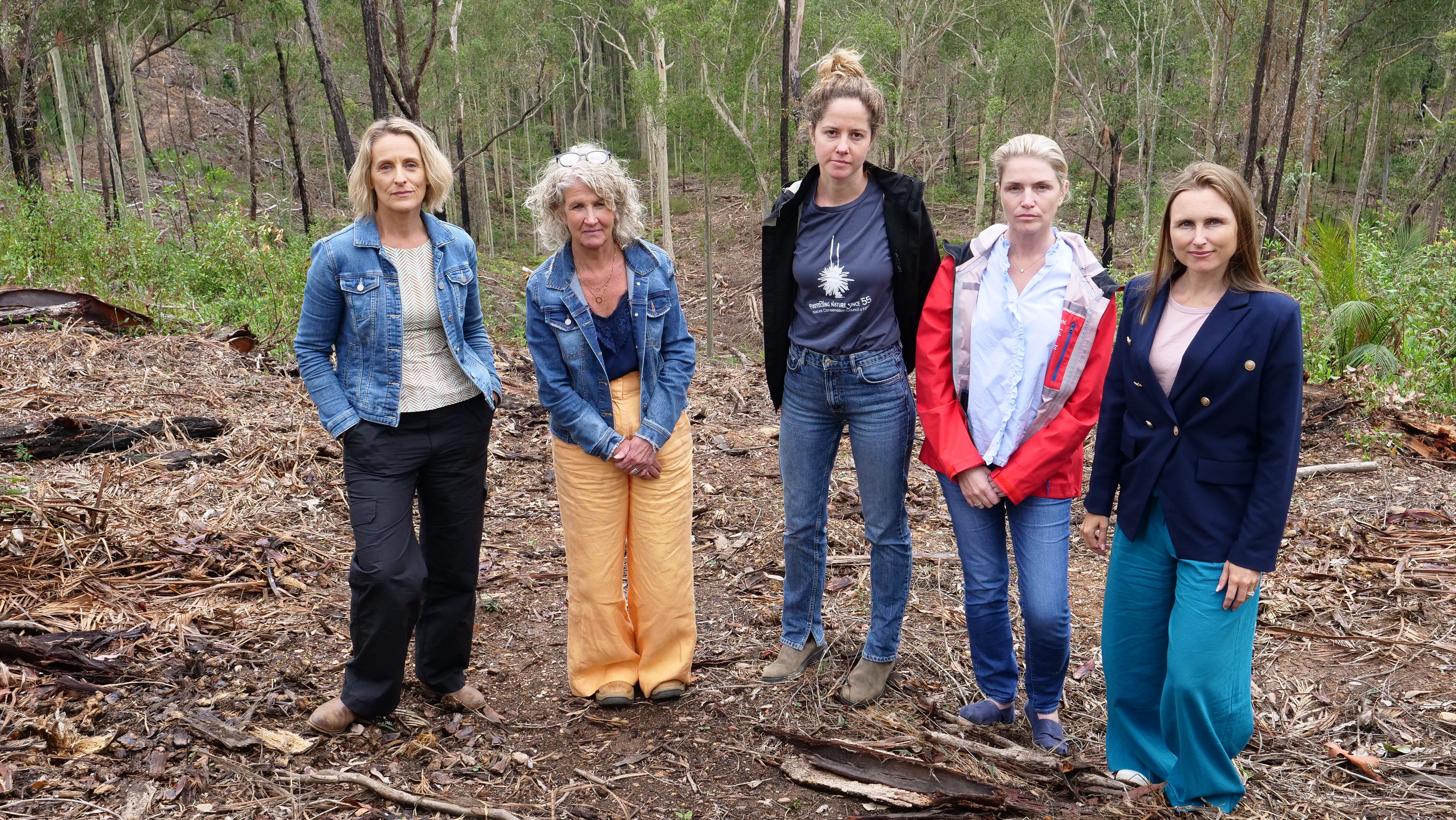
(From L to R) Sue Higginson, Liza Buttler, Jacqui Mumford, Karen Freyer and Joeline Hackman in Benandarah Compartment 109. Photo supplied
The field trip was organised by the Nature Conservation Council of NSW to draw attention to the 14,000 hectares of incredible native state forest which are destroyed each year by government approved logging.
NCC Chief Executive Jacqui Mumford says forest protection will be a defining issue at the election on March 25.
“Voters want an end to native forest logging. They don't want to live in a state where iconic wildlife like the koala and the Gang-Gang Cockatoo are driven to extinction by political inaction.
“Nor is there any economic argument to continue native forest logging, given plantation forests already provide 90% of New South Wales timber production.”
Manly independent Joeline Hackman says the major parties are on notice not to ignore the wishes of voters.
“What we saw today in the great forests of the South Coast are areas of outstanding environmental value.
“No matter where people live in New South Wales, they want these beautiful forests preserved for generations to come,” said Ms Hackman.
Independent candidate for Pittwater Jacqui Scruby has voiced her opposition to the continued destruction of wildlife habitat since announcing her bid for the local seat.
Vaucluse independent Karen Freyer says today’s visit reinforced the urgent need to protect our ancient native forests.
“The community cares deeply about the destruction of forests and the clearing of important koala habitat.
“If we learned one thing from last year’s federal election, it's that voters are sick and tired of being taken for granted. They want an end to logging and a much better deal for our precious wildlife.
“We have no more time to waste,” said Ms Freyer.
The Nature Conservation Council of NSW, the state’s peak environment organisation, has also welcomed Labor’s Plan to Save Koalas, announced on Thursday January 19th.
''After 12 years and six environment Ministers this Government has overseen the decimation of our Koala population.
We will take the action needed to turn this grim trajectory around, creating a Great Koala National Park that will home 20% of our state's koalas, while also protecting the places koalas live, and working closely with all stakeholders to ensure we bring these incredible creatures back from the brink.'' NSW Labor leader Chris Minns stated
NCC Chief Executive Jacqui Mumford says the plan represents serious and overdue action to address the most pressing threat facing koalas in our state.
“Loss of habitat is the number one reason koalas are being driven towards extinction in NSW.
“This plan is what koalas need, because it contains concrete actions to address that threat.”
The NCC is demanding the Coalition match Labor’s commitments, namely the establishment of the Great Koala National Park and reigning in excessive land clearing.
“Treasurer Matt Kean said he would double koala populations, yet koala habitat continues to be logged and cleared at a terrible rate, says Ms Mumford.
“Labor and independent candidates are presenting strong environmental commitments to voters, so the Coalition can’t afford to take a koala policy written by the Nationals to this election.”
Nature Conservation Council is calling on all parties to deliver:
- An end to native forest logging and transition to a 100% plantation-based timber industry, and
- Assessment, mapping, and protection of koala habitat across the state on public and private land.
The announcements on Friday came the same day community group Save Sydney's Koalas were notified NSW Planning Minister Anthony Roberts had responded to their petition, signed by over 20 thousand NSW residents.
''The NSW Government has issued a response to our 20,000+ E Petition. We note that they did not allow time for it to be debated in the NSW Parliament.
They are not saving the Koalas of south west Sydney.
They are not following the advice of the NSW Chief Scientist but instead have watered it down to a meaningless form. Instead of 6 east west corridors there will be just one or two, neither will be 350 metre wide minimum, despite him being able to rezone to deliver the widths.
Anthony Roberts disinterest is reflected in the opening paragraph where he states that Koalas are Vulnerable in NSW. Koalas have been listed as Endangered in NSW since February 11th 2022.'' a spokesperson for the group states.
''We have had to fight for any improvements to corridor number, widths, undercrossings on Appin Rd - its been relentless for us and we are grateful for the wide public support we ( the Koala) receives as we continue to advocate for habitat.
This picture is perhaps the easiest way for people to see what is going to happen in south west Sydney, this is the critical east west wildlife corridor between the Georges and Nepean Rivers at Mount Gilead also known as the Lendlease development.
Developers include the NSW Government, Landcom at Airds cutting the Smiths Creek corridor, Walkers at Appin, Inghams at Tahmoor and Appin, Country Gardens at Wilton etc. etc.
This is just the beginning of the land clearing and habitat loss the Koala and over 278 Threatened Species will face in areas such Campbelltown, Appin, Liverpool, Wilton.
It is not too late but clear that the NSW Government has failed the Koala of SW Sydney, all the green towards the Blue Mountain will be cleared unless significant changes are made.''
Australian Ethical has echoed Saving Sydney's Koalas findings.
In December 2022 they stated ''Australian Ethical has been working hard behind the scenes to ensure that the native koala colony is not negatively impacted. But we’ve hit a roadblock. If Lendlease proceeds with the Mount Gilead Phase 2 development as currently proposed, we will sell our shareholdings in Lendlease.''
The $8 billion investment fund states, ''On 21 November 2022, the NSW Government exhibited plans for Phase 2 development as part of its public consultation, which closes on 19 December.
The NSW Government had foreshadowed that it would publish mapped koala corridors for the Gilead development, showing how the average widths were calculated, but it has failed to include this information as part of its public consultation. Without this key information, there is no way for Australian Ethical or conservation groups to assess with any confidence whether the corridors will allow koalas safe passage through the site.
The corridors are needed to ensure koalas have east to west connection across the site; and to ensure the Nepean River koala corridor does not become a functional dead end at Mount Gilead.
While our engagement with Lendlease to date has been largely constructive we continue to be concerned that the development will have a net negative impact on koalas.
Today, we have made a public statement calling on the NSW Government and Lendlease to be transparent about their calculations of the width of the koala corridors, to give AE and others the ability to take part in a genuine consultation on this important issue.
Our statement makes clear that unless this information is provided, we cannot have assurance that the koalas will be sufficiently protected. If Lendlease proceeds with the Mount Gilead Phase 2 development as currently proposed, we will sell our shareholdings in Lendlease.'
In reply Lendlease has stated, 'We have engaged with Australian Ethical over a number of years to share our plans for the project, which fully adhere to the independent and expert recommendations of the NSW Chief Scientist.
Our $35 million investment into conservation at Gilead includes creating koala corridors that have been independently assessed as meeting the recommendations of the Chief Scientist in terms of width and connectivity.
A map outlining the corridors has been published on the NSW Department of Planning and Environment’s website. In addition, the Department has published the scientific recommendations and policy that support these corridors, and the methodologies for how they are calculated and mapped.
Our conservation investment also includes plans to increase core koala habitat by 70 hectares – 30 per cent more than what’s there today. And it includes improving road safety on Appin Road, a known blackspot for koala fatalities.
Every conservation measure we have proposed is fully funded and follows the advice of the Chief Scientist’s panel of independent koala experts. By following this advice and investing in conservation, local koalas will have the best opportunity to thrive at Gilead. At no time during project delivery will there be less core koala habitat than there is today.
Australian Ethical’s inference that the public exhibition lacks transparency for koala corridor calculations is demonstrably incorrect given the extensive information that has been published.
The fragility of Australia’s biodiversity is an issue of national significance, and we are acutely aware of our ethical and environmental responsibilities. We remain steadfast in our plans to meet and where possible exceed all of the Chief Scientist’s recommendations for koala conservation as we help address the critical shortage of new and affordable homes in Sydney.
Lendlease recently responded to Australian Ethical’s concerns and our response can be viewed here. The NSW Department of Planning & Environment advice is publicly available here. The full documentation submitted with the rezoning proposal can be found at this website: https://pp.planningportal.nsw.gov.au/ppr/under-exhibition/gilead-stage-2 '
However, as many groups as well as individuals have pointed out, including Australian Ethical regarding this single development; 'The NSW government has confirmed that the corridors will meet the minimum requirements, but we do not think Government endorsement of Lendlease’s plans gives sufficient certainty. There is some ambiguity in how the Panel’s recommendations should be interpreted and applied. And successive governments have failed to prevent the decline of native species, including koalas.'
With so many others tabled by the current State Government as both proposer and approver, it is clear that thousands of hectares of habitat are slated for destruction, action that will kill all that lives there and calls these places 'home'.
More in previous reports:
- Finalised Cumberland Plain Plan Released: 'A Developers Plan That Will Facilitate Extinction Of Sydney's Koalas' Locals State - A 'Tree Museum Plan' For Critically Endangered Woodplain
- Residents Rally For Koalas At Manly On Save The Koala Day: Calls To Prioritise Wildlife, Stop Clearing Habitat
- NSW Reconstruction Authority Corporation Formally Announced - Has Powers To Acquire and Develop Land: Potential Local Implications
- Koalas Now Listed As Endangered In NSW - Qld - ACT
- Senior Liberal Party Member Catherine Cusack Crosses Floor To Save Koalas
Paradise Beach: Pittwater
January 16, 2023, 9.30 am - low tide
Great Mackerel Beach: Pittwater
January 18, 2023, 9.30 am - low tide
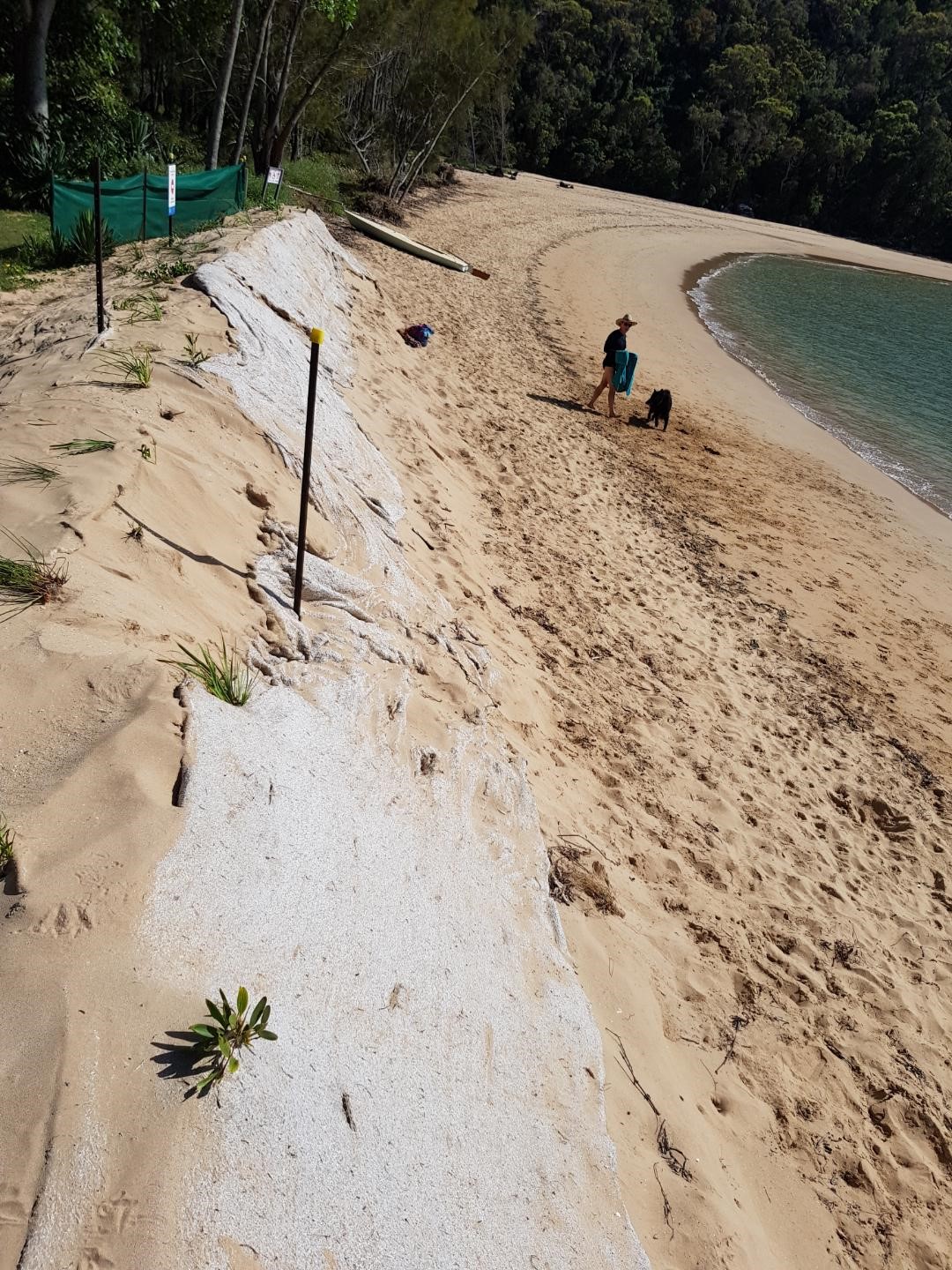
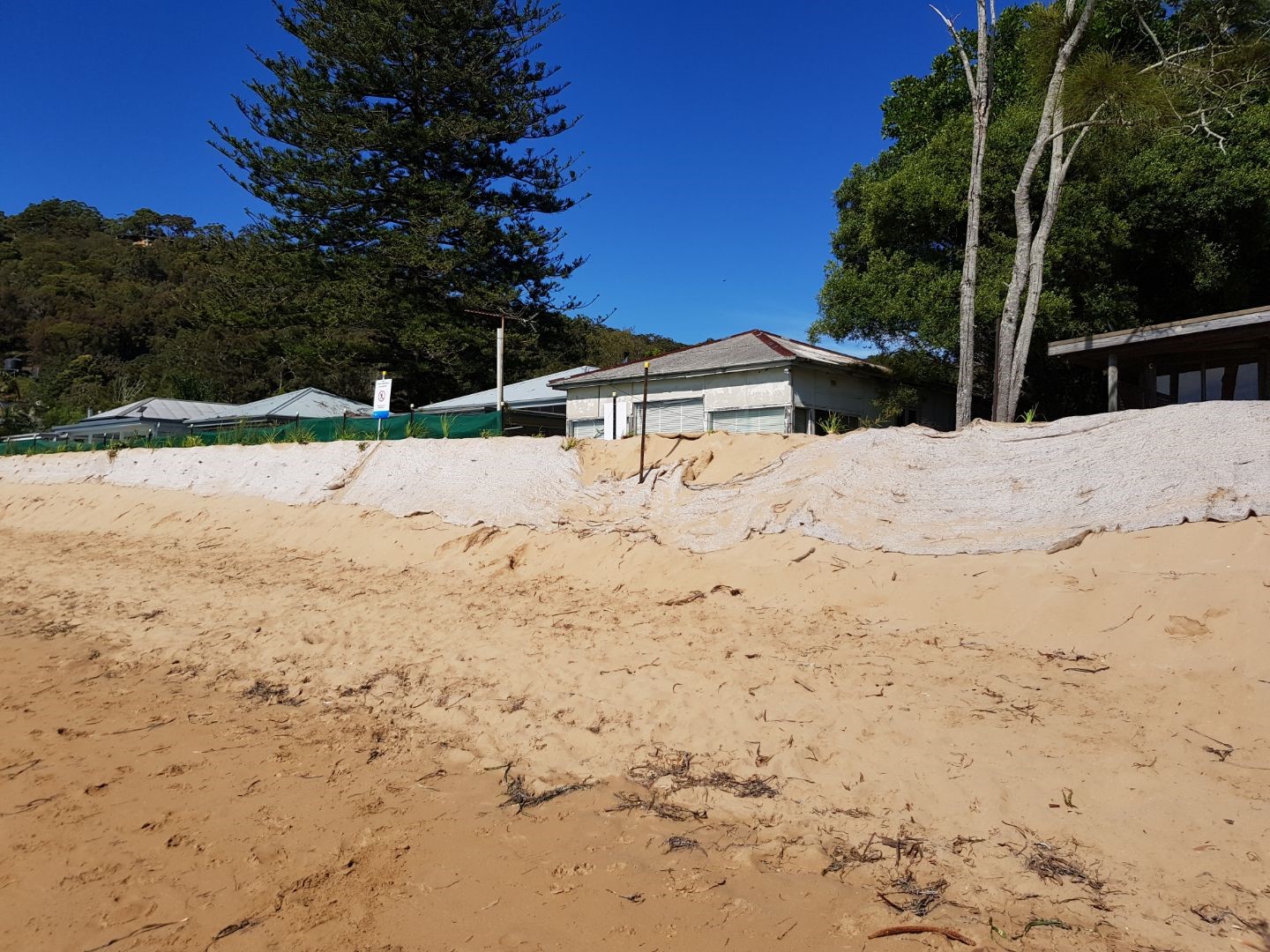
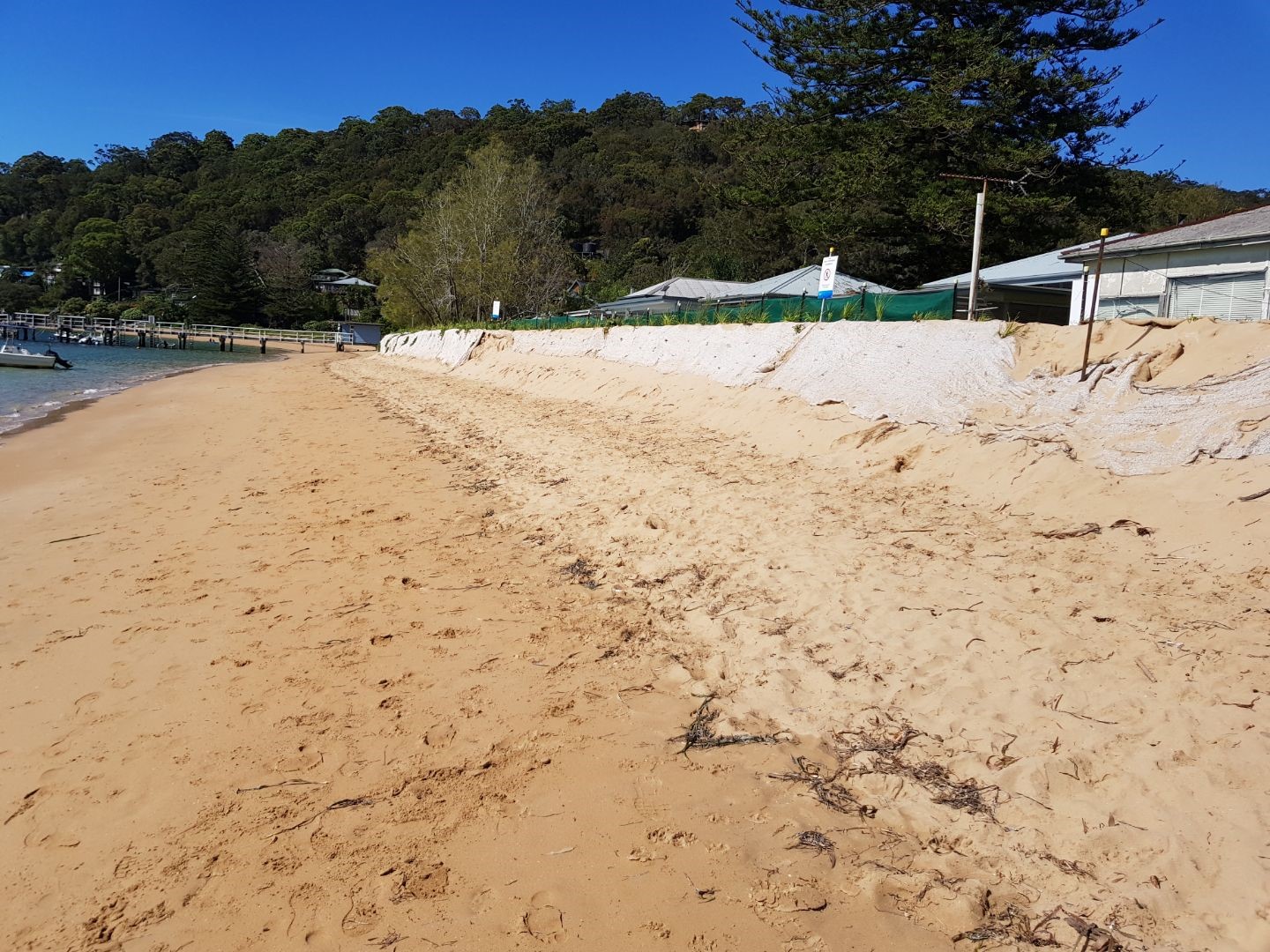
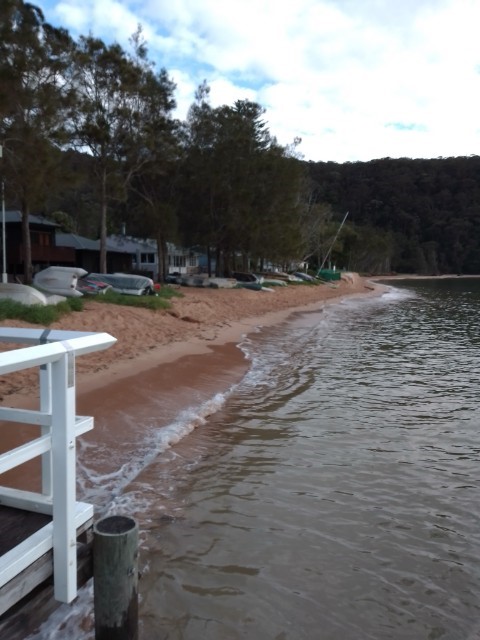
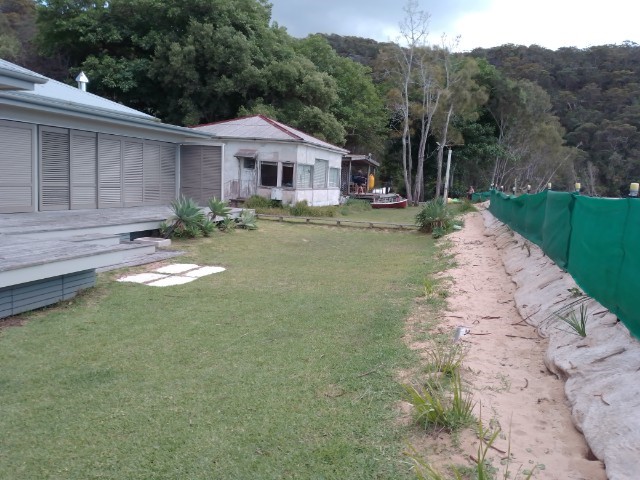
Prune Viburnum Hedge Agapanthus Flowers To Prevent Spread Into Bush Reserves
PNHA: January 11, 2023
Now is the time to prune the berries off the Viburnum hedge and dehead those old Agapanthus flowers. Put these prunings into your green waste bin. Both are now weeds of bushland as their seeds travel.
Photos: Pittwater Natural Heritage Association (PNHA)
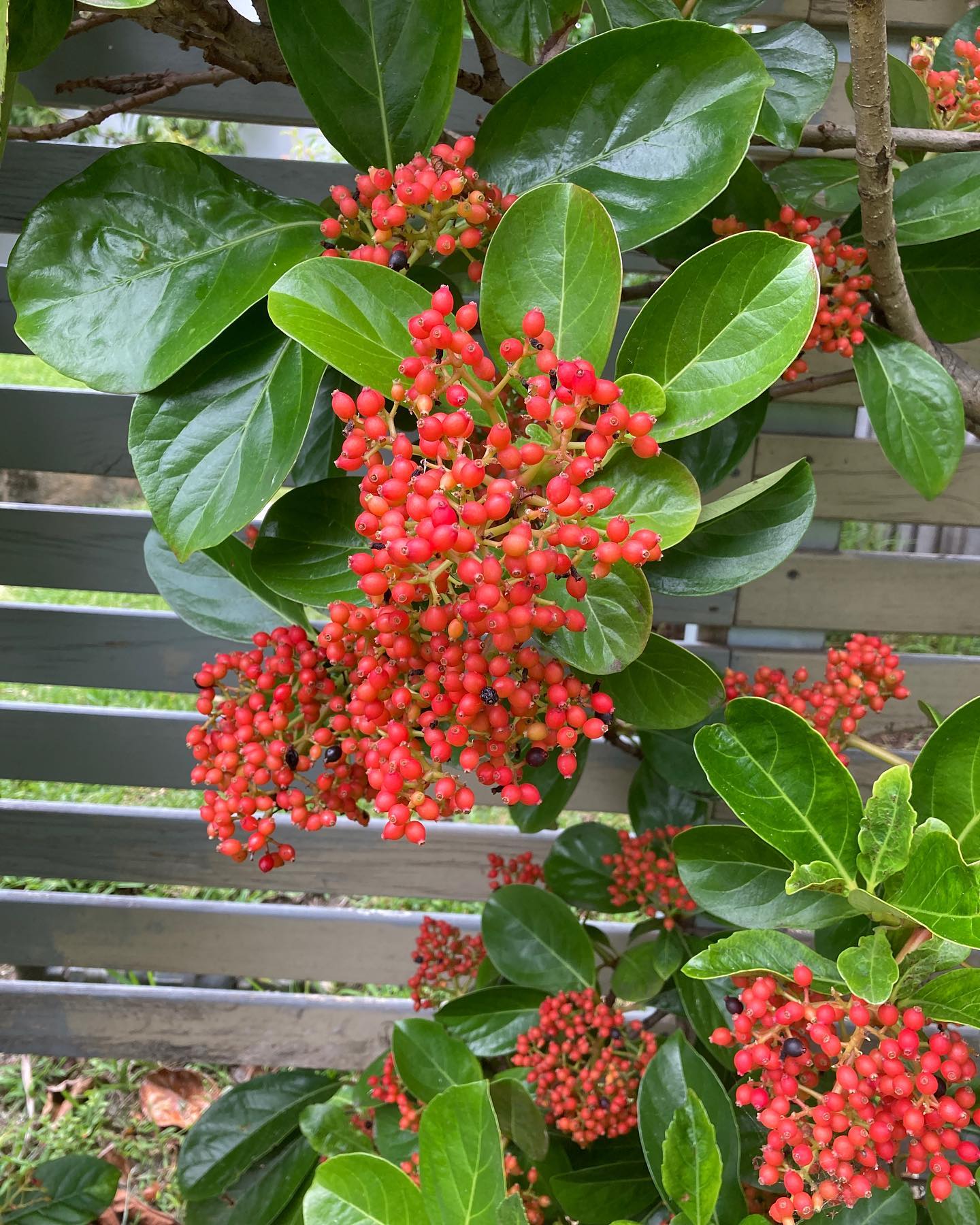
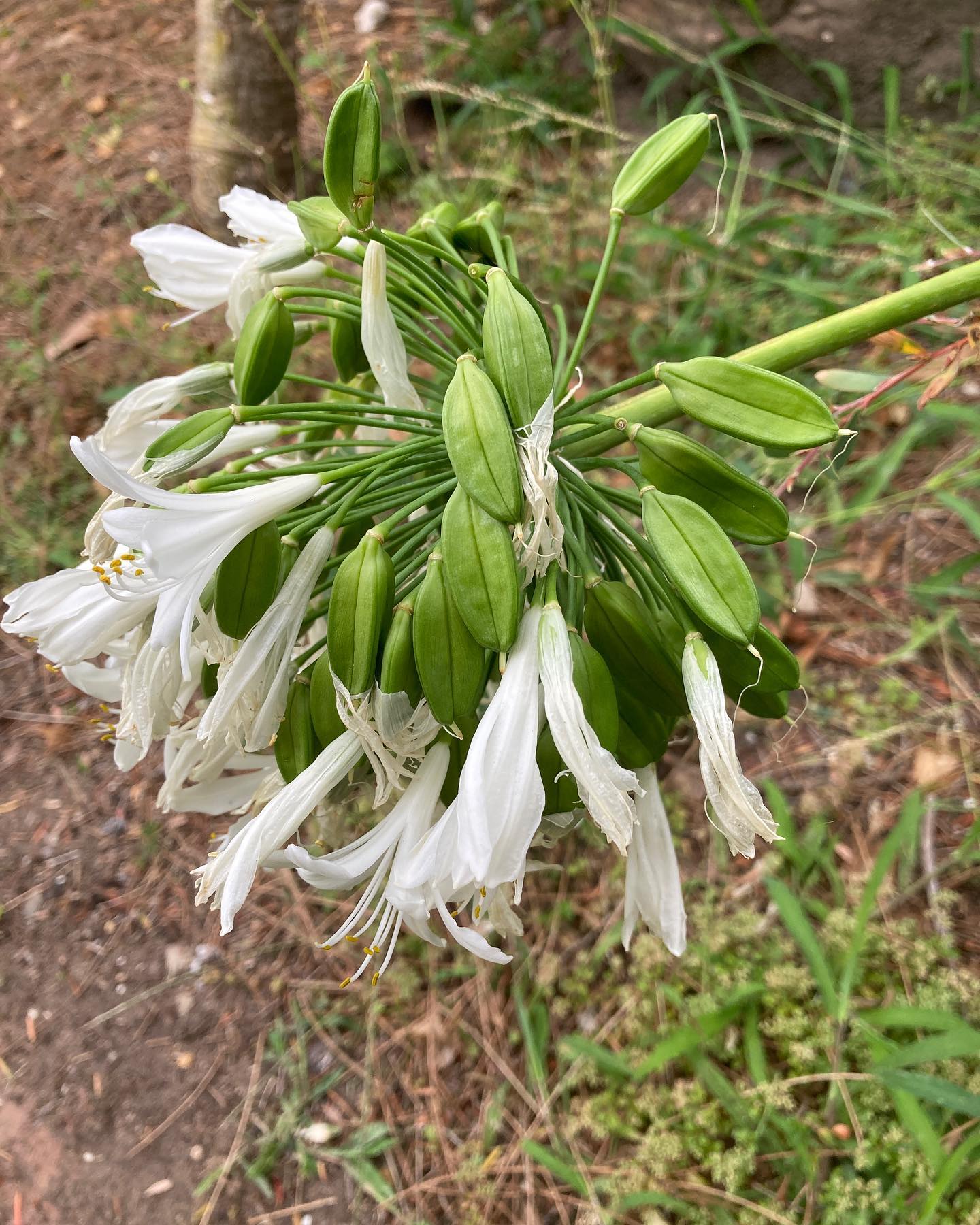
Sydney Wildlife (Sydney Metropolitan Wildlife Services): Rescue Care Course - February 2023
Our next course starts on the 4th of February. It runs for 3 weeks in a self-paced format online and then a 1 day practical session at the end on the 26th February. Both sessions must be passed to join Sydney Wildlife Rescue and rescue and care for our native wildlife.
Visit the sign on page for full details: https://smws.wildapricot.org/RCC-Trainee-Application-Form
The cost of the course is $120 and you will receive membership, manuals and equipment to help you. All new members are fully supported with a mentor when they join. Join us and make a difference to the wildlife in your area.

New Marine Wildlife Rescue Group Launched On The Central Coast
A new wildlife group was launched on the Central Coast on Saturday, December 10.
Marine Wildlife Rescue Central Coast (MWRCC) had its official launch at The Entrance Boat Shed at 10am.
The group comprises current and former members of ASTR, ORRCA, Sea Shepherd, Greenpeace, WIRES and Wildlife ARC, as well as vets, academics, and people from all walks of life.
Well known marine wildlife advocate and activist Cathy Gilmore is spearheading the organisation.
“We believe that it is time the Central Coast looked after its own marine wildlife, and not be under the control or directed by groups that aren’t based locally,” Gilmore said.
“We have the local knowledge and are set up to respond and help injured animals more quickly.
“This also means that donations and money fundraised will go directly into helping our local marine creatures, and not get tied up elsewhere in the state.”
The organisation plans to have rehabilitation facilities and rescue kits placed in strategic locations around the region.
MWRCC will also be in touch with Indigenous groups to learn the traditional importance of the local marine environment and its inhabitants.
“We want to work with these groups and share knowledge between us,” Gilmore said.
“This is an opportunity to help save and protect our local marine wildlife, so if you have passion and commitment, then you are more than welcome to join us.”
Marine Wildlife Rescue Central Coast has a Facebook page where you may contact members. Visit: https://www.facebook.com/profile.php?id=100076317431064
- Ph: 0478 439 965
- Email: marinewildlifecc@gmail.com
- Instagram: marinewildliferescuecc

Watch Out - Shorebirds About
.JPG.opt1460x973o0,0s1460x973.jpg?timestamp=1663629195339)
Possums In Your Roof?: Do The Right Thing

Aviaries + Possum Release Sites Needed

Bushcare In Pittwater
Where we work Which day What time
Avalon
Angophora Reserve 3rd Sunday 8:30 - 11:30am
Avalon Dunes 1st Sunday 8:30 - 11:30am
Avalon Golf Course 2nd Wednesday 3 - 5:30pm
Careel Creek 4th Saturday 8:30 - 11:30am
Toongari Reserve 3rd Saturday 9 - 12noon (8 - 11am in summer)
Bangalley Headland 2nd Sunday 9 to 12noon
Bayview
Winnererremy Bay 4th Sunday 9 to 12noon
Bilgola
North Bilgola Beach 3rd Monday 9 - 12noon
Algona Reserve 1st Saturday 9 - 12noon
Plateau Park 1st Friday 8:30 - 11:30am
Church Point
Browns Bay Reserve 1st Tuesday 9 - 12noon
McCarrs Creek Reserve Contact Bushcare Officer To be confirmed
Clareville
Old Wharf Reserve 3rd Saturday 8 - 11am
Elanora
Kundibah Reserve 4th Sunday 8:30 - 11:30am
Mona Vale
Mona Vale Beach Basin 1st Saturday 8 - 11am
Mona Vale Dunes 2nd Saturday +3rd Thursday 8:30 - 11:30am
Newport
Bungan Beach 4th Sunday 9 - 12noon
Crescent Reserve 3rd Sunday 9 - 12noon
North Newport Beach 4th Saturday 8:30 - 11:30am
Porter Reserve 2nd Saturday 8 - 11am
North Narrabeen
Irrawong Reserve 2nd Saturday 2 - 5pm
Palm Beach
North Palm Beach Dunes 3rd Saturday 9 - 12noon
Scotland Island
Catherine Park 2nd Sunday 10 - 12:30pm
Elizabeth Park 1st Saturday 9 - 12noon
Pathilda Reserve 3rd Saturday 9 - 12noon
Warriewood
Warriewood Wetlands 1st Sunday 8:30 - 11:30am
Whale Beach
Norma Park 1st Friday 9 - 12noon
Western Foreshores
Coopers Point, Elvina Bay 2nd Sunday 10 - 1pm
Rocky Point, Elvina Bay 1st Monday 9 - 12noon
Friends Of Narrabeen Lagoon Catchment Activities

Gardens And Environment Groups And Organisations In Pittwater
NSW EPA Releases First Climate Change Policy And Action Plan
January 20, 2023
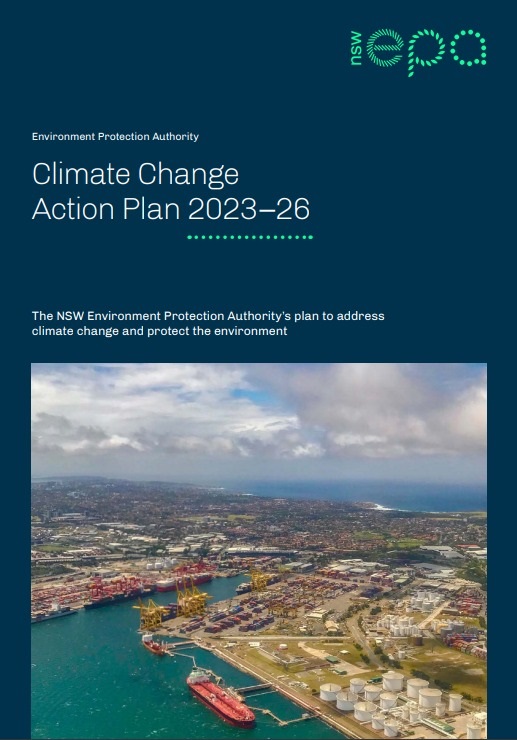 The NSW Environment Protection Authority (EPA) has released its historic Climate Change Policy and Action Plan 2023-26, outlining a bold set of actions that will help NSW reach net-zero emissions by 2050.
The NSW Environment Protection Authority (EPA) has released its historic Climate Change Policy and Action Plan 2023-26, outlining a bold set of actions that will help NSW reach net-zero emissions by 2050.
NSW EPA Chief Executive Officer Tony Chappel said the plan provides a roadmap for how the state’s environmental regulator will address the causes and consequences of climate change.
“This plan means for the first time in Australia, there will be a comprehensive approach around emissions reduction pathways,” Mr Chappel said.
“Using our robust framework, we will treat greenhouse gas emissions like any other pollutant that we regulate and by doing so, support the decarbonisation, transformation and growth of the NSW economy.
“In every corner of the state, we are already feeling the very real, costly and devastating impacts of climate change.
“From unprecedented fires through to recent extensive flood events across regional NSW, each of these disasters is a sobering reminder of the escalating consequences of rising greenhouse emissions.
“We must improve our resilience to the impacts of climate change and this plan will see significant work led by the EPA to achieve this.”
Crucial to the success of the plan will be a collaborative, staged and systematic approach to ensure actions are evidence-based and government programs are joined-up. It’s also important to allow industry sufficient time to adjust to any sector-based emission reduction targets and enforceable licence limits.
As we operationalise climate policy across the economy, the EPA will establish advisory groups for various industry sectors to help inform and co-design actions and subsequent targets.
Mr Chappel said the organisation would not take a ‘one size fits all’ approach to setting targets because no two industries are the same, nor are the climate challenges they face.
“Our focus is on enabling and supporting best practice and building collaborative processes which ensure any actions taken by the EPA are meaningful, feasible and cost-effective,” Mr Chappel said.
“To seriously combat climate change, we cannot do it alone and these groups will provide valuable information on gaps, risks and the opportunities that need to be solved or considered.
“They’ll also help NSW capture the immense opportunities that come with a net-zero economy, such as growth in hydrogen, green steel and metals, green ammonia, clean energy, the circular economy and regenerative agriculture.
“The EPA is committed to supporting industry, business, our regulatory partners and the community in transitioning to a more sustainable and prosperous future.”
The final EPA Climate Change Policy and Action Plan are available here.
What does climate change mean for extreme waves? In 80% of the world, we don’t really know

Across much of the world’s oceans, waves are getting bigger. In the Southern Ocean, where storm-driven swell can propagate halfway across the world to California, the average wave has grown about 20cm in the past 30 years.
These changes are part of climate change, and are likely to continue well into the future. If you’re making long-term plans near the sea – like building ships, or constructing flood defences in coastal cities – you need more detail about how big those waves are going to get.
In a study published today in Science Advances, we looked at the projected changes in the size of the very biggest waves around the globe. We found the uncertainties in the projections could be larger than the projected future changes themselves in about 80% of the world’s oceans and coastlines.
The ‘Wave Climate’
My group and I study the world’s “wave climate”: the size and distribution of ocean waves in different places, and how that has changed in the past and will change in the future.
We’re interested in the heights of average waves, but also the extreme conditions. As with floods or heatwaves, extreme waves are the ones that cause problems – so they’re often the ones we need to know about when we’re building near the sea.
From floating buoys and satellite radar, we have records of wave heights extending back 30 to 40 years. These data don’t cover the whole world, but we feed them into computer models that fill in the gaps.
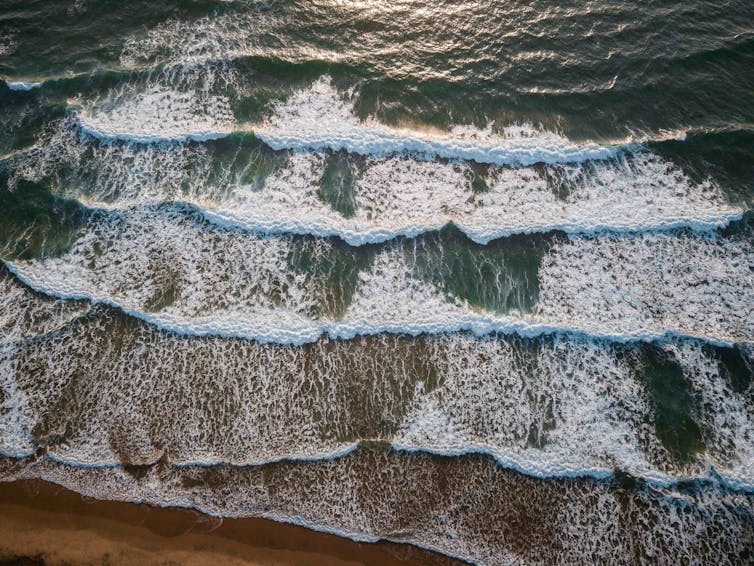
Waves are created by the wind, so our models of waves are also tied to what we know about wind conditions. Taken all together, we have about 40 years of model data giving wave conditions for the whole world’s oceans (broken up into “pixels” about 25 kilometres across).
We also use a branch of statistics called extreme value analysis to calculate things like the biggest wave you can expect at a given location once in 100 years (the 100-year event).
Why Waves Are Changing
As the climate changes, we expect that global wind patterns will change – so the world’s waves will change as well.
One change we are already seeing is that many low-pressure systems, which create high winds, are becoming more intense and moving away from the equator and towards the poles.
In the southern hemisphere, this means more high winds over the Southern Ocean, driving bigger waves. This swell in the Southern Ocean propagates out into the Pacific, Atlantic and Indian oceans – which means bigger waves across the southern hemisphere.
Indeed, we have observed that average wave heights in the Southern Ocean have increased by around 20cm over the past 30 years.
In the northern hemisphere, there is more land closer to the pole. So the high winds are now more often happening over land, and ocean waves are actually losing some height.
A Blurry Future
So what does all this mean for the future? In our new study, we tried to figure that out.
To get an idea of the future of waves, we start with wind projections from major climate models that are used to project future temperatures as carbon dioxide levels in the atmosphere increase. We then feed these winds into our wave models, and see what they predict.
There are many wind and wave models, all with slight differences in their assumptions and the way they model the physics, so they all produce somewhat different projections. We combined the results from an ensemble of a dozen models to get a clearer picture of the differences.
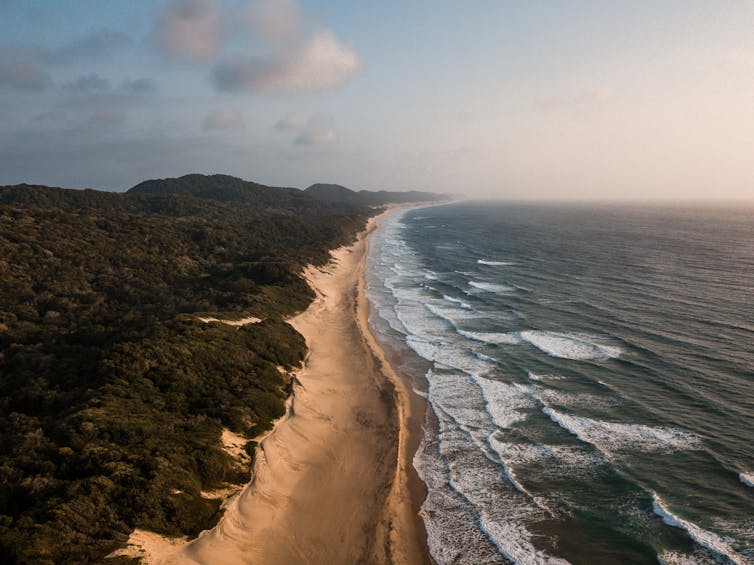
On average, we found extreme wave heights in many places are likely to grow by between 5% and 8% by 2100.
However, there is a lot of uncertainty in those estimates. One source of uncertainty is how much carbon dioxide humans pump into the atmosphere over the coming decades.
Another source is the uncertainty in the models themselves. We found that in many cases the difference in estimates between different models was about the same size as the projected changes in wave height.
A Note Of Caution
The upshot of our research is that there is still a lot of uncertainty in what will happen to the size of extreme waves in the coming decades. That means there is also a lot of uncertainty in our projections of coastal flooding and the erosion of beaches.
These uncertainties may not seem huge – perhaps 30-40cm by 2100 – but they’re big enough to determine whether or not a particular coastal property ends up underwater.
So for anyone making plans near the sea – like engineers designing coastal structures, governments building flood defences, or local councils making development decisions – the message is that you should err on the side of caution in your decision-making.
For the rest of us, it’s a reminder that climate change doesn’t just mean rising temperatures: it means a transformation of the whole global climate system, in ways we still don’t fully understand.![]()
Ian Young, Kernot Professor of Engineering, The University of Melbourne
This article is republished from The Conversation under a Creative Commons license. Read the original article.
As heatwaves and floods hit cities worldwide, these places are pioneering solutions
Thami Croeser, RMIT UniversityClimate change is going just as badly for cities as we have been warned it would. Extreme weather is increasingly common and severe globally. Australian cities have endured a number of recent disastrous events.
It’ll get worse, too. The Intergovernmental Panel on Climate Change (IPCC) factsheet outlining impacts on human settlements is a very sobering read. It also pithily sums up the situation cities face:
Concentrated risk and concentrated opportunity for action.
Implicit in this wording is a hopeful truth: adapting to climate change is a daunting task, but the “how” is not a mystery. The opportunity is right in front of us, in our streets, buildings and parklands. Around the world we are seeing effective retrofitting of cities to adapt to more extreme weather.
Here are a few inspiring exemplars.
Keeping The City Cool
Planting trees to create shade is an obvious response to hot weather. However, in many cities it’s still a struggle just to stop the losses of trees. Future hot, dry climates will add to the challenge of urban greening.
Medellin in Colombia is one city making inspiring progress on this front. With an urban greening budget of US$16.3 million, it has created a network of 30 “green corridors” through the city. These have reduced urban heat island effects by 2℃ three years into the program. As these densely vegetated corridors mature, they are expected to eventually deliver 4-5℃ of cooling.
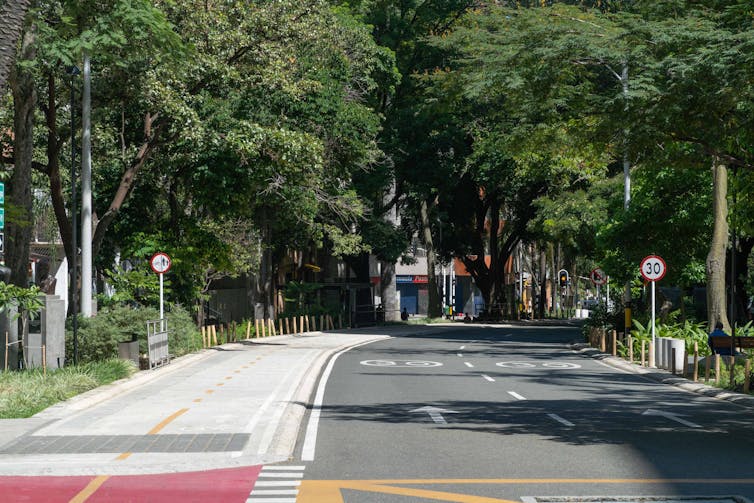
Vienna, Austria, has had an urban heat island strategy in place since 2018. It includes planting 4,500 trees each year and subsidies for street-facing green walls.
The city has developed a series of “cool streets” – traffic-calmed spaces with light-coloured road surfaces, “fog showers” that activate on hot days, water features, shade trees and drinking fountains. Eighteen cool streets were delivered as pop-ups, with another four in place permanently to provide refuges on hot days. Vienna also has an extensive network of public swimming pools where residents can cool off.

Limiting Flood Damage
Urban green space can also be valuable for intercepting and absorbing stormwater to prevent flooding.
A spectacular example is Bishan-Ang Mo Kio Park in Singapore. It was the site of a concrete drainage canal that was transformed into a 3.2km winding stream in 2012.
The 62-hectare park along the gently sloping banks of the stream serves a densely developed residential area. In wet conditions, the stream swells up to 100 metres wide. As stormwater gently flows downstream, it drains away into the landscape.
Since the park was created, visitor numbers have doubled to 6 million a year. Biodiversity has increased 30%.
A very urban version of this approach is the “floodable square”. A good example is Rotterdam’s Watersquare Benthemplein, a sunken public plaza and basketball court that becomes a major stormwater basin when it rains.

While this approach is a win-win on large development sites, it can be tricky to retrofit built-up areas. Fortunately, there are many more compact approaches that can deliver large benefits when delivered at scale.
New York City, for example, has spent over US$1 billion on smaller, distributed solutions in flood-prone streets. These measures include “raingardens” that drain water from streets, and infiltration basins that divert and store stormwater.

Green roofs that capture rainwater also help reduce flood risk in built-up areas. Again, Rotterdam’s approach is interesting; while reducing stormwater flows is a focus, the city’s rooftop greening program focuses on multifunctionality by integrating solar panels, social spaces and rooftop farming. The retrofitted “Dakakker” (rooftop farm) has advanced stormwater storage, vegetable beds, beehives, a few chickens and a popular café.

Of course, a green roof program usually requires private building owners to get on board. Rotterdam subsidises owners who deliver rooftop greening that intercepts significant amounts of stormwater. In 2021, Rotterdam had 46 hectares of green roofs, equating to around 0.5 square metres per resident.
The Swiss city of Basel leads the world with 5.7m² of green roofs per person (as of 2019). Basel has had incentives as well as laws requiring green roofs since the late 1990s; this highlights the value of putting regulations in place early.
The principle seems to work for bigger cities too: Tokyo has mandated green roofs since 2000, and has around 250ha of them.
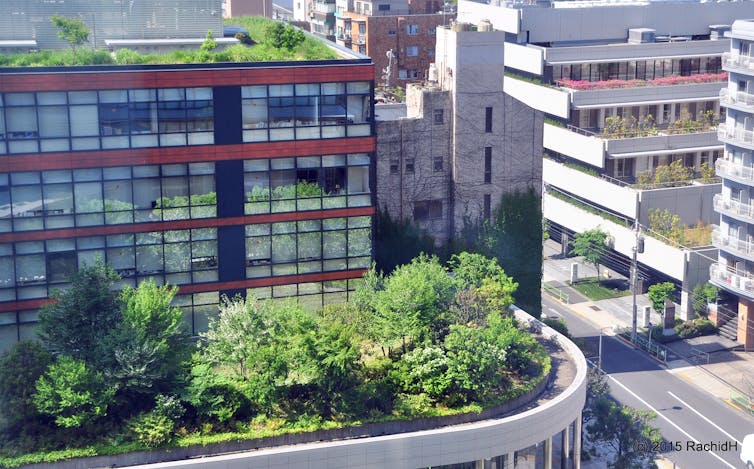
What Does This Mean For Australia?
Our cities remain woefully unprepared for extreme weather. But many of the above approaches are starting to crop up in Australia. The challenge is to move from a handful of trials to a large-scale, systematic roll out of infrastructure to adapt our cities to climate change.
The experience of the cities profiled above points to a few crucial ingredients.
First, cities must be willing to invest heavily, both in new green spaces and in subsidies to encourage greening by private property owners.
Second, reallocation of existing grey space, like roads and canals, must be pursued fearlessly and systematically. Paris’s elected mayor since 2014, Anne Hidalgo, is a spectacular example of the political courage required for large-scale greening.
Third, the law can play a real role in guiding development, through measures such as mandating greening on buildings. This can be achieved through fairly simple tools like Toyko’s green roof requirement, or more sophisticated area-based instruments that require a portion of a development to have green walls and/or roofs. Cities like Seattle and Brisbane are using these tools, which are also being mooted in Melbourne.
Recent disasters have made clear the urgent need to step up urban climate adaptation. The costs of not acting decisively to protect ourselves and our cities will be considerable, but the playbook is ready for us.![]()
Thami Croeser, Research Officer, Centre for Urban Research, RMIT University
This article is republished from The Conversation under a Creative Commons license. Read the original article.
Writing from the edge of catastrophe: two new books clarify what’s at stake if we fail to mitigate climate change
Kate Crowley, University of TasmaniaThe Australian Black Summer fires of 2019-2020 were unspeakably grim. Twenty-four million hectares were burnt, 33 people died, and over a billion animals perished.
In Fire: A Message from the Edge of Climate Catastrophe, Margi Prideaux tells us that on Kangaroo Island, which lies off the Australian mainland, just south-west of Adelaide, 211,500 hectares were burnt, two human lives were lost – a fire-fighting father and son – and 60,000 farm animals died.
But so much more was lost as the Kangaroo Island community sought to save itself from the monster fire that was started by a lightning strike, burst into two pyrocumulonimbus clouds, and devoured everything before it at lethal, unstoppable speed.
It will take years before the toll on the island’s biodiversity is fully understood, not least because these fires burned “hotter, deeper and were far more extreme” than its landscape has adapted to.
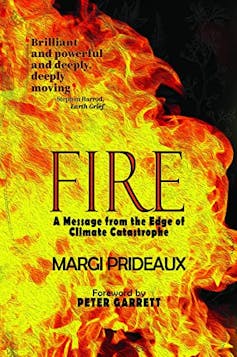
To add to this, Australia has recently suffered from unprecedented, ravaging rain and flood events. Warnings abound that climate change – driven by the burning of coal, gas and oil – is consigning Australia to an era of climate disasters.
Australia’s national science agency reports that Australia will be hotter and drier, with fewer but more intense tropical cyclones. Heavy rainfall and floods will continue. Intense, longer-lasting marine heatwaves are expected, as is more frequent and severe bleaching of coral reefs.
These are not natural disasters. They are unnatural. And Australian governments are not prepared. They have, as Professor Rosemary Lyster has argued, “a terrible track record of policies for disaster prevention, preparedness and response”.
We must be better prepared, Lyster argues. Yet if the focus shifts from preventing disaster to simply responding better, we will lull the community into a false sense of the inevitability of loss, and we will let governments off the hook.
Review: Fire: A Message from the Edge of Climate Catastrophe – Margi Prideaux (Stormbird); Saving the Reef – Rohan Lloyd (University of Queensland Press).
Failure And Loss
In the wake of loss, trauma and shock, comes the grieving.
Margi Prideaux is a formidable international politics and legal academic, who has written extensively on environmental topics. Threaded through her book are first-hand accounts of the shocking consequences of the monster bushfire for the Kangaroo Island community. Her stories of loss are heartbreaking.
There is a striking rhythm to Prideaux’s narrative. Each chapter opens with traumatised community voices that speak of fire-breathing dragons, melting aluminium, darkness and death. Her own faltering but powerful voice is interwoven with these tales of trauma, and the stark objective facts as she assesses them.
Prideaux writes on newly scorched land in a temporary shipping container – having lost her home, vineyard, everything, despite her and her partner’s efforts, and despite the community’s. But she is inspired by her own experience of profound loss to advocate for the innocent human and non-human victims of climate change.
She also bears witness to the political failure to mitigate climate change and develop genuine adaption plans. She describes the bleak tragedy experienced by her community in the context of the clear dictates of climate science, the wickedness of politics, and the failures of public policy.
Her message is delivered with some urgency because disaster is already upon us. Climate change is happening now, she warns: there is no time for politics or division. Communities, livelihoods and ecosystems are already being lost. Local communities, which are in the front line, must be empowered by all levels of government to act.
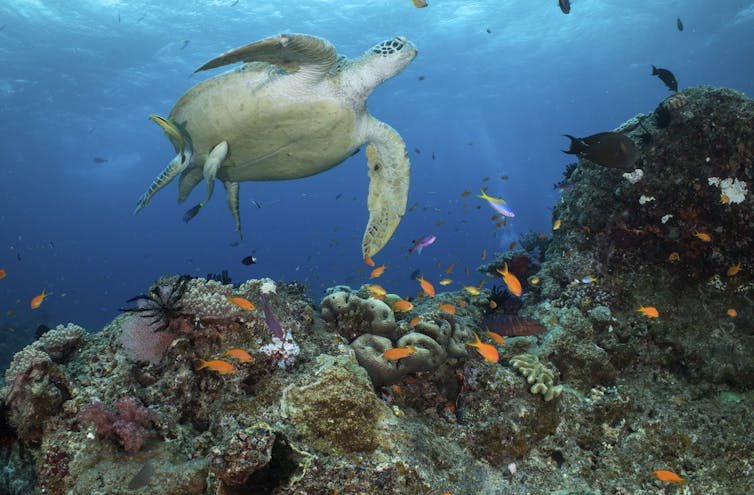
Reef In Danger
Loss also hits hard in Rohan Lloyd’s Saving the Reef.
The Great Barrier Reef is one of the seven wonders of the natural world. It is the only living thing on earth visible from space.
Since its inclusion in UNESCO’s World Heritage List in 1981, it has lost over half its coral. It is now listed as “in danger”. It will be gone, as will all coral reefs, if global warming is not held at 1.5 degrees above pre-industrial levels.
Saving the Reef is a forensic, historical cataloguing of loss. Lloyd describes an ecosystem suffering a gruesome death by a thousand cuts – from the loss of beche-de-mer, pearl and trochus shell fisheries, to the damaging effects of invasive species, coral mining, the oil and tourism industries, and, increasingly, from climate change.
Lloyd is an environmental historian, curious about the Western impact on the Great Barrier Reef since first contact. He pieces together the historical evidence and finds that the roots of the reef’s present danger can be readily found in the past.
“Our current crisis,” he writes, “is a messy knot that has threads entangling back through time that can’t be unravelled but can be seen.”
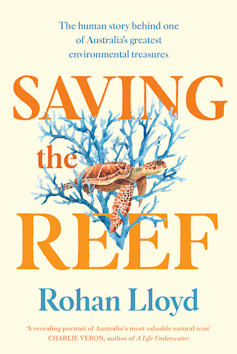
Lloyd appreciates the way that different voices, including the voices of First Nations people, have told differing stories about the reef. Differing economic, cultural and environmental values have been attributed to it. And the threats that it has faced have varied greatly over time.
Saving the Reef documents several fraught, but ultimately successful, efforts to stave off rampant exploitation of the reef’s resources. Mineral and oil exploration were early, significant threats. Then came the plague of crown-of-thorns starfish, followed by tourism and over-fishing.
Today the most immediate environmental concerns are marine debris, agricultural run off, and the overwhelming need to ward off the effects of extreme weather events and the ravages of global warming.
Lloyd describes the clash between exploitation and protection that led to the establishment of the Great Barrier Reef Marine Park Authority. Of particular note is his analysis of the tensions that arose between the Commonwealth and Queensland governments, with the oil companies and conservationists caught between.
Notable, too, is Lloyd’s awareness of the plethora of competing interests still staking a claim in the future of the reef. Conservationists, naturalists, geologists, developers, tourism operators, and industry lobby groups are all still looking to influence future decisions.
Hope In The Face Of Disaster
Fire and Saving the Reef are both written on the edge of catastrophe. But the catastrophe is clarifying for Prideaux, just as historical understanding is clarifying for Lloyd – and essentially for the same reason. The past offers our best hope, providing lessons for averting future disaster.
If we are on the brink of losing everything, Prideaux writes, having just lost everything herself, then we have no choice. We must radically empower local action. First Nations peoples, farmers, fishers, conservationists, landholders and scientists must sit and plan together to protect local communities and environments.
Both authors are wary of government and its motives. They see bureaucratic processes as distractions from real, measurable action. Bureaucrats have not prevented bush fire disasters, nor have they protected communities. Greenhouse gas emissions are not reducing and reef restoration simply tinkers in the face of catastrophic global warming.
But both books offer some hope. For Prideaux, the bushfire catastrophe inspires radical localism; for Lloyd, saving the reef is also a local project for many. Both authors are acutely aware, however, that the losses they document have global causes and that now is the time for Australia to act urgently to reduce its contributions to climate change.![]()
Kate Crowley, Adjunct Associate Professor, Public and Environmental Policy, University of Tasmania
This article is republished from The Conversation under a Creative Commons license. Read the original article.
They say we know more about the Moon than about the deep sea. They’re wrong

We know more about the Moon than the deep sea.
This idea has been repeated for decades by scientists and science communicators, including Sir David Attenborough in the 2001 documentary series The Blue Planet. More recently, in Blue Planet II (2017) and other sources, the Moon is replaced with Mars.
As deep-sea scientists, we investigated this supposed “fact” and found it has no scientific basis. It is not true in any quantifiable way.
So where does this curious idea come from?
Mapping The Deep
The earliest written record is in a 1954 article in the Journal of Navigation, in which oceanographer and chemist George Deacon refers to a claim by geophysicist Edward Bullard.
A 1957 paper published in the Journal of the Royal Society of Arts states: “the deep oceans cover over two-thirds of the surface of the world, and yet more is known about the shape of the surface of the moon than is known about that of the bottom of the ocean”. This refers specifically to the scant amount of data available on the topography of the sea floor and predates both the first crewed descent to the deepest part of the ocean, the Mariana Trench (1960), and the first Moon landing (1969).
This quote also predates the practice of using ship-mounted echo-sounders to map the sea floor from acoustic data, known as swathe bathymetry.
Almost a quarter of the world’s sea floor (23.4%, to be precise) has been mapped to a high resolution. This amounts to about 120 million square kilometres, or about three times the Moon’s total surface area. This may be why the comparison has shifted to Mars, which has a surface area of 145 million square kilometres.
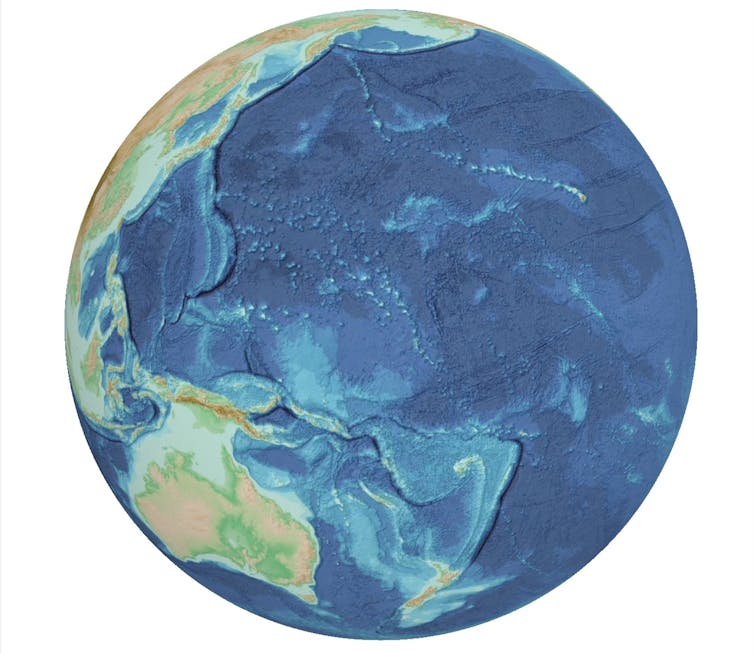
What’s more, high-resolution maps do not constitute the total sum of knowledge. The deep ocean must be considered in three dimensions – and, unlike the Moon, it is a diverse and dynamic ecosystem.
A Surprising Number Of Visitors
Another related and incorrect comparison is that more people have set foot on the Moon than have visited the deepest place on Earth.
This statement is difficult to substantiate. “The deepest place on Earth” could refer to the Mariana Trench, or just the deepest part of it (the Challenger Deep, named for the British survey ship HMS Challenger).

Nevertheless, at least 27 and as many as 40 or more people have visited the Challenger Deep as of early 2023. On the other hand, only 12 people have “set foot” on the Moon and 24 people have visited it.
Out Of Sight, Out Of Mind
So why do people keep saying we know more about the Moon or Mars than the deep sea?
It feels natural to compare the deep sea to space. Both are dark, scary and far away.

But we can see the Moon very easily by simply looking up. By being able to see it, we accept an apparently glowing rock hanging in the sky more easily than that parts of the ocean are very deep. We can see the Moon wax and wane and we can experience the push and pull of the tides.
It feels like we know more about the Moon than the deep sea, because we are forced to accept its presence. It intrudes on our lives in a tangible way that the deep sea does not.
We don’t think much about the deep sea unless we’re watching a documentary or horror film, or perhaps reading about some “horrific alien-like monster” dredged up by a deep-sea trawler.
A Useful Analogy
Because the deep sea is so physically inaccessible, comparing it to space may offer a useful analogy for an otherwise difficult-to-imagine ecosystem. But some deep-sea scientists argue that the persistent estrangement of the deep sea minimises the vast amount of research about it that has emerged in recent decades.
Deep-sea biology is relentlessly referred to as a discipline that knows less about its own field of study than a relatively small, barren rock devoid of atmosphere, water and life. And yet this self-deprecating line is repeated by scientists themselves, who may find that highlighting the deficit of knowledge about the deep sea helps to promote the need for ocean research.
Ultimately, the idea we know more about the Moon than the deep sea is at best about 70 years out of date. We know much more about the deep sea – but there is even more left to be known.![]()
Prema Arasu, Postdoctoral research fellow, The University of Western Australia; Alan Jamieson, Senior Lecturer in Marine Ecology, Newcastle University, and Thomas Linley, Research Associate, Marine Ecology, Newcastle University
This article is republished from The Conversation under a Creative Commons license. Read the original article.
Birdsong isn’t just competition for mates or territory. Zebra finches sing to bond
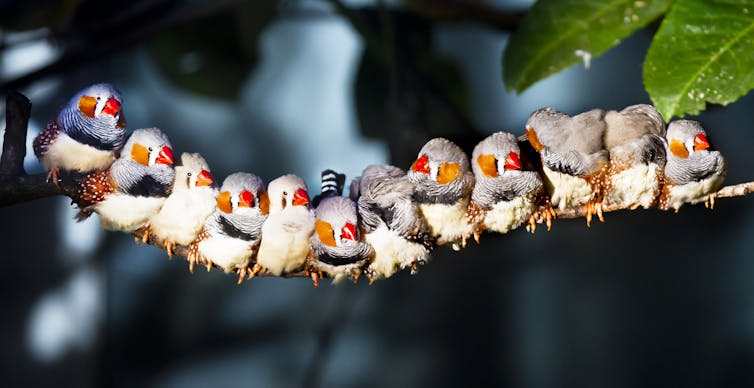
When you hear beautiful birdsong, such as the warbling of the Australasian magpie, you might believe it’s a sign of intense competition for territory or showing off to attract a mate.
After all, that’s the way birdsong is often thought of – a way for male birds to compete with each other. A prettier version of nature red in tooth and claw, as Tennyson put it. There’s some truth to it – in many species, even the most beautiful song by a male in another’s territory will invite attack.
But birdsong isn’t one dimensional. In some species, birdsong is much less about competition and much more about social cooperation. Our study of highly social zebra finches found the song of the males boosts social cohesion in local populations. It even helps these tiny birds to coordinate their nest building, mating and reproduction when there’s about to be abundant food for their young.
So when you hear a melodious song, enjoy it. Nature isn’t just about competition. More and more, we’re learning cooperation is there too. In some species, birdsong promotes harmony at a species level – and boost bonding between a male and his partner.

What Did We Find?
Zebra finches travel in large flocks through Australia’s arid interior, looking for seeds. They’re highly social, and are known as a bird species able to learn new songs.
Zebra finches are one of Australia’s most-studied birds, because they’re easy to keep in captivity. But to discover how they act in the wild, we had to go remote to a study area near Broken Hill.
To capture their song, we installed more than 20 microphones and recorded them from dawn to dusk every four days over a whole year.
We chose this species because the males sing their own individually distinctive songs – and they do it relatively quietly, compared to the loudspeaker bugling of, say, a currawong.
That’s important. When birds sing softly, it’s a sign the song isn’t a warning about territory. Zebra finch songs can be heard only by birds within a few metres, and they’re often sung when birds perch together in the same bush. So why do they do it? When each male sings their own unmistakable songs, it lets others in the group figure out who is singing – and gauge how many males are close by.
Listen for yourself. The two songs below are from male zebra finches – but they’re clearly very different from each other.
What happens when you play one male’s song to another male? In more territorial and less social species, it would provoke a aggressive response. But in zebra finches, it has the opposite effect. It actually draws in other males closer to share the same space. That’s why you can often hear multiple males sing together in the same bush.
Song For Social Bonding
On our recordings, we heard zebra finches every day – even though it was in 2019, when one of the worst droughts in the last 100 years made conditions very poor. No finches even attempted to breed.
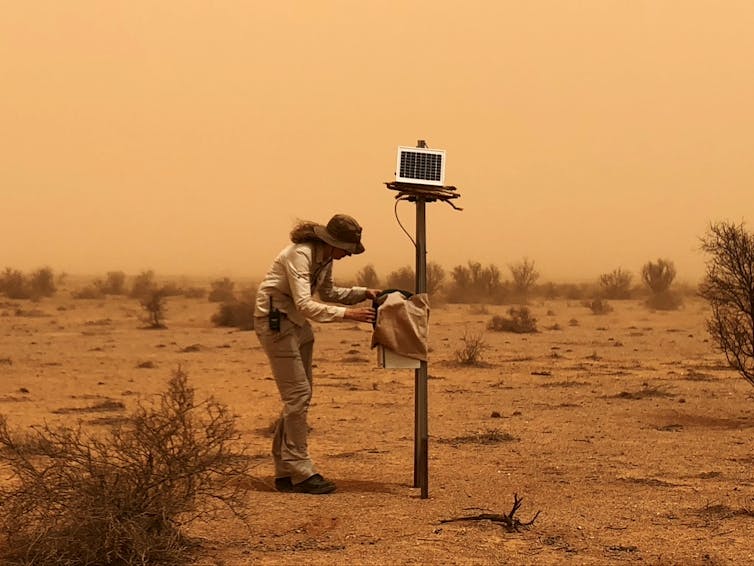
But then the climate cycle shifted from drought to rains and flood. Water drove grass growth – and that meant seeds were coming. The finches sensed this and began mating.
As the drought broke, we heard the males sing more, peaking around the time the female birds laid their eggs. This suggests zebra finch song is part of an ongoing “discussion” between a female and her partner, which helps synchronise their activity. Song is likely to be related to how birds feel. When food is abundant birds feel better and sing more. When individual finches hear lots of singing in the area they know others are also enjoying the conditions and it gives greater confidence in the decision to start breeding.
So if zebra finch males don’t sing to claim territory, are they doing it to show off to prospective mates? Nope. In these remarkable birds, the males tend to sing after they’ve found a partner. They sing to her while perching next to her on a branch, and they will sing regularly – even daily – over the years of their relationship.
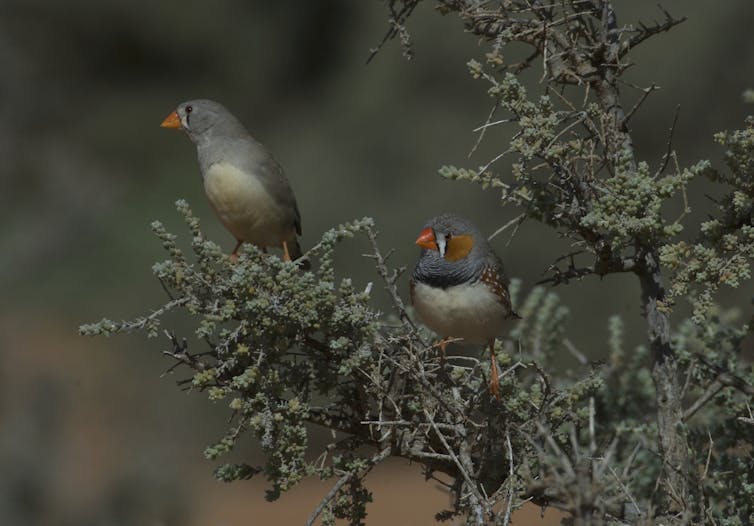
The females of most singing species sing too. Female zebra finches, however, don’t sing.
We believe the serenading of the female zebra finch by her partner may play a similar social function to the commonplace song duets you can hear from Australian songbirds in suburbs or in the bush.
For instance, magpie-lark couples will sing a duet while doing a kind of dance, making distinctive, synchronised wing spreading, shoulder raising and body flicking movements.
These duets help to strengthen the pair’s bond and help them coordinate their behaviour. These synchronised songs and visual displays also show the strength of their partnership, which can make territory intruders think twice. For zebra finches, it may be the male’s constant song is enough to keep the pair well bonded.
Australia is rightly famous for its birds, from raucous cockatoos to melodious songbirds. After all, birdsong evolved here first and spread to the rest of the world.
Now we know the zebra finch uses song as social bonding, we can look for this in other species around the world. We expect many other gregarious species will use song in ways more complex than marking territory or drawing in mates.
Birdsong is the animal sound we most regularly encounter – it’s part of the background of our lives. But for birds, it’s far beyond a pretty melody. It’s fundamental to how they live and who they are as a species. ![]()
Simon Griffith, Professor of Avian Behavioural Ecology, Macquarie University and Hugo Loning, PhD candidate in Behavioural Ecology, Wageningen University
This article is republished from The Conversation under a Creative Commons license. Read the original article.
Could feral animals in Australia become distinct species? It’s possible – and we’re seeing some early signs
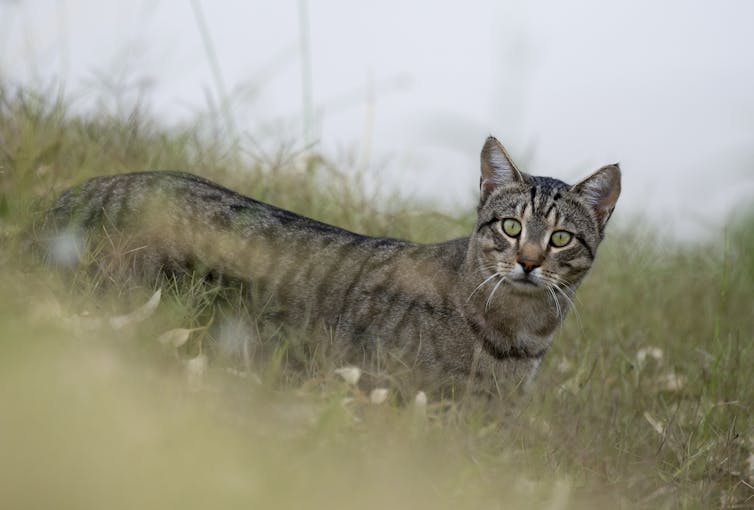
You might think evolution is glacially slow. At a species level, that’s true. But evolution happens every time organisms produce offspring. The everyday mixing of genes – combined with mutations – throws up new generations upon which “selection pressure” will act.
This pressure is popularly known as survival of the fittest, where fittest means “best adapted” individuals. Tiger snakes with a mutation for a larger head can eat larger prey. Evolution is the zoomed-out version, where species change – or evolve into new ones, better adapted to the environment they find themselves in.
Evolution acts over millennia. But given the right conditions, it can also work surprisingly rapidly. Australia’s isolation produced our distinctive animals. But until recently in a geological sense, it had no camels, cats, toads and dogs. Now it does. Millions of feral animals, birds and amphibians now call Australia home. And their new home is beginning to change them in turn.
Can Evolution Run Fast?
We’ve long thought evolution grinds slowly. But given the right conditions, pressure can bring change much faster. A recent study found evolution acting up to four times faster than previous estimates. On average, species in the study saw an 18.5% increase per generation in their ability to survive and reproduce. This remarkably rapid change suggests many species (not all) may be well able to adapt to rapid environmental changes.
Australia’s feral animal species all arrived through human efforts. Dogs came first through by contact between First Nations peoples and traders from what is now Indonesia. Cats came next, accompanying European colonists in the 1700s (and maybe earlier). Camels in the 1840s. Cane toads came in the 1930s. That’s to say nothing of deer, horses, goats, pigs, water buffalo, mynahs, foxes and rabbits.
Once here, dogs, camels and cats rapidly gave up domestication, becoming dingoes, feral camels and feral cats. With each generation, these animals have become better adapted to their new environments. They are now evolving in Australia.
Dog Or Dingo?
The status of the dingo has been heavily contested and we even argue about what to call it. Given it can interbreed with domestic dogs, it’s not a separate species. Recent research suggests it’s an intermediary between wolves and domestic dogs. Dingoes have been implicated in the thylacine’s extinction on the mainland.
Given the dingo’s closest relative is the New Guinea singing dog, which howls like a wolf with overtones of whalesong, the dingo may have already evolved away from its ancestors. There’s certainly evidence of unique selection pressures but nowhere near enough to be considered a separate species. Similarly, dingoes tend to have broader heads than domestic dogs and more flexible joints. They don’t woof but howl.
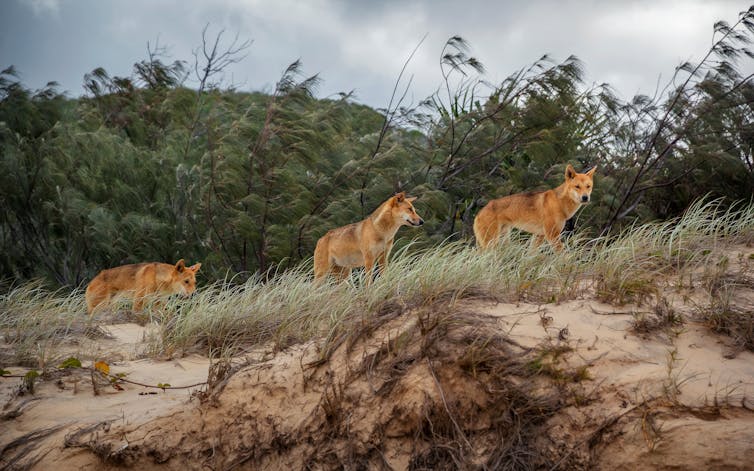
An Australian Camel?
It’s a similar story for camels. Australia’s one-humped dromedaries were imported from Afghanistan and Pakistan because of their ability to live in arid environments. It’s no surprise they have thrived. Hundreds of thousands now roam the Red Centre. We may now have the largest wild population of dromedaries in the world. Given their numbers, in time, we may have a uniquely Australian camel.
Though we have a huge population of camels, they have low genetic diversity as they came from a small original population. Low diversity usually means a species is less able to adapt to changes in the environment.
Cats Are Getting Larger
Domestication sits lightly on cats, with the difference between a pet cat and a feral just a couple of missed meals.
Cats are one of the most invasive species globally. In Australia, they have done the worst damage, killing everything from native mice to wallabies with abandon and pushing many to the brink of extinction.
Ferals are getting bigger, with reports of 7 kilogram cats now common, well up from their domestic range of 4–5kg. Tales of panther-like felines may well be huge feral cats. Some have been estimated at 12–15kg. Take the estimated 1.5 metre feral killed in 2005 – double the nose-to-tail length of a domestic cat.
What’s going on? One reason is feral cats aren’t desexed, meaning toms can grow as large as a small dingo. But it also seems selection pressures are favouring larger cats. We don’t know if it’s due to genetic changes or the rich diet of endangered animals. Normally, gigantism – where species grow to larger than usual sizes – is associated with islands. Think of the giant Komodo dragon, or of the extinct dodo – in reality, a giant pigeon.
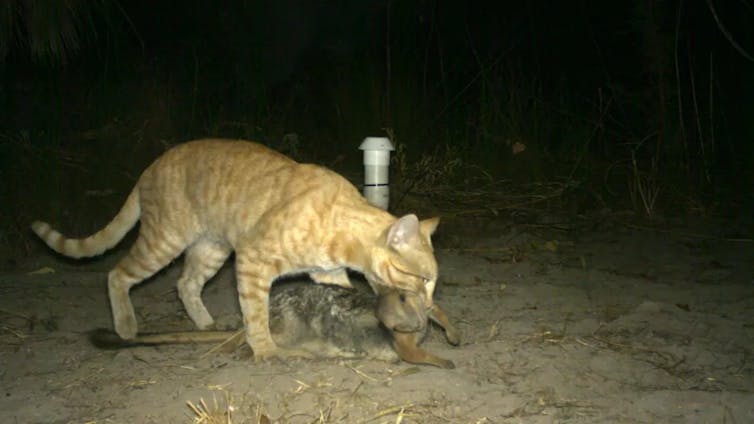
Cane Toads: Phase Shifters With Longer Legs
In 1935, the infamous cane toad was brought in to eat the cane beetles plaguing sugar plantations. As we know, cane toads soon figured out there was a lot more to eat. Protected by poisonous glands on their back, they have spread across the tropical north to the Kimberley and down the east coast approaching Sydney.
Toads at the front of the invasion have developed longer legs, making faster travel possible. Remarkably, in some shady gorges in the Kimberley, some have switched from being nocturnal to diurnal.
Adaptation Is Under Way – But Will We Actually See New Species?
Consider too Darwin’s famous Galápagos finches. On these isolated islands, finches calved off into separate species. Seed-eaters evolved thicker beaks, while the vampire finch evolved to drink blood from larger birds.
So could it happen here? Yes – if conditions are right. Let’s speculate that natural selection keeps pushing feral cats to get larger and larger.
Eventually, these giant cats would see any domestic cats fleeing from farms or homes not as mates – but as prey. Once the gene flow from smaller cats was cut off, the gene pool would be limited – and we would be on track for a new species. Perhaps one day, we will have a uniquely Australian cat alongside our uniquely Australian dog. ![]()
Bill Bateman, Associate professor, Curtin University
This article is republished from The Conversation under a Creative Commons license. Read the original article.
Disastrous floods in WA – why were we not prepared?
Toni Hay, Indigenous Knowledge and Courtney-Jay Williams, Indigenous KnowledgeThe devastating floods sweeping through the Kimberley region of Western Australia have caused unimaginable destruction, leaving remote Indigenous communities stranded in its aftermath.
Heartbreaking reports detail community members desperately seeking assistance from loved ones in Perth. In one case, over 40 people were forced to seek refuge under one roof — unable to access emergency shelters filled beyond capacity.
Some Kimberley locals have taken matters into their own hands by using local boats for search and rescue missions. The government has also since begun organising delivering supplies to these communities in need. However, Derby Shire Council President Geoff Haerewa told the Guardian he felt authorities could have done “a lot more” to prepare for the flooding.
Climate disasters are no longer unprecedented, with both scientists and First Nations people warning of future disaster weather events. Australia needs to do better with disaster prevention, so vulnerable communities don’t have to go through this again.
Atmospheric Rivers
Atmospheric rivers are long, narrow lanes of moist air transported in the atmosphere. According to the ARC Centre of Excellence for Climate Extremes, these weather patterns can be beneficial for breaking droughts. However they can contribute to heavy flooding, as we saw in last year’s floods in South East Queensland and NSW.
Scientists have identified that higher sea surface temperatures, increased concentrations of atmospheric rivers, and other climate-related events can lead to more severe floods, storms, droughts, and heatwaves.
Atmospheric rivers have devastated the Kimberley region with its highest level of rain since records began in 1904. Some areas received as much as 831mm of rain in a single week. Intense storms and cyclones in Western Australia have also caused heavy rainfall over the past several months.
Disaster Management Plans Need To Consider Indigenous Peoples
Indigenous communities are among the most vulnerable to the impacts of climate change. Yet, current Australian disaster risk management approaches fail to consider the needs of Indigenous communities, such as housing shortages and reduced access to medical services. This leaves them vulnerable to disaster events like flooding. Most towns and communities in WA have no climate adaptation plans in place.
Some Indigenous communities in Australia are reliant on bush food and hunting for sustenance, especially for those living in outlying areas. These activities are made impossible when flood events occur, heightening pre-existing food insecurity issues faced within disaster-affected homelands.
Floods can also bring many health issues for local communities. Dangers include contaminated drinking water and being cut off from medical care and supplies due to infrastructure damage, as we are seeing now in the Kimberley region. Large amounts of standing water can also create an ideal environment for mosquitoes carrying viruses.
The aftermath of natural disasters can be especially devastating with physical damage to peoples’ homes and loss of community infrastructure - often accompanied by extreme financial hardship. For First Nations people, there is a deep spiritual impact as well. Some peoples are put under strain through loss of access to culturally important areas, or evacuation orders separating communities from their respective Countries.
More must be done to ensure the safety of communities whose remote location makes them vulnerable, including First Nations people. Indigenous communities need access to culturally sensitive and appropriate resources, better roads and infrastructure, water management systems, early warning systems and emergency preparedness programs. These communities also need long-term recovery plans made available after disaster events like this. Such as training and skills development, support for business recovery, and access to financial resources and culturally safe mental health support.
What We Can Learn From Indigenous Flood Knowledge
Indigenous knowledge from the Kimberley region could provide insight into climate change impacts. Stories and practices passed down through generations of First Nations peoples show how some cultures have addressed changing climates by finding ways to survive extreme weather events and looking after the land.
One example is the story “The Flood Ngawarra-kurlu” where an old man warned of rain coming, which would lead to flooding, and recommended people don’t sleep in creek beds. The people didn’t listen, resulting in them losing their belongings to the flood. This highlights the valuable lesson to governments of not building in flood plains.
Another is the East Kimberley Mulan peoples’ story “The Two Dingoes” which describes visible signs of incoming floods. The colour of the water coming through Sturt Creek and Paruku indicates how long communities will need to relocate to avoid flooding (milky colour water means a few months, red means a few days).
It’s time we include Indigenous knowledge when creating disaster risk management strategies and climate change adaptation plans. This is also in line with the reform commitments made by all Australian governments in the National Agreement on Closing the Gap.
In doing this, we can create more effective tools and methods to protect vulnerable people. This could ensure more comprehensive protection, and also have the potential to foster a greater appreciation of Indigenous cultures and experiences. It is through such collaboration we can create a better future for all communities in the face of climate change.![]()
Toni Hay, Expert in Indigenous climate adaptation, Indigenous Knowledge and Courtney-Jay Williams, Principal Advisor at Indigenous Climate Change, Indigenous Knowledge
This article is republished from The Conversation under a Creative Commons license. Read the original article.
At Fitzroy Crossing and around Australia, community radio empowers local responses to climate impacts
Bridget Backhaus, Griffith University and Kerrie Foxwell-Norton, Griffith UniversityAs rain poured down and rivers rose, the radio buzzed with static where you’d usually find Fitzroy Crossing’s community radio station, Wangki Yupurnanupurru Radio. The station was off air, but not offline. When they couldn’t broadcast, the Wangki team turned to Facebook to share emergency information.
They even put together audio updates in Kriol and other local languages. This was a community radio station making sure everyone in their community had access to information they needed. The broadcaster’s efforts are remarkable, but not unusual in Australia’s community radio sector.
In Mallacoota, Victoria, 3MGB broadcast life-saving information while the streets around them burned in the Black Summer fires. The Bay FM newsroom in Byron Bay provided constant updates during the Northern Rivers floods. As cyclone season bears down, Townsville’s Triple T FM is broadcasting disaster preparation messages.
These are just a few stories of how community radio stations support their communities through the most extreme impacts of climate change.
Complex, Diverse And More Popular Than You Might Think
Australia is home to a vibrant and well-established community radio sector. An estimated one in five Australians tune in to more than 450 community radio services each week. There are stations focused on their local area, stations serving communities of different lived experiences and interests, and stations catering to particular cultural and linguistic communities.
Unsurprisingly, then, programming is diverse. There are shows about the experience of prison, about being “out” in the Outback, about gardening, politics, books, bicycles, unions – just about anything you can think of.
No two communities are alike, neither are their community radio stations. Therein lies the promise of community radio for climate change communication.
But Why Talk About Climate Change On Community Radio?
Our research project, Warming Up, is exploring the role of community radio in supporting community resilience to climate change. We interviewed station managers and presenters at 12 stations across New South Wales and Victoria.
What we found has been impressive. Running on the smell of an oily rag, or as one interviewee put it, “lots and lots of gaffer tape”, community radio stations are playing a huge role in preparing communities for a climate-altered world.
But why is community radio such a valuable tool? We identified the following reasons.
Climate Change Is Local And Community Radio Knows Local
Climate change is often talked about as a global issue – ocean temperatures, melting glaciers, world leaders negotiating or appearing to. While that’s true, the impacts will be felt most acutely in our own backyards. When a new type of pest infests our veggie garden. When our walk on the beach involves navigating eroded sand cliffs and exposed rock walls. When the rain gets heavier, for longer, and mould blooms in corners and cupboards.
While times of disaster are what immediately come to mind, the everyday impacts are also the reality of a climate-altered world. It takes local experiences and responses to find local ways of adapting to and mitigating these impacts.
Diverse Communities Have Diverse Experiences
Climate change is not experienced evenly. Those least responsible bear the brunt of impacts; that’s part of the slow violence of climate change.
Community radio is needed to serve communities under-represented in the mainstream media. They include First Nations people, the LGBTIQ+ community, older people, young people, people affected by disability, and multicultural and multilingual groups.
These groups have unique communication needs and vulnerabilities when it comes to climate change. For example, one of our interviewees talked about the importance of community members sharing information – for this particular multicultural group, a trusted, familiar voice carried more weight than an unknown official.
For other groups, language was important. One of the Aboriginal broadcasters we spoke to told us that while climate change was not specifically discussed, there were constant discussions about how to best care for Country.
Subtleties like these make all the difference when it comes to meaningful discussions about climate change.
It’s A Way To Empower Everyday People
Climate change is a source of concern and anxiety for many Australians. While many community radio stations are stuck in a deficit approach – concerned they don’t know enough or can’t do enough – others take a more empowering approach.
Many stations do this by leading by example: moving to solar power, composting in the station kitchen, and even making their own sanitising wipes. Another station had a project highlighting the efforts of everyday people in their community to adapt to and mitigate climate change impacts.
It doesn’t necessarily take a panel of scientists (or academics!) to enable these actions. Instead, reframing who is an “expert” can be a valuable and empowering approach when talking about local climate change impacts.
Community radio has a lot of potential to play a lead role in supporting community resilience to climate change. While great work is already being done at stations across the country, many stations lack the confidence and resources to do more. Further work and investment in this area will create a wealth of opportunities for local communities to voice their own stories of climate action that point to hope, empowerment and possibility.![]()
Bridget Backhaus, Senior Lecturer in Journalism and Media Studies, Griffith University and Kerrie Foxwell-Norton, Associate Professor in Journalism, Media and Communication, Griffith University
This article is republished from The Conversation under a Creative Commons license. Read the original article.
20 years ago, vast bushfires razed Canberra’s suburbs – and bushfire science was never the same
Andrew Gissing, Macquarie UniversityIt has been 20 years to the day since bushfires burst out of the Brindabella Ranges and into the suburbs of our nation’s bush capital. Four lives were lost, many people were injured and more than 500 homes were destroyed.
There had been big bushfires before, and there were bigger bushfires to come, but the tragic day in Canberra of January 18, 2003 marked a pivotal moment in Australian bushfire science.
Today, we know much more about how extreme bushfires behave, we have computer models to show where they might move to, and our communications and warnings have vastly improved. We have now had 20 years of a coordinated national research effort on bushfire, and developing this science has made all Australians safer.
While even the best science doesn’t aim to eliminate fire from our land and there remains much to learn, as a country we are better placed to respond swiftly when a bushfire strikes. And crucially, we better understand risk – the Canberra fires showed even urban communities can be in danger if close enough to the bush.
What Happened?
The Canberra bushfire led to two major inquiries: a government inquiry led by former federal ombudsman Ron McLeod, and a coronial inquiry.
Both identified shortcomings in the speed of the emergency response, and made a wide range recommendations on reducing fuel loads, training personnel, and the need to better warn the public.
The fires started in the New South Wales high country more than a week before they hit Canberra. What we remember today as an urban bushfire was, for many days, several bushfires in a heavily forested landscape. Bushfire authorities quickly realised that the science behind fire ignition, propagation and suppression in such remote areas needed to improve.
Over time this encouraged a more fulsome, year-round approach to land management, including regular prescribed burning and an acknowledgement of the vital role of Indigenous people in caring for Country.
Understanding Fire Thunderstorms
In the ACT’s mountainous terrain, the wind causes extreme bushfires to rapidly intensify and change direction dramatically. In fact, the Canberra bushfire led to Australia’s first documented fire tornado, which wreaked severe destruction over pine plantations and in the suburbs of Chapman and Kambah.
Today, scientists have a far better grasp on the atmospheric conditions that can lead to fire-generated thunderstorms and when they are likely. Known as “pyrocumulonimbus”, these thunderstorms can dramatically increase a bushfire’s size and strength, change local wind direction causing fire to spread, and generate lightning that starts ember storms and other fires.
The unprecedented behaviour of the Canberra fires helped improve scientists’ understanding of how extreme bushfires behave and how they interact with the weather and the landscape. This has influenced bushfire behaviour modelling, which is now critical to firefighting and warnings, and has saved lives.
In the last 20 years, many more bushfires have generated thunderstorms. Notable examples include the 2009 Black Saturday bushfires in Victoria, the 2016 Waroona bushfire in Western Australia, the 2017 Sir Ivan bushfire in NSW and multiple bushfires during the devastating 2019-20 season.
Experts now keep a watchful eye on conditions that may lead to their formation so they can better position resources and warn communities.
When Bushfire Strikes Suburbia
The Canberra bushfires razed suburban areas such as Duffy, Holder, Weston, Chapman, Rivett and Kambah. It again showed the rest of Australia that bushfires aren’t an issue relegated to rural areas.
The McLeod report found the Canberra community “had not been sufficiently well prepared” to understand the bushfire threat as a consequence of situating the city in bushland. It called for a major program of community education.
Today, fire agencies run a range of community engagement programs, showing people what their risk is and how to be as prepared as possible.
After the main fire front had passed, fire continued to jump from house to house. This was a major reason so many houses in Canberra were destroyed. Research since then led to a national update to construction requirements for building in high bushfire-risk areas.
Communications and warnings were widely criticised during the Canberra bushfire. For example, the Mcleod Report found some of the advice given to the community was “seriously inadequate” and confusing. In particular, it pointed to inconsistent advice from the police and the Emergency Services Bureau regarding when residents should evacuate.
Research conducted after the 2003 fires informed the development of the Australian Warning System. Today, the wording, structure and style of all natural hazard warnings is no longer radically different across the country, but is a consistent three-level scaled warning system.
Still, improving warning systems continue to be a focal point after every emergency.
What’s Next?
Bushfire extremes will worsen in Australia as our climate warms. We are currently in our third consecutive La Niña cycle, which brings relatively cooler, wet weather to Australia – but that will change.
Our fire seasons are lengthening and the bad bushfire days are occurring more often. Bushfires won’t just happen in isolation, we may also be dealing with heatwaves, cyclones or floods in other parts of the country at the same time.
To adequately prepare Australia for these cascading, back-to-back hazards, we must transform the way we manage risk now. This involves better land use planning and mitigation by building in more appropriate places with less risk. Research is integral to this.
We must continue to innovate with bushfire modelling, give experts the best training and tools they can have to keep us safe, and continue to improve warnings systems. Importantly, we must better integrate Indigenous knowledge and practices into bushfire management, and work more closely with Indigenous knowledge holders to strengthen partnerships.
We have learnt a lot from the devastating Canberra bushfires of 2003. But as climate change brings bigger challenges, there is much more to learn. One would be a fool to think we can conquer nature, but we can learn how to better live with what it throws at us.![]()
Andrew Gissing, CEO, Natural Hazards Research Australia, Adjunct Fellow, Macquarie University
This article is republished from The Conversation under a Creative Commons license. Read the original article.
From floods to fire? A climate scientist on the chances El Niño will hit Australia this year
Andrew King, The University of MelbourneAfter three soggy years of La Niña in a row, Australia has endured record-breaking floods, the latest of which has inundated the Kimberley in Western Australia and across north and central Queensland.
While the rains may have initially been a relief after the heat, drought and fires that came before, they have long outstayed their welcome. Thankfully, the latest update from the Bureau of Meteorology (BOM) points to a continuing weakening of La Niña – but it also points to the possibility of El Niño emerging by the autumn.
You can think of El Niño as being like the opposite of La Niña. While La Niña is known for bringing cooler, rainy weather, El Niño brings hot, dry conditions. This means it’s often associated with drought, heatwaves and bushfires. The world’s hottest year on record in 2016 was an El Niño year.
Let’s take a closer look at BOM’s forecast and what Australians can expect in the coming months.
The Difference Between El Niño, La Niña And Climate Change
La Niña and El Niño events are “climate drivers”, which means they are part of the natural oscillations of the Earth’s climate. Human-caused climate change, on the other hand, acts over a longer term, steadily bringing up the planet’s average temperature and exacerbating some of the impacts of La Niña and El Niño events.
La Niña is characterised by cooler waters than normal in the tropical eastern Pacific near Peru and Ecuador and warmer waters in the west Pacific including around northern Australia.
When we have La Niña we have an increased chance of wet conditions over northern and eastern Australia, especially in spring. The past three years with consecutive La Niña events have followed this pattern.
In contrast, El Niño is associated with warmer waters over the central and eastern Pacific Ocean and cooler waters in the west. El Niño conditions bring an increased chance of warmer and drier conditions in Australia.
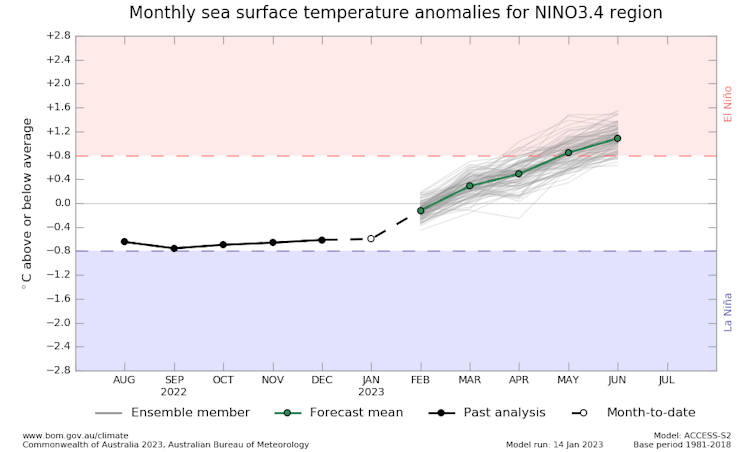
For now we have a dissipating La Niña, and there is strong confidence it will continue to weaken over the coming weeks. We expect it to be properly finished by the end of summer.
The Likelihood Of El Niño Forming
As we look further ahead, our confidence in what will happen next reduces. BOM’s outlook suggests El Niño conditions could arrive by late autumn, but other forecast models point to a lower chance of El Niño emerging at all.
Forecasts of El Niño are challenging several months in advance, but particularly at this time of year when they have to overcome the “autumn predictability barrier”. In autumn, there is less variation in the Pacific Ocean’s temperature and it’s harder to forecast if an El Niño or La Niña will emerge by winter.
We are by no means guaranteed a switch to El Niño, but there is a higher probability of an El Niño forming in the next few months than we’ve seen for several years.
Australia is also affected by other natural climate drivers, such as the Indian Ocean Dipole, which has a strong effect on winter weather. This climate driver is brought about by interactions between ocean currents and the atmosphere, and influences rainfall patterns around the Indian Ocean, including Australia.
It’s currently forecast to move into a “positive phase” by early winter, which would favour a drier winter over most of Australia as well but this is also still uncertain.
From Floods To Drought?
With indications of a shift to El Niño and positive Indian Ocean Dipole, should we expect to swing from floods to drought?
Drought occurs on different timescales, but Australia’s most devastating droughts, which result in major agricultural losses and water restrictions, require several years of dry conditions.
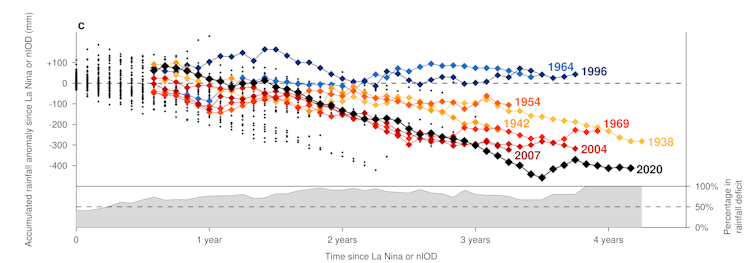
With our dams full, it’s unlikely we’ll see a major drought form for a while. If we have an extended period without La Niña or negative Indian Ocean Dipole conditions, then drought may start to appear again. However, the drier weather would also raise the risks of other hazards such as heatwaves and bushfires.
The horror 2019-2020 fire season came off the back of a weak El Niño and a strongly positive Indian Ocean Dipole. Indeed, Australia’s hottest summer on record was during the El Niño of 2018-2019.
This time, our three consecutive La Niña events have resulted in more vegetation growth. This means next summer, there will be more fuel for fires to burn.
New Heights For Global Temperatures
El Niño doesn’t just affect Australia. For example, during El Niño events we typically see a weaker Indian monsoon and drier conditions over southern Africa. East Africa, which has suffered greatly from drought in recent times, is usually wetter during El Niño.
As El Niño events involve the warming of a large area of the Pacific Ocean they tend to raise the global average surface temperature by about one-tenth of a degree. While that might not sound like very much, it could push the global average surface temperature to record-breaking highs, particularly in the year after an El Niño forms.
Given the planet is rapidly warming due to our continuing high greenhouse gas emissions, and the fact we haven’t had a big El Niño for a while, even a moderate El Niño could mean the world experiences a new record hot year.
There is even the possibility the global average temperature could surpass 1.5℃ above pre-industrial levels for the first time.
While we’re aiming to keep global warming under 1.5℃ to meet the Paris Agreement, an individual year above this mark does not mean we have failed. Still, it’s not a good sign if we start to hit that mark.
Is Climate Change Altering El Niño?
It’s not yet clear exactly how climate change may be altering El Niño. However, there are indications climate change may be moving El Niño events towards the central Pacific nearer the international dateline.
Climate change could also possibly strengthen rainfall responses to El Niño and La Niña over the Pacific and elsewhere. This may worsen both our floods and droughts in Australia, but more research is needed.
Unfortunately, in terms of global temperatures and Australian heatwaves, it’s clear the combination of human-caused climate change and a major El Niño event increases the likelihood of record-breaking events. An El Niño may not be a welcome a reprieve from the past few soggy years. ![]()
Andrew King, Senior Lecturer in Climate Science, The University of Melbourne
This article is republished from The Conversation under a Creative Commons license. Read the original article.
Let buyers jump the queue for electric cars by importing them directly

If Australia is to decarbonise our energy system by 2050, we need to start the transition to electric vehicles very soon. Cars sold in the 2030s will mostly still be on the road in 2050, so we have to make sure most of them are electric. But electric cars (including plug-in hybrids) currently account for only 3.5% of new car sales in Australia.
The world leader is Norway, where 87.6% of new cars (including 4.8% plug-in hybrids) are electric. Australia’s figure is also far lower than in Europe (27.7%, including 10.4% plug-in hybrids), China (35%, 25% fully electric) or even the United States (7.1%, 5.8% fully electric).
However, even in Norway the proportion of cars on the road that are electric – although impressive compared to the rest of the world – is still only 20%. This difference reflects the time it takes to replace an existing fleet of internal combustion engine cars.
Why Are Sales So Low In Australia?
Why has Australia done so badly? The overt hostility of the previous government to electric vehicles can’t have helped. Prime Minister Scott Morrison even claimed Labor wanted to “abolish the weekend” with its electric vehicle policy.
But the Morrison government has been gone for the better part of a year now and electric vehicle sales, while growing, remain very low.
The two core issues faced by Australians wanting to buy electric vehicles are affordability and lack of availability. Despite some recent modest price reductions, Teslas are priced out of reach of most private car buyers. They also face long delivery delays. Would-be buyers of many other brands face similar problems.
Australian governments have done little, if anything, to encourage the transition to electric vehicles. Almost uniquely among developed countries, Australia has neither a carbon price nor vehicle fuel-efficiency standards.
The Victorian state government even taxes electric and hybrid vehicles for their road use. South Australia had a similar tax, but has abolished it.
There have been a few positive measures, mostly at the state level. Although the federal government has legislated an exemption from fringe benefits tax, it offers no direct benefit to individual car buyers. The government’s development of a national EV strategy may lead to other initiatives.
But incentives don’t make much difference if it is impossible to buy a vehicle. Until recently, delivery delays could be explained as part of general COVID-related disruptions and restrictions introduced to control the pandemic.
But those restrictions are mostly gone now, and remaining supply disruptions haven’t stopped millions of European and Chinese buyers from getting behind the wheel.
Industry’s Structure Is A Barrier
A critical problem is that the Australian retail motor industry has a structure designed for the 20th century, when a small number of locally made cars, powered by internal combustion engines, dominated the roads. Retailers, typically franchisees for one of the major manufacturers, provided not only a distribution channel, but highly profitable after-sales service.
With the end of Australian manufacturing, this no longer makes a lot of sense. The requirement to buy through an authorised dealer, like other systems of this kind, allows overseas producers to raise car prices for Australian consumers, with few offsetting benefits. They can also supply the market with fuel-inefficient models.
The problem is even worse for electric vehicles. Compared to vehicles with internal combustion engines, electric vehicles have many fewer moving parts and much less need for costly servicing.
The most important component, the battery, has an estimated life of up to 20 years. There’s no transmission, spark plugs, timing belt or air filter to worry about. Profits on all of these items enable car dealers to reduce the sticker price on fossil-fuelled vehicles, making them much easier to sell.
Parallel Importing Is Part Of The Solution
One step towards solving this problem would be to allow consumers to import new and used cars from overseas suppliers. This is known as “parallel importing”.
Consumers have already seen the benefits of parallel importing for items including books, music and a wide variety of consumer goods. In some cases, such as that of books, parallel importing can be done only by individual consumers; in others it is open to firms that wish to compete with existing distribution channels.
Australia is far behind the rest of the world in the transition from fossil-fuelled vehicles. To avoid falling further behind, we need to change the kinds of vehicles we import.
A fuel-efficiency standard would discourage the dirtiest of our current vehicles. While increasing the upfront sale price, it would save drivers money in the long run.
Parallel importing would increase competition in the market for new and used electric vehicles overnight. Manufacturers would have to reconsider their supply and pricing strategies for Australia.
Allowing independent importation would also promote the development of a skilled workforce to service the cars. It could even allow the development of local manufacturing of electric vehicle components.![]()
John Quiggin, Professor, School of Economics, The University of Queensland and Flavio Menezes, Professor of Economics, Director of the Australian Institute for Business and Economics, The University of Queensland
This article is republished from The Conversation under a Creative Commons license. Read the original article.
How to maximise savings from your home solar system and slash your power bills

Soaring electricity prices have made 15% of Aussies think about installing solar panels, a recent survey found. Another 6% were already weighing up the move, on top of the 28% who had panels.
With costs falling, the average system size is growing rapidly. Households now typically install 8-10kW solar systems, often with a battery – roof area often limits the system’s size.
But does that guarantee no future electricity costs? No, some are still paying stubbornly high bills.
This is because they are often feeding energy into the grid during peak sunshine hours, when retailers pay low feed-in tariffs of five cents per kWh or less (a response to surging rooftop solar generation). To encourage customers to use energy at these times, retailers offer generous time-of-use (“solar sponge”) tariffs.
But the cost doubles during peak demand periods (around 6-10am and 3-11pm) when solar output is low or zero. Most rooftop solar owners are still paying for the electricity they use then.
The solution is a matter of getting three things right:
choosing efficient appliances
using smart technology or simple timers to run them during times of ample solar generation
choosing a retail electricity plan that best matches your use.
How Much Difference Can Appliances Make?
To cut energy costs, the starting point is to understand your usage patterns.

Heating and cooling account for 30-45% of typical home energy use. Our testing at the University of South Australia suggests air conditioners use more energy as they age. Yet many homes have air conditioners older than ten years with 2-3 star ratings. Modern split systems with 6 stars use less than half as much electricity.
Users can program or control air conditioners remotely with a mobile phone to run for an hour or two before getting home. They then use cheap solar electricity to create a comfortable home. Smart and affordable controllers can also reduce cooling or heating when they sense a room is unoccupied or windows are open.
Typically, another quarter to a third of energy use is for water heating. Ample solar electricity and soaring gas prices make heat pump water heaters the best option. With government subsidies, their initial cost is similar to conventional gas or electric systems and they typically use a third of the energy.
Again, they can be programmed to heat water at times of peak solar generation and store it, thus providing almost free hot water when needed.
Many other smart appliances and lights are available. Induction cooktops deliver fast and impressive results using little electricity. Along with the microwave, air fryer and pressure cooker, they can reduce energy use. Ovens and slow cookers can be programmed to use solar power and have meals ready when we get home.
As well as having options with high star ratings, appliances to wash and dry clothes and dishes can easily be set to run during sunshine hours.
Energy-efficient fridges also cut costs. However, while people are happy to buy such fridges, our research survey found some keep the old one, using three to four times the electricity, for drinks.
Homes with swimming pools or spas are notorious for having the highest electricity bills. A pool will typically use 2,000-3,000kWh of electricity per year (depending on type of pump, hours of use and whether the pool is heated), at a cost of A$700-1,200. Solar pool heaters are an excellent alternative. A simple timer switch can ensure most power is consumed during sunshine hours.
A typical outdoor spa uses 5kW for water heating and circulating. Much heat is lost to the surroundings if you let the thermostat keep it warm all the time. By installing a timer switch, you can use solar power for heating and have the spa ready for use after working hours.

Use Smart Technology To Control Time Of Use
The key to making the best use of your solar output is avoiding energy wastage and matching the timing of energy supply with household demand. An affordable smart control system – for the whole home or individual appliances – can do this.
This system can set seven-day schedules for all appliances. It can turn off lights and air conditioning after you leave home. On a hot day, it can lower blinds and switch on the ceiling fan and air conditioner before you return, then adjust the bedroom temperature for comfortable sleep.
With improved energy supply and demand forecasting and artificial intelligence, future controllers will provide the optimal energy options with little human intervention. If smart gadgets are not for you, simple timer switches start at less than $10.
Energy storage remains a key technology for enabling use at night and on days of no sunshine. A recent Conversation article discussed home batteries.
Another emerging technology is thermal batteries for heating and cooling. During sunshine hours a reverse-cycle air conditioner generates heat or cool to store in the thermal battery (commonly as hot or chilled water) for later use.
Electric vehicles that connect to the grid will go a long way towards making better use of rooftop electricity and storing it for evening use. Their battery capacity is several times that of home batteries.

Find The Best Energy Plan For Your Home
With 45 energy retailers in southern and eastern Australia, each offering multiple tariffs, it’s no wonder consumers are confused about which one to choose. The Australian Energy Regulator provides the most reliable guide. By uploading a few basic details, including the National Meter Identifier (NMI) shown on your bill, you can find the best offers based on your recorded electricity use.
Using this site, my son, who had paid an $800 quarterly bill despite having a large solar system, achieved a potential annual bill below $1,500 simply by switching retailers. Installing a timer switch so their outdoor spa uses solar electricity, instead of paying 33c/kWh, is likely to further save up to $5 a day. Their goal of no electricity bills is becoming a reality.
We are seeing the emergence of a new Australian dream of living in a well-designed home with rooftop solar, an electric car and smartly controlled energy-efficient appliances. It will enable most single/double-storey households to be carbon-neutral while living in comfort without a big hit to their hip pockets.![]()
Wasim Saman, Emeritus Professor of Sustainable Energy Engineering, University of South Australia
This article is republished from The Conversation under a Creative Commons license. Read the original article.
What do oranges, coffee grounds and seaweed have in common? They outshine cotton in sustainable fashion
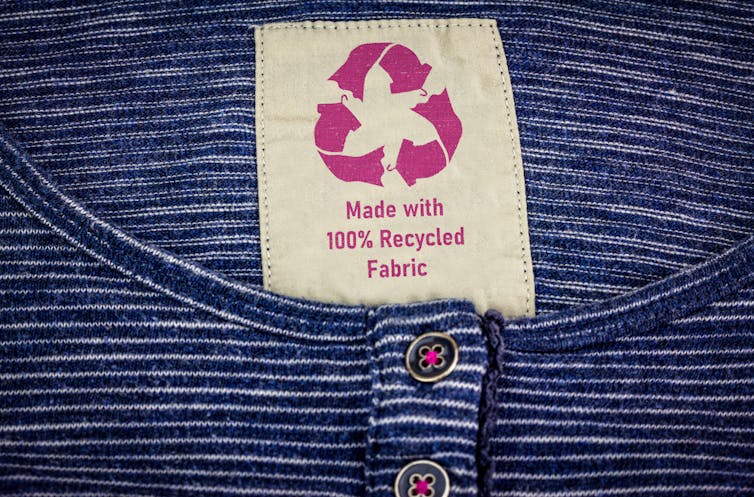
Ever considered the carbon footprint of manufacturing your favourite shirt?
The average cotton shirt produces 2.1 kilograms of carbon dioxide – but a polyester shirt produces over twice as much (5.5 kilograms). It might come as no surprise that the fashion industry is responsible for around 5% of global CO₂ emissions.
Some natural fibres can also take a heavy toll on the environment. Last week, for example, an ABC investigation revealed hundreds of hectares of the Northern Territory’s pristine tropical savanna had been cleared to make way for cotton farms, sometimes without permit.
So, are there more sustainable textiles we should be producing and purchasing instead?
Research, including our own ongoing research, points to certain “non-traditional fibres” as new green alternatives. These include fibres produced from wastes – think coffee waste and recycled plastic bottles – as well as seaweed, orange, lotus, corn and mushroom.
Brands such as Patagonia, Mud Jeans, Ninety Percent, Plant Faced Clothing and Afends are among the brands leading the way in incorporating sustainable fibres into their products. But the true turning point will likely come when more of the biggest names in fashion get involved, and it’s high time they invest.
The Problems With Traditional Fibres
There are two types of traditional fibres: natural and synthetic. Natural fibres, such as cotton and flax, have certain advantages over synthetic fibres which are derived from oil and gas.
When sustainability is considered, natural fibres are preferred over the synthetic fibres due to, for instance, their ability to biodegrade and their availability in the environment.
However, some natural fibres (particularly cotton) need a lot of fresh water and chemicals that are toxic to the environment for harvesting. For example, it takes 10,000 litres of water on average to grow just 1 kilogram of cotton.
In comparison, synthetic fibres consume a significantly lower amount of water (about one hundredth), but a significantly higher amount of energy.
Petrochemical fibres made from fossil fuels – such as polyester, nylon and acrylic – are the backbone of fast fashion. Yet another big problem with such products is that they don’t easily decompose.
As they slowly break down, petrochemical fibres release microplastics. These not only contaminate the environment, but also enter the food chain and pose health risks to animals and humans.
You may have also come across blended fabrics, which are produced with a combination of two or more types of fibres. But these pose challenges in sorting and recycling, as it’s not always possible or easy to recover different fibres when they’re combined.

Non-Traditional Fibres: A Potential Game Changer
Amid the overconsumption of traditional fibres, several global fashion brands have started to adopt new fibres derived from seaweed, corn, and mushroom. This includes Stella McCartney, Balenciaga, Patagonia, and Algiknit.
Other emerging natural fibres include lotus, pineapple and banana fibres. Lotus fibres are extracted from the plant stem, banana fibres are extracted from the petiole (the stalk that connects the leaf and stem), and pineapple fibres are extracted from pineapple leaves.
The process of extracting fibres from wastes such as orange peels, coffee grounds, and even from the protein of waste milk, has also been well researched, and clothes have been successfully manufactured from these materials.
All these examples of non-traditional fibres are free from many of the problems mentioned earlier, such as heavy resource consumption (particularly fresh water), use of toxic chemicals, and the use of large amounts of energy (for synthetic fibres).
Further, these fibres are biodegradable at their end of life and don’t release microplastics when you wash them.
Meanwhile, there has been tremendous growth in the use of recycled synthetic fibres, which reduces the use of virgin materials, energy and chemical consumption. Recycling plastics such as drink bottles to make clothing is also becoming more common. Such innovations can help lower our dependency on raw materials and mitigate plastic pollution.

What’s more, the selection of appropriate colour combinations during recycling and processing for fabrics can avoid the need for dyeing.
What Now?
Fashion companies can reduce the load on the environment through seriously investing in producing sustainable fibres and fabrics. Many are still in research stage or not receiving wider commercial applications.
Fashion manufacturers, large fashion brands and retailers need to invest in the research and development to scale-up production of these fibres. And machine manufacturers also need to develop technologies for large-scale harvesting and manufacturing raw materials, such as sustainable fibre and yarn.
At the same time, you, as a consumer, have an important role to play by demanding information about products and holding brands accountable.![]()
Rajkishore Nayak, Associate Professor , RMIT University Vietnam
This article is republished from The Conversation under a Creative Commons license. Read the original article.
Pittwater Reserves: Histories + Notes + Pictorial Walks
A History Of The Campaign For Preservation Of The Warriewood Escarpment by David Palmer OAM and Angus Gordon OAM
A Walk Around The Cromer Side Of Narrabeen Lake by Joe Mills
America Bay Track Walk - photos by Joe Mills
An Aquatic June: North Narrabeen - Turimetta - Collaroy photos by Joe Mills
Angophora Reserve Angophora Reserve Flowers Grand Old Tree Of Angophora Reserve Falls Back To The Earth - History page
Annie Wyatt Reserve - A Pictorial
Avalon's Village Green: Avalon Park Becomes Dunbar Park - Some History + Toongari Reserve and Catalpa Reserve
Bairne Walking Track Ku-Ring-Gai Chase NP by Kevin Murray
Bangalley Headland Bangalley Mid Winter
Banksias of Pittwater
Barrenjoey Boathouse In Governor Phillip Park Part Of Our Community For 75 Years: Photos From The Collection Of Russell Walton, Son Of Victor Walton
Barrenjoey Headland: Spring flowers
Barrenjoey Headland after fire
Bayview Baths
Bayview Wetlands
Beeby Park
Bilgola Beach
Botham Beach by Barbara Davies
Bungan Beach Bush Care
Careel Bay Saltmarsh plants
Careel Bay Birds
Careel Bay Clean Up day
Careel Bay Playing Fields History and Current
Careel Creek
Careel Creek - If you rebuild it they will come
Centre trail in Ku-ring-gai Chase National Park
Chiltern Track- Ingleside by Marita Macrae
Clareville Beach
Clareville/Long Beach Reserve + some History
Coastal Stability Series: Cabbage Tree Bay To Barrenjoey To Observation Point by John Illingsworth, Pittwater Pathways, and Dr. Peter Mitchell OAM
Cowan Track by Kevin Murray
Curl Curl To Freshwater Walk: October 2021 by Kevin Murray and Joe Mills
Currawong and Palm Beach Views - Winter 2018
Currawong-Mackerel-The Basin A Stroll In Early November 2021 - photos by Selena Griffith
Currawong State Park Currawong Beach + Currawong Creek
Deep Creek To Warriewood Walk photos by Joe Mills
Drone Gives A New View On Coastal Stability; Bungan: Bungan Headland To Newport Beach + Bilgola: North Newport Beach To Avalon + Bangalley: Avalon Headland To Palm Beach
Duck Holes: McCarrs Creek by Joe Mills
Dunbar Park - Some History + Toongari Reserve and Catalpa Reserve
Dundundra Falls Reserve: August 2020 photos by Selena Griffith - Listed in 1935
Elsie Track, Scotland Island
Elvina Track in Late Winter 2019 by Penny Gleen
Elvina Bay Walking Track: Spring 2020 photos by Joe Mills
Elvina Bay-Lovett Bay Loop Spring 2020 by Kevin Murray and Joe Mills
Fern Creek - Ingleside Escarpment To Warriewood Walk + Some History photos by Joe Mills
Iluka Park, Woorak Park, Pittwater Park, Sand Point Reserve, Snapperman Beach Reserve - Palm Beach: Some History
Ingleside
Ingleside Wildflowers August 2013
Irrawong - Ingleside Escarpment Trail Walk Spring 2020 photos by Joe Mills
Irrawong - Mullet Creek Restoration
Katandra Bushland Sanctuary - Ingleside
Lucinda Park, Palm Beach: Some History + 2022 Pictures
McCarrs Creek
McCarr's Creek to Church Point to Bayview Waterfront Path
McKay Reserve
Mona Vale Beach - A Stroll Along, Spring 2021 by Kevin Murray
Mona Vale Headland, Basin and Beach Restoration
Mount Murray Anderson Walking Track by Kevin Murray and Joe Mills
Mullet Creek
Narrabeen Creek
Narrabeen Lagoon Catchment: Past Notes Present Photos by Margaret Woods
Narrabeen Lagoon State Park
Narrabeen Lagoon State Park Expansion
Narrabeen Rockshelf Aquatic Reserve
Nerang Track, Terrey Hills by Bea Pierce
Newport Bushlink - the Crown of the Hill Linked Reserves
Newport Community Garden - Woolcott Reserve
Newport to Bilgola Bushlink 'From The Crown To The Sea' Paths: Founded In 1956 - A Tip and Quarry Becomes Green Space For People and Wildlife
Pittwater spring: waterbirds return to Wetlands
Pittwater's Lone Rangers - 120 Years of Ku-Ring-Gai Chase and the Men of Flowers Inspired by Eccleston Du Faur
Pittwater's Parallel Estuary - The Cowan 'Creek
Resolute Track at West Head by Kevin Murray
Resolute Track Stroll by Joe Mills
Riddle Reserve, Bayview
Salvation Loop Trail, Ku-Ring-Gai Chase National Park- Spring 2020 - by Selena Griffith
Seagull Pair At Turimetta Beach: Spring Is In The Air!
Stapleton Reserve
Stapleton Park Reserve In Spring 2020: An Urban Ark Of Plants Found Nowhere Else
Stony Range Regional Botanical Garden: Some History On How A Reserve Became An Australian Plant Park
The Chiltern Track
The Resolute Beach Loop Track At West Head In Ku-Ring-Gai Chase National Park by Kevin Murray
Topham Track Ku-Ring-Gai Chase NP, August 2022 by Joe Mills and Kevin Murray
Towlers Bay Walking Track by Joe Mills
Trafalgar Square, Newport: A 'Commons' Park Dedicated By Private Landholders - The Green Heart Of This Community
Tranquil Turimetta Beach, April 2022 by Joe Mills
Turimetta Beach Reserve by Joe Mills, Bea Pierce and Lesley
Turimetta Beach Reserve: Old & New Images (by Kevin Murray) + Some History
Turimetta Headland
Warriewood Wetlands and Irrawong Reserve
Whale Beach Ocean Reserve: 'The Strand' - Some History On Another Great Protected Pittwater Reserve
Wilshire Park Palm Beach: Some History + Photos From May 2022
Winji Jimmi - Water Maze

Friday Night Bowls For Youngsters At Newport - Avalon
Bowling clubs, traditionally speaking, are community centres where families meet to engage in social interaction and entertainment. But now there is a ‘new-wave’ interest in lawn bowls as a sport for kids. A game for senior primary and high school students, a game where 10-16 year old boys and girls can learn important skills. Skills we all value like self-discipline, concentration and learning to play with team mates of varying abilities - and all within a club’s supportive environment.
Newport and Avalon Bowling Clubs are delighted to announce that together with “Lets Play Bowls,” they will be introducing “Friday Night Bowls for Kids” to the our peninsula. The concept, developed by a group of retired teachers, a headmaster and bowlers, follows a particular format, timeline and tried and tested rules.
Starting on Friday 3 February, ‘Friday Night Bowls’ involves four weeks of coaching from 17h30 - 19h00 each Friday, followed by four competition Fridays in March. The programme will be repeated in October and November with the ‘final competition’ taking place in December 2023. All bowls will be provided by the clubs.
President of Newport Bowling Club, Fred Murray-Walker, believes that growing interest among junior bowlers could lead to the development of a Junior League with inter-club and even inter- state competitions. “We may even have a Northern Beaches Commonwealth bowler one day,” says Fred.
‘Friday Night Bowls’ is already achieving enormous success in rural NSW. Dubbo Bowls club recently had over 60 primary school children competing in teams of three against each other. Warren Boyd, LPB coordinator, says “The kids loved it and parents too, have been very excited to get involved in supporting this quality after school activity.”
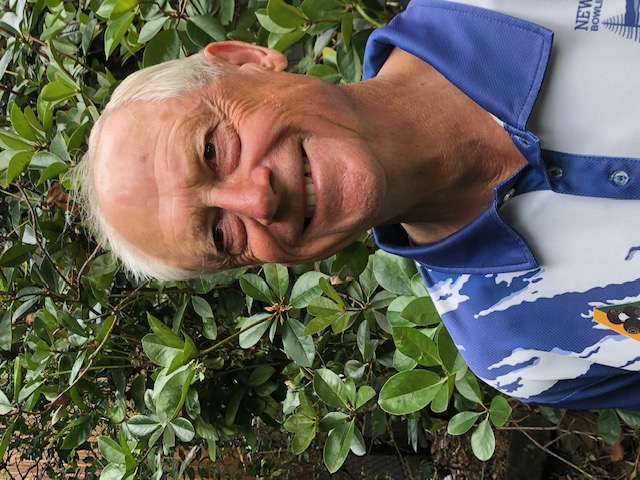
Fred Murray-Walker,
The cost per child is $10 per year and this is payable at your local bowling club. All fees go to “Lets Play Bowls” for the further development of the program. Registration must be done on the Lets Play Bows website: www.letsplaybowls.com
Dennis Heath, head coach at Avalon Bowls, has been working with High School students for some time. He says “Bowls is becoming a cool sport to play. Once kids are playing they come to love the game, this has been proven many times over. It’s a sport they can play with their friends, their parents and even their grandparents.”
Come on down to Newport or Avalon and give bowls a go!

Getting Some Air At South Av.
Saturday January 21, 2023
School Leavers Support
- Download or explore the SLIK here to help guide Your Career.
- School Leavers Information Kit (PDF 5.2MB).
- School Leavers Information Kit (DOCX 0.9MB).
- The SLIK has also been translated into additional languages.
- Download our information booklets if you are rural, regional and remote, Aboriginal or Torres Strait Islander, or living with disability.
- Support for Regional, Rural and Remote School Leavers (PDF 2MB).
- Support for Regional, Rural and Remote School Leavers (DOCX 0.9MB).
- Support for Aboriginal and/or Torres Strait Islander School Leavers (PDF 2MB).
- Support for Aboriginal and/or Torres Strait Islander School Leavers (DOCX 1.1MB).
- Support for School Leavers with Disability (PDF 2MB).
- Support for School Leavers with Disability (DOCX 0.9MB).
- Download the Parents and Guardian’s Guide for School Leavers, which summarises the resources and information available to help you explore all the education, training, and work options available to your young person.
School Leavers Information Service
- navigate the School Leavers Information Kit (SLIK),
- access and use the Your Career website and tools; and
- find relevant support services if needed.
Word Of The Week: Umpteen
adjective
very many : indefinitely numerous, a large unspecified number.
From: blend of umpty (such and such) and -teen (as in thirteen), first known use was 1898
Used in:
"I'll go to bed and I'll not get up for umpty-eleven months."
The speaker here is war-weary Bill, a character in Patrick MacGill's early 20th-century novel The Great Push.
His "umpty" originated as military slang around 1905 and stood for an indefinite number, generally largish. (It was probably created by analogy to actual numbers such as "twenty.") Soon, there followed "umpteen," blending "umpty" and "-teen."
'Umpteen' usually describes an indefinite and large number or amount.
Derived term
Adjective; umpteenth
(informal, often slightly derogatory) Occurring in a relatively large but unspecified position in a sequence.
That's the umpteenth time I've had to tell you not to swear in front of the children.
Why learning to surf can be great for your mental health, according to a psychologist
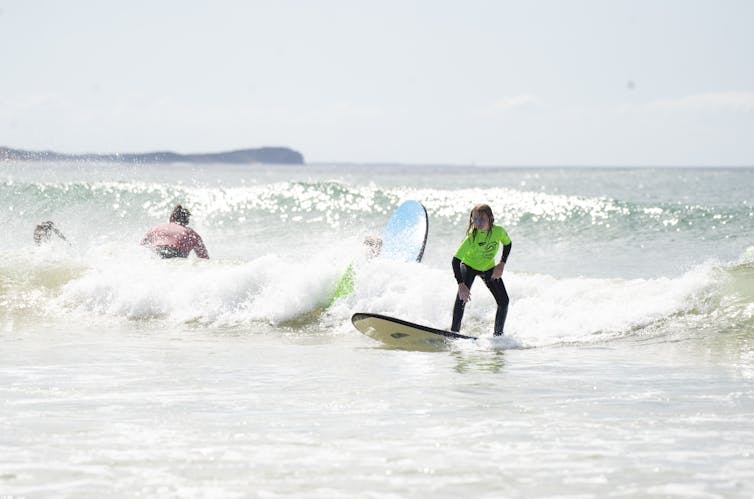
Nothing clears the mind like going for a surf. With the escapism and simplicity of riding waves, it’s no secret that surfing feels good.
Now our preliminary study in children and adolescents adds to growing evidence that surfing really is good for your mental health.
But you don’t have to have a mental illness to get the benefits. Here’s how you can use what we’re learning from our research to boost your own mental health.
How Surfing Is Good For You
Evidence showing the mental health benefits of surfing ranges from improving self-esteem and reducing social isolation to treating depression and other mental disorders.
Such evidence mainly comes from specific surf therapy programs. These combine supportive surfing instruction with one-to-one or group activities that promote psychosocial wellbeing.
At their core, most of these programs provide participants with the challenge of learning to surf in an emotionally safe environment.
Any benefits to mental health are thought to arise through:
an increased sense of social connection
a sense of accomplishment that people can transfer to other activities
respite from the day-to-day stressors due to the all-encompassing focus required when surfing
the physiological response when surfing, including the reduction of stress hormones and the release of mood-elevating neurotransmitters
exercising in a natural environment, in particular “blue spaces” (on or near water).
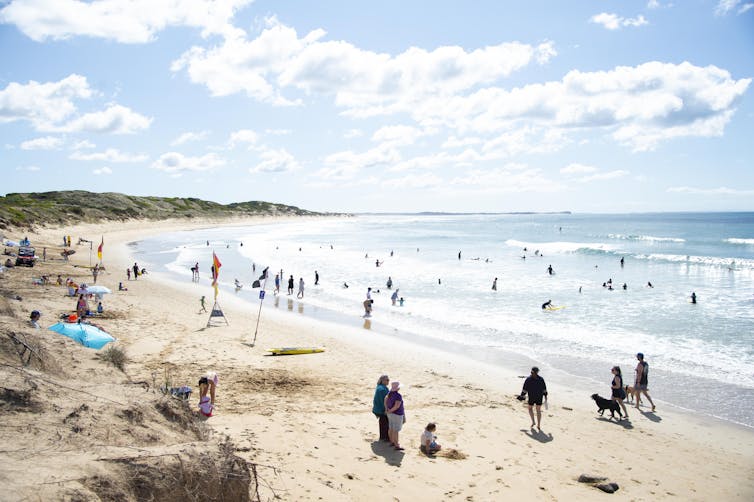
What We Did
Our pilot study aimed to see whether the Ocean Mind surf therapy program improved child and adolescent mental health.
We also wanted to see whether participants accepted surfing as a way to address their mental health concerns.
The study involved 36 young people, 8–18 years old, who were seeking help for a mental health concern, such as anxiety, or a neurodevelopmental disorder (attention deficit hyperactivity disorder or autism spectrum disorder). They were referred by their mental health provider, GP or school counsellor.
Participants were allocated at random to the Ocean Mind surf therapy program or were placed on a waitlist for it. Those allocated to surf therapy continued with their usual care, which included case management from a mental health provider. Those on the waitlist (the control group) also continued with their usual care.
The surf therapy program ran for two hours every weekend for six weeks. Young people were partnered one-to-one with a community mentor who received training in mental health literacy and surf instruction.
Each session included supportive surf instruction and group mental health support, all conducted at the beach. Sessions were run by the program coordinator who was also trained in mental health and surf instruction.
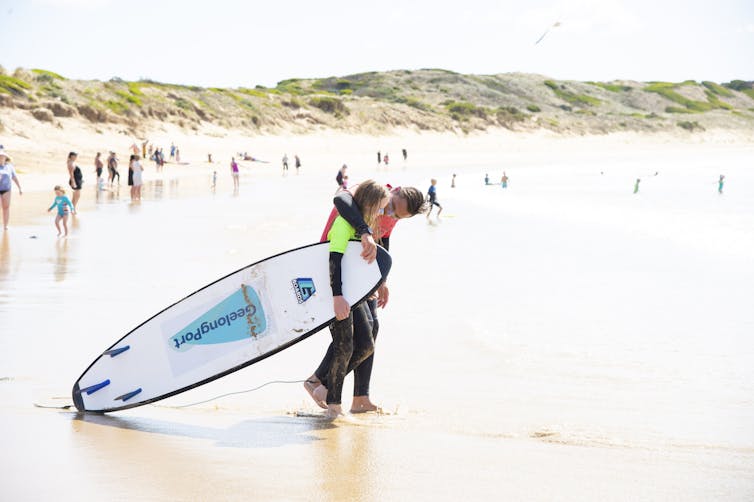
What We Found
By the end of the six-week program, those receiving surf therapy had reductions in depression, anxiety, hyperactivity and inattention symptoms, as well as fewer emotional and peer problems. This was compared with those in the control group, who had increases in these symptoms.
However, any improvements were not sustained six weeks after the program finished.
Those receiving surf therapy also saw it as a suitable, youth-friendly way to manage symptoms of mental ill-health. This was further supported by the high completion rates (87%), particularly when compared with other methods of mental health treatment. For instance, psychotherapy (talk therapy) has been reported to have a 28–75% drop-out rate for children and adolescents.
It’s Early Days
These early findings are promising. But given this was a pilot study, more research is needed with larger numbers of participants to confirm these outcomes and see if they generalise to broader populations.
We’d like to identify the best dose of surf therapy in terms of session frequency, duration, and program length.
We also need to understand the factors that maintain these initial positive changes in mental health, so any benefits can be sustained after the program finishes.
The recognition of surfing as a potentially effective and acceptable mental health treatment among young people is also promising. But this finding does not preclude the more conventional clinical treatments, such as talk therapy and medication, which may work better for certain people.
Rather, surf therapy may be seen as an additional form of support alongside these approaches or an alternative for those who do not benefit from more traditional methods.

Tempted To Try Surfing?
If you think surfing might be for you, remember:
surfing requires complete focus due to the ever-changing conditions of the ocean, making it a great way to step away from day-to-day life and wipe out the effects of stress
for some people, surfing may reduce barriers to seeking mental health care
surfing may not be for everyone, nor can it guarantee to reduce your symptoms. Even the best surfers can suffer from depression and may require external support
don’t worry if you cannot access the ocean or a surfboard. Other nature-based activities, such as hiking and gardening, can also benefit your mental health.
If this article has raised issues for you, or if you’re concerned about someone you know, call Lifeline on 13 11 14 or Kids Helpline on 1800 55 1800.![]()
Lisa Olive, Senior Research Fellow & Clinical Psychologist, Deakin University
This article is republished from The Conversation under a Creative Commons license. Read the original article.
Finding your essential self: the ancient philosophy of Zhuangzi explained

Zhuangzi – also known as Zhuang Zhou or Master Zhuang – was a Chinese philosopher who lived around the 4th century BCE. He is traditionally credited as the author of the ancient Taoist masterpiece bearing his name, the Zhuangzi.
The work of Zhuangzi has been described as “humorous and deadly serious, lighthearted and morbid, precisely argued and intentionally confusing”. On the surface, his teachings can seem outright nonsensical. He maintains that “listening stops with the ear”, that we should “hide the world in the world”, and that a person on the right path is “walking two roads”.
But Zhuangzi delights in paradox. His philosophy deliberately toys with words to reveal that language itself is the foremost barrier in our search for our essential selves and our desire to live happy, fulfilled lives.
For Zhuangzi, words hold everything that is extraneous to our essential selves:
The fish trap exists because of the fish. Once you’ve gotten the fish you can forget the trap. The rabbit snare exists because of the rabbit. Once you’ve gotten the rabbit, you can forget the snare. Words exist because of meaning. Once you’ve gotten the meaning, you can forget the words. Where can I find a man who has forgotten words so I can have a word with him?
Words are like vessels for conventional distinctions and values we inherit from the past. But language, as the bearer of social ideals and expectations, becomes the source of the irresolution, trouble and anguish that denies us our contentment and tranquillity.
Sharing the view expressed in Laozi’s Tao Te Ching, Zhuangzi argues that we must first be disorientated by language to discover that higher knowledge is beyond words.
The Hundred Schools Of Thought
Zhuangzi was a harsh critic of the dominant and demanding ideals of his time.
What is known as the Golden Age of Chinese Philosophy lasted from the sixth to the third century BCE in the period of the Zhou dynasty. The flourishing of different philosophical views during that time is known as the Hundred Schools of Thought.
Intellectual society existed to guide society and its rulers towards the Way (also known as the Tao) – the central concept and practical feature of Taoism.
The two dominant schools of the Hundred Schools of Thought were Confucianism and Mohism. Broadly speaking, Confucianism centralises ritual propriety and familial piety as just some of the necessary virtues of the “gentleman” – that is, the upstanding and model citizen or ruler.
The Mohists were critical of the Confucians. They advocated a calculated impartiality in our distribution of care – a view in many ways reminiscent of what the West would later term “utilitarianism”.

A common critique of Confucianism is that it places too much emphasis on social order through rituals and hierarchies. One could argue, with respect to the Mohists, that too much emphasis is placed on establishing a universal moral principle in a way that risks overlooking the complex features of our individual moral lives.
Zhuangzi opposed the full spectrum of such views, supposing instead that being persuaded by the Confucians or the Mohists, for example, depended largely on one’s individual perspective. Traditions and schools of thought set transcendental ideals, which risk drawing our souls out of us in their quest for righteousness and truth.
For Zhuangzi, what really matters is that we maintain a sensible, sceptical distance from conventional distinctions and resist committing to any one specific worldview.
Right is not right; so is not so. If right were really right, it would differ so clearly from not right that there would be no need for argument. If so were really so, it would differ so clearly from not so that there would be no need for argument. Forget the years; forget distinctions. Leap into the boundless and make it your home!
Adopting a healthy scepticism towards inherited ideas means “emptying the container of the Self”, or perhaps exercising a kind of trained “forgetting” of that which is extraneous to the essential self. In this state, we become less prone to partaking in the superfluous occupations we impose upon ourselves to cope with the weight of social expectations.
This is what Zhuangzi means when he argues that we must train our ability to be in and not of the world.
So the sage wanders in what exists everywhere and can’t be lost. He likes growing old and he likes dying young. He likes the beginning and he likes the end.
We should not be overly sceptical, however. “Words are not just blowing wind.” We must simply remember that words “have something to say” and that language is only a repository for meanings, not meaning itself.
In the same way, Zhuangzi argues that we cannot deny we are social animals. Certain duties are inescapable features of the roles in which we find ourselves. To be in the world and not of it means we accept what is beyond our control with equanimity.

Theraputic Scepticism And The Butterfly Dream
Zhuangzi’s most celebrated parable is about a dream:
Once upon a time, I, Zhuangzi, dreamt I was a butterfly, fluttering hither and thither, to all intents and purposes a butterfly. I was conscious only of my happiness as a butterfly, unaware that I was Zhuangzi. Soon I awakened, and there I was, veritably myself again. Now I do not know whether I was then a man dreaming I was a butterfly, or whether I am now a butterfly, dreaming I am a man.
In entertaining for a moment the idea that we might be dreaming we are a butterfly that is dreaming it is human, we engage in the very activity which allows us to break free of the normal and human way of understanding the world. This is a kind of therapeutic scepticism.
The adoption of this more universal perspective makes our understanding more holistic and more exciting. With practice, our ordinary lives can become imbued with moments of spontaneous awe. We can learn to see the transformation of things – how everything eventually becomes part of something else. In questioning the world around us, we transcend our own limited perspective and ignite a boundless curiosity about everything in the cosmos.
In the 20th century, the philosopher and novelist Iris Murdoch described the highest virtue necessary for living a fulfilled life as a kind of “unselfing”.
“Good is a transcendent reality,” she wrote, and unselfing, or engaging in this therapeutic act of scepticism, allows us to “pierce the veil of selfish consciousness and join the world as it really is”.
Zhuangzi and Murdoch might agree that our ability to transcend our human perspective – to see the world as a butterfly – just is what makes us human. We can find our essential selves when we are open to our vast capacity for imagination and creativity. We can free ourselves of the distinctions, ideas and traditions that become imprisoned in the words we use.
A final thought: perhaps Zhuangzi is best left uninterpreted. I will leave you with a line which, for me, is reminiscent of the Gadfly of Athens, Socrates, and his desire for knowledge. But what it really means is up to you:
People all seek to know what they do not know yet; they ought rather to seek to know what they know already.
Oscar Davis, Indigenous Fellow - Assistant Professor in Philosophy and History, Bond University
This article is republished from The Conversation under a Creative Commons license. Read the original article.
‘A voice like cigarettes rolled in honey’: celebrating Renée Geyer, Australia’s queen of soul

Renée Geyer’s name is often in histories of Australian music. A pioneering artist, her iconic soul sound opened up the local conversation about what “sounding Australian” meant. Go-Betweens icon and industry legend Lindy Morrison simply said: “Renée Geyer was an exception to the rule”.
Born Renée Rebecca Geyer in Melbourne in 1953, to migrant parents from Slovakia and Hungary, her mother was a Holocaust survivor. She began in bands Dry Red and Sun, and released her debut self-titled album at 20 years old. She appeared regularly on local television, radio and in print. Her confidence then, and for the rest of her life, was captivating, although she explained that it didn’t come easily and without sacrifice.
Geyer’s work as a collaborator and interpreter of other people’s words was a fundamental part of her own artistry. For many, her interpretation of James Brown’s It’s a Man’s World will remain just as, if not more moving, than the songwriter’s own. Other hits from the time included Heading in the Right Direction, Stares and Whispers and later Say I Love You.
Over her career she released 24 albums, including collections of original songs, live albums and the odd tribute record or two. Into the 1970s, 80s, 90s and 2000s she worked in Australia and the US, singing with international greats like Sting and Joe Cocker, as well as the best of local rock, pop and soul royalty.
She was also fond of popping up in unusual places, such as standing in for PJ Harvey in a version of Henry Lee for TV show Rockwiz.
In 2005 she worked with Magoo (producer for Regurgitator, Powderfinger and Silverchair) on Tonight. Magoo said “She put everything into every vocal performance (all of them in the control room right next to my head) [and] also had a great production mind”, pointing to track You Matter as an example of her keenness to continue to explore.
Cigarettes Rolled In Honey
Geyer’s vocal style was a mixture of precision and raw grit – critic Andrew P Street described it as “like cigarettes rolled in honey”. There was the rawness of Janis Joplin with the lift of her beloved Aretha Franklin – leading the way for Australian artists to explore beyond the bounds of pop, rock, folk and country.
Her approach was direct and earnest even if her persona between songs was not – Street continued to say:
If there is a music journalist in Australia not currently reflecting on the time Renée Geyer told them something gloriously unprintable in an interview, can they really call themselves a music journalist? An incredible artist. An unbelievable voice. And goddamn was she a magnificent interviewee.

I interviewed her in 2003 for the release of her 20th album, Tenderland, which was one of the most successful of her career. Her directness was refreshing – and yes, there was lots I couldn’t print – but she treated me no more ruthlessly than she did herself. Did she feel like 20 albums was a lot? Was she done?
I’m just half way, Slim Dusty had 100 albums… I would challenge anyone to go through that catalogue and find no shit in there. Sorry, rest in peace and all that, but 100 albums, give me a break! I mean I’ve done 20 and there’s maybe four gems. I’m not going to tell you which ones, I mean they’re honest compared to other stuff that was around, but for my standards there’s a few beauties there, too.
Geyer told me she was “good at conducting and bossing” when it came to music, saying, “I’ve got it all in my head, the chords in my head, but I don’t actually play.”
A ‘Difficult’ Woman
Geyer’s self-deprecating humour was delightfully disarming. It also was part of the contradiction that Paul Kelly summed up in the song he wrote for her, A Difficult Woman (1994). She used the song’s title for her album that year, and later for biography, Confessions of a Difficult Woman (2000), which candidly told stories of a very rock and roll life.
The song and the concept followed her since then, but she was also clear that it wasn’t necessary a neutral term. “They never say ‘difficult man’. But the song was beautiful”, was her summation of it. Later Kelly would record it himself, but her versions, throughout the years, continued to soar.
Her influence on Australian music was acknowledged by the ARIA Hall of Fame in 2005, the Music Victoria Hall of Fame in 2013, and the inaugural Lifetime Achievement Award at the Australian Women in Music Awards in 2018.
Kate Ceberano called her “The diva, the brutal, the shapeshifter, the irreplaceable Renée”, and Deborah Conway said “Australia’s Queen of Soul has made her final exit stage left […] She made me laugh, she pissed me off but she was never, ever boring, and she made my life the richer for knowing her.”![]()
Liz Giuffre, Senior Lecturer in Communication, University of Technology Sydney
This article is republished from The Conversation under a Creative Commons license. Read the original article.
How to unlock your creativity – even if you see yourself as a conventional thinker

Do you think that creativity is an innate gift? Think again.
Many people believe that creative thinking is difficult – that the ability to come up with ideas in novel and interesting ways graces only some talented individuals and not most others.
The media often portrays creatives as those with quirky personalities and unique talent. Researchers have also identified numerous personality traits that are associated with creativity, such as openness to new experiences, ideas and perspectives.
Together, they seem to paint a dire picture for those who consider themselves conventional thinkers, as well as those who do not work in creative occupations – including roles that are often considered traditional and noncreative, such as accountants and data analysts.
These beliefs miss a key part of how creativity works in your brain: Creative thinking is actually something you engage in every day, whether you realize it or not.
Moreover, creativity is a skill that can be strengthened. This matters even for people who don’t consider themselves creative or who aren’t in creative fields.
In research that I recently published with organization and management scholars Chris Bauman and Maia Young, we found that simply reinterpreting a frustrating situation can enhance the creativity of conventional thinkers.
Using Creative Thinking To Cope With Emotions
Creativity is often defined as the generation of ideas or insights that are novel and useful. That is, creative thoughts are original and unexpected, but also feasible and useful.
Everyday examples of creativity are plentiful: combining leftover food to make a tasty new dish, coming up with a new way to accomplish chores, mixing old outfits to create a new look.
Another way you do this is when you practice what’s called “emotional reappraisal” – viewing a situation through another lens to change your feelings. There is an element of creativity to this: You’re breaking away from your existing perspectives and assumptions and coming up with a new way of thinking.
Say you’re frustrated about a parking ticket. To alleviate the bad feelings, you can think of the fine as a learning moment.
If you’re anxious about a presentation for work, you can cope with the anxiety by framing it as an opportunity to share ideas, rather than as a high-stakes performance that could result in demotion if handled poorly.
And if you’re angry that someone seemed unnecessarily combative in a conversation, you might reevaluate the situation, coming to view the behavior as unintentional rather than malicious.
Training Your Creative Muscles
To test the link between creative thinking and emotional reappraisal, we surveyed 279 people. Those who ranked higher on creativity tended to reappraise emotional events more often in their daily life.
Inspired by the link between emotional reappraisal and creative thinking, we wanted to see whether we could use this insight to develop ways to help people be more creative. In other words, could emotional reappraisal be practiced by people in order to train their creative muscles?
We ran two experiments in which two new samples of participants – 512 in total – encountered scenarios designed to provoke an emotional response. We tasked them with using one of three approaches to manage their emotions. We told some participants to suppress their emotional response, others to think about something else to distract themselves and the last group to reappraise the situation by looking at it through a different lens. Some participants were also given no instructions on how to manage their feelings.
In a seemingly unrelated task that followed, we asked the participants to come up with creative ideas to solve a problem at work.
In the experiments, conventional thinkers who tried reappraisal came up with ideas that were more creative than other conventional thinkers who used suppression, distraction or received no instructions at all.
Cultivating Flexible Thinking
Negative emotions are inevitable in work and life. Yet people often hide their negative feelings from others, or use distraction to avoid thinking about their frustrations.
Our findings have implications for how managers can think about how to best leverage the skills of their workers. Managers commonly slot job candidates into creative and noncreative jobs based on cues that signal creative potential. Not only are these cues shaky predictors of performance, but this hiring practice may also limit managers’ access to employees whose knowledge and experience can play major roles in generating creative outcomes.
The result is that the creative potential of a significant part of the workforce may be underutilized. Our findings suggest that supervisors can develop training and interventions to cultivate creativity in their employees – even for those who might not seem predisposed to creativity.
Our research also indicates that people can practice flexible thinking every day when they experience negative emotions. Although people may not always have control over the external circumstances, they do have the liberty to choose how to cope with emotional situations – and they can do so in ways that facilitate their productivity and well-being.![]()
Lily Zhu, Assistant Professor of Management, Information Systems and Entrepreneurship, Washington State University
This article is republished from The Conversation under a Creative Commons license. Read the original article.
Neanderthals: the oldest art in the world wasn’t made by Homo sapiens

One of the most hotly debated questions in the history of Neanderthal research has been whether they created art. In the past few years, the consensus has become that they did, sometimes. But, like their relations at either end of the hominoid evolutionary tree, chimpanzees and Homo sapiens, Neanderthals’ behaviour varied culturally from group to group and over time.
Their art was perhaps more abstract than the stereotypical figure and animal cave paintings Homo Sapiens made after the Neanderthals disappeared about 30,000 years ago. But archaeologists are beginning to appreciate how creative Neanderthal art was in its own right.
Homo sapiens are thought to have evolved in Africa from at least 315,000 years ago. Neanderthal populations in Europe have been traced back at least 400,000 years.
As early as 250,000 years ago, Neanderthals were mixing minerals such as haematite (ochre) and manganese with fluids to make red and black paints – presumably to decorate the body and clothing.
It’s Human Nature
Research by Palaeolithic archaeologists in the 1990s radically changed the common view of Neanderthals as dullards. We now know that, far from trying to keep up with the Homo sapiens, they had a nuanced behavioural evolution of their own. Their large brains earned their evolutionary keep.
We know from finding remains in underground caves, including footprints and evidence of tool use and pigments in places where neanderthals had no obvious reason to be that they appear to have been inquisitive about their world.
Why were they straying from the world of light into the dangerous depths where there was no food or drinkable water? We can’t say for sure, but as this sometimes involved creating art on cave walls it was probably meaningful in some way rather than just exploration.
Neanderthals lived in small, close-knit groups that were highly nomadic. When they travelled, they carried embers with them to light small fires at the rock shelters and river banks where they camped. They used tools to whittle their spears and butcher carcasses. We should think of them as family groups, held together by constant negotiations and competition between people. Although organised into small groups it was really a world of individuals.
The evolution of Neanderthals’ visual culture over time suggests their social structures were changing. They increasingly used pigments and ornaments to decorate their bodies. As I elaborate in my book, Homo Sapiens Rediscovered, Neanderthals adorned their bodies perhaps as competition for group leadership became more sophisticated. Colours and ornaments conveyed messages about strength and power, helping individuals convince their contemporaries of their strength and suitability to lead.
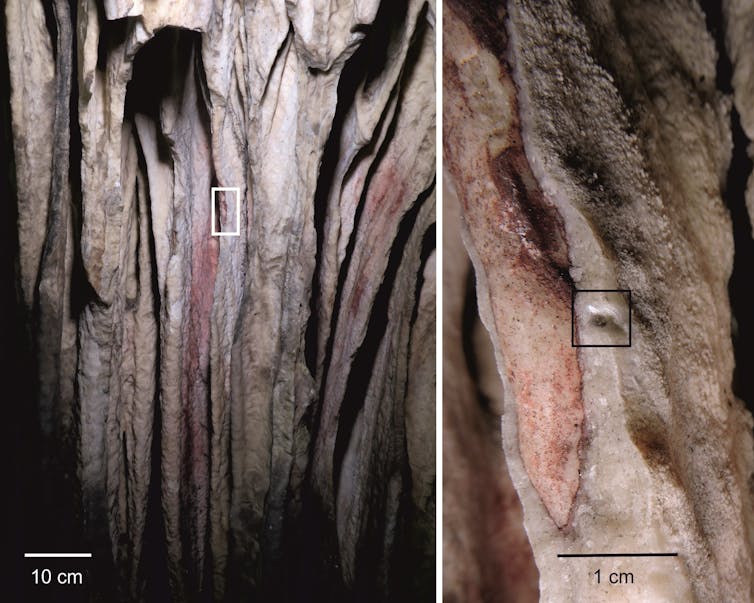
Then, at least 65,000 years ago, Neanderthals used red pigments to paint marks on the walls of deep caves in Spain. In Ardales cave near to Malaga in southern Spain they coloured the concave sections of bright white stalactites.
In Maltravieso cave in Extremadura, western Spain, they drew around their hands. And in La Pasiega cave in Cantabria in the north, one Neanderthal made a rectangle by pressing pigment-covered fingertips repeatedly to the wall.

We can’t guess the specific meaning of these marks, but they suggest that Neanderthal people were becoming more imaginative.
Later still, about 50,000 years ago, came personal ornaments to accessorise the body. These were restricted to animal body parts – pendants made of carnivore teeth, shells and bits of bone. These necklaces were similar to those worn around the same time by Homo sapiens, probably reflecting a simple shared communication that each group could understand.
Did Neanderthal visual culture differ from that of Homo sapiens? I think it probably did, although not in sophistication. They were producing non-figurative art tens of millennia before the arrival of Homo sapiens in Europe, showing that they had independently created it.
But it differed. We have as yet no evidence that Neanderthals produced figurative art such as paintings of people or animals, which from at least 37,000 years ago was widely produced by the Homo sapiens groups that would eventually replace them in Eurasia.
Figurative art is not a badge of modernity, nor the lack of it an indication of primitiveness. Neanderthals used visual culture in a different way to their successors. Their colours and ornaments strengthened messages about each other through their own bodies rather than depictions of things.
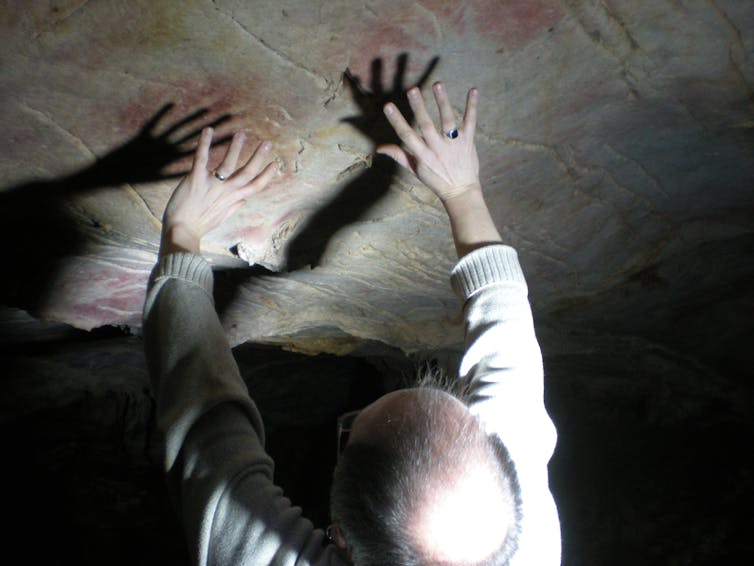
It may be significant that our own species didn’t produce images of animals or anything else until after the Neanderthals, Denisovans and other human groups had become extinct. Nobody had use for it in the biologically mixed Eurasia of 300,000 to 40,000 years ago.
But in Africa a variation on this theme was emerging. Our early ancestors were using their own pigments and non-figurative marks to begin referring to shared emblems of social groups such as repeated clusters of lines – specific patterns.
Their art appears to have been less about individuals and more about communities, using shared signs such as those engraved onto lumps of ochre in Blombos cave in South Africa, like tribal designs. Ethnicities were emerging, and groups – held together by social rules and conventions – would be the inheritors of Eurasia.![]()
Paul Pettitt, Professor in the Department of Archaeology, Durham University
This article is republished from The Conversation under a Creative Commons license. Read the original article.
From a ‘deranged’ provocateur to IBM’s failed AI superproject: the controversial story of how data has transformed healthcare
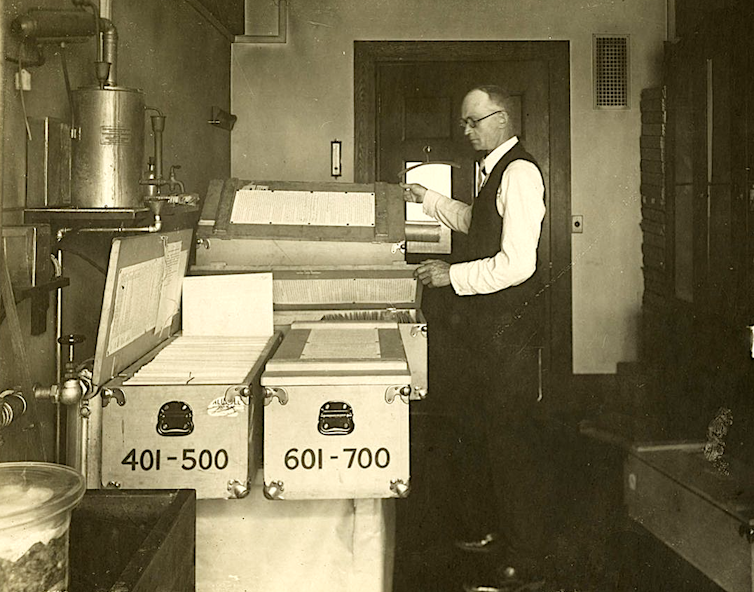
Just over a decade ago, artificial intelligence (AI) made one of its showier forays into the public’s consciousness when IBM’s Watson computer appeared on the American quiz show Jeopardy! The studio audience was made up of IBM employees, and Watson’s exhibition performance against two of the show’s most successful contestants was televised to a national viewership across three evenings. In the end, the machine triumphed comfortably.
You can listen to more articles from The Conversation, narrated by Noa, here.
One of Watson’s opponents Ken Jennings, who went on to make a career on the back of his gameshow prowess, showed grace – or was it deference? – in defeat, jotting down this commentary to accompany his final answer: “I, for one, welcome our new computer overlords.”
In fact, his phrase had been poached from another American television mainstay, The Simpsons. Jennings’ wry pop culture reference signalled Watson’s reception less as computer overlord and more as technological curio. But that was not how IBM saw it. On the back of this very public success, in 2011 IBM turned Watson toward one of the most lucrative but untapped industries for AI: healthcare.
What followed over the next decade was a series of ups and downs – but mostly downs – that exemplified the promise, but also the numerous shortcomings, of applying AI to healthcare. The Watson health odyssey finally ended in 2022 when it was sold off “for parts”.
There is much to learn from this story about why AI and healthcare seemed so well-suited, and why that potential has proved so difficult to realise. But first we need to revisit the controversial origins of data use in this field, long before electronic computers were invented, and meet one of its American pioneers, Ernest Amory Codman – an elite by birth, a surgeon by training, and a provocateur by nature.
Data’s Role In The Birth Of Modern Medicine
While the utility of data in a general way had already been clear for several centuries, its collection and use on a massive scale was a feature of the 19th century. By the 1850s, collecting census data had become commonplace. Its use was not merely descriptive; it formed a way to make determinations about how to govern.
The 19th century marked the first time that, as US systems expert Shawn Martin explains, “managers felt the need to tie the information that society collected to things like performance [and] productivity”. This applied to public health as well, where “big data” played a critical role in establishing relationships between populations, their habits and environment (both at home and work), and disease.
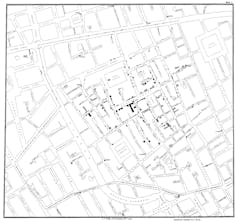
A well-known example is John Snow’s discovery of the source of a cholera outbreak in London’s Soho neighbourhood in 1854. Now considered one of epidemiology’s founding fathers, Snow canvassed door to door asking whether the families within had had cholera. His analysis came chiefly in the re-organisation of the data he collected – its plotting on a map – such that a pattern might emerge. This ultimately established not just the extent of the outbreak but also its source, the Broad Street water pump.
For Boston-born Codman, an outspoken medical reformer working at the beginning of the 20th century, such use of data to understand disease was up there as “one of the greatest moments in medicine”.

This article is part of Conversation Insights
The Insights team generates long-form journalism derived from interdisciplinary research. The team is working with academics from different backgrounds who have been engaged in projects aimed at tackling societal and scientific challenges.
Though Codman was involved in many data-driven reforms during his controversial career, one of the most successful was the Registry of Bone Sarcoma, which he established in 1920. His goal was to collect and analyse all of the cases of bone cancer (or suspected bone cancer) from across the US, and to use these to establish diagnostic criteria, therapeutic effectiveness and a standardised nomenclature.
There were a few rules for this registry. Individual doctors who contributed had to send x-rays, case reports and, if possible, tissue samples for examination by the registry’s consulting pathologists and Codman himself. This would ensure both the accuracy and uniformity of pathological analysis. The effort was a success which grew over time: by 1954, when the American College of Surgeons sought a new home for the registry, it contained an impressive 2,400 complete, cross-referenced cases.

On the face of it, Codman’s decision to focus on bone cancer was baffling. It was neither a pressing nor a common concern for doctors across the US. But the disease’s relative rarity was one reason he chose it. Codman felt the amount of data received from his nationwide request would not be overwhelming for his small team of researchers to analyse.
Perhaps more importantly, he knew that studying bone cancer would raise the ire of far fewer of his colleagues than a more common disease might. In a clinical atmosphere in which expertise was understood as a combination of long experience with a dash of intuition – the physician’s “art” – Codman’s touting of data as a better way to obtain knowledge about a disease and its treatment was already being met with vociferous opposition.
It didn’t help that he tended to be inflammatory and provocative in the pursuit of his data-driven goals. At a medical meeting in Boston in 1915, he launched a surprise attack on his fellow practitioners. In the middle of this staid affair, Codman unveiled an 8ft cartoon lampooning his colleagues for their apathy toward healthcare reform and, as he saw it, their wilful ignorance of the limitations of the profession. As one (former) friend put it in the event’s aftermath, Codman’s only hope was that people would take the “charitable” view and consider him not an enemy of the profession but merely “mentally deranged”.
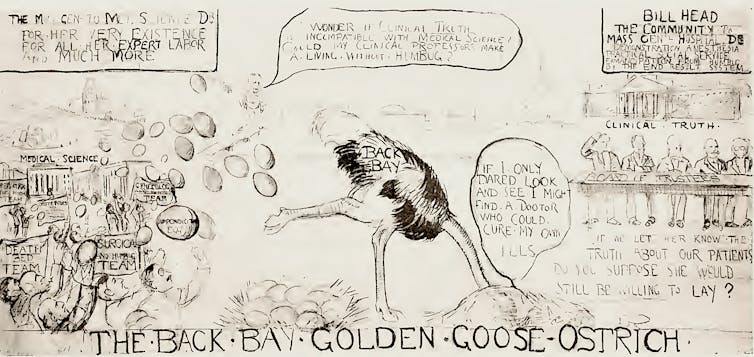
Undeterred, Codman continued this pugnacious approach to his pioneering work. In a 1922 letter to the prestigious Boston Medical and Surgical Journal, he complained that the surgeons of Massachusetts had been particularly unhelpful to his registry. He explained that he had – politely – asked the 5,494 physicians in the state to “drop him a postal stating whether or not he knew of a case” so that Codman could acquire “the best statistics ever obtained on the frequency of the disease”. To his chagrin, he had received only 19 responses in nearly two years. Needling the journal’s editors and readers simultaneously, he asked:
Is this because your Journal is not read? … [Or] because of the indifference of the medical profession as to whether the frequency of bone sarcoma is known or not?
Codman proposed a questionnaire that would allow the journal to see whether the problem was its lack of readership, or his colleagues’ “inertia, procrastination, disapproval, opposition or disinterest”. A subsequent editorial in response to Codman’s proposal was surprisingly magnanimous:
Whether we will it or not, we are obliged to be irritated, amused or instructed, according to our temperaments, by Dr Codman. Our advice is to be instructed.
An End To Elitism?
Despite the establishment’s resistance, submissions to Codman’s registry began to grow such that by 1924, he had enough material to make preliminary comments about bone cancer. For one thing, he had succeeded in standardising the much-contested matter of the proper nomenclature for the disease. This, he exulted, was so significant that it should be likened to the “rising of the sun”.
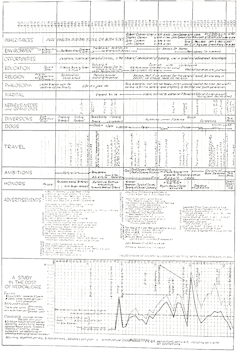
The registry also offered up many pieces of “impersonal proof”, as Codman called his data-driven findings, of the rightness of certain theories that individual physicians had promoted. Claims, for example, that combined treatments of “surgery, mixed toxins and radium” were more effective than treatments that relied on any of these alone were borne out by the data.
The registry, as Codman’s colleague Joseph Colt Bloodgood put it, “excited great interest” among practitioners, and not just because it had “influenced the entire medical world to pay more attention to bone tumours”. More importantly, it provided a new model for how to do medical work. Another admiring colleague responded to Bloodgood:
The work of the registry [is] one of the outstanding American contributions to surgical pathology. As a method of study, it shows the necessity of very wide experience before a surgeon is capable of handling intelligently cases of this disease … [It] is impossible for any single individual to claim finality of this sort.
This emphasis on “very wide experience” over the experience of “any single individual” points to another critical reason to prefer data, according to Codman. His goal in changing the method by which medical knowledge was made was not just to get better results. By seeking to undo the image of medicine as an “art” that depended on the wisdom of a select group of preternaturally talented individuals, Codman also threatened to undo the class-ridden reality that underlay this public veneer.
As the efficiency engineer Frank Gilbreth implied in a 1913 article in the American Magazine, if it was true that medicine required no specific intrinsic gifts (monetary or otherwise), then absolutely anybody – whatever their class, race or background – could do it, including “bricklayers, shovellers and dock-wallopers” who were currently shut out of such “high-brow” occupations.
Codman was even more pointed. If data was used to evaluate the outcomes of his physician colleagues, he insisted, it would show that the quality of doctors and hospitals was generally poor. He sniped that they excelled chiefly in “making dying men think they are getting better, concealing the gravity of serious diseases, and exaggerating the importance of minor illnesses to suit the occasion”.

“Nepotism, pull and politics” were the order of the day in medicine, Codman wrote in one of his most scathing takedowns of his colleagues at the Massachusetts General Hospital. Yet he made himself the centrepiece of this critique, conceding that his entrance to Harvard Medical School had come on the back of “friends and relatives among the well-to-do”. The only difference, he suggested, was that he was willing to own up to it, and to subject himself and his work to the scrutiny of data.
Data’s Unflattering View Of Medicine
Codman was not the only person having a come-to-Jesus moment with data over this period. In the 1920s, the American social science researchers Robert and Helen Lynd collected data in the small US town of Muncie, Indiana, as a way of creating a picture of the “averaged American”.
By the 1930s, the similarly-minded Mass Observation project took off in Britain, intending to collect data about everyday life so as to create an “anthropology of ourselves”. Crucially, both reflected the thinking that also drove Codman: that the right way to know something – a people, a disease – was to produce what seemed a suitably representative average. And this meant the amalgamation of often quite diverse and wide-ranging characteristics and their compression into a single, standard, efficient unit.
The turn from describing representative averages to learning from these averages is probably best articulated in the work of pollsters, whose door-to-door interrogations were aimed at helping a nation to know itself by statistics. In 1948, inspired by their failure to correctly predict the outcome of the US presidential election – one of the most famous psephological errors in the nation’s history – pollsters such as George Gallup and Elmo Roper began to rethink their analytic methods, spinning away from quota sampling and towards random sampling.
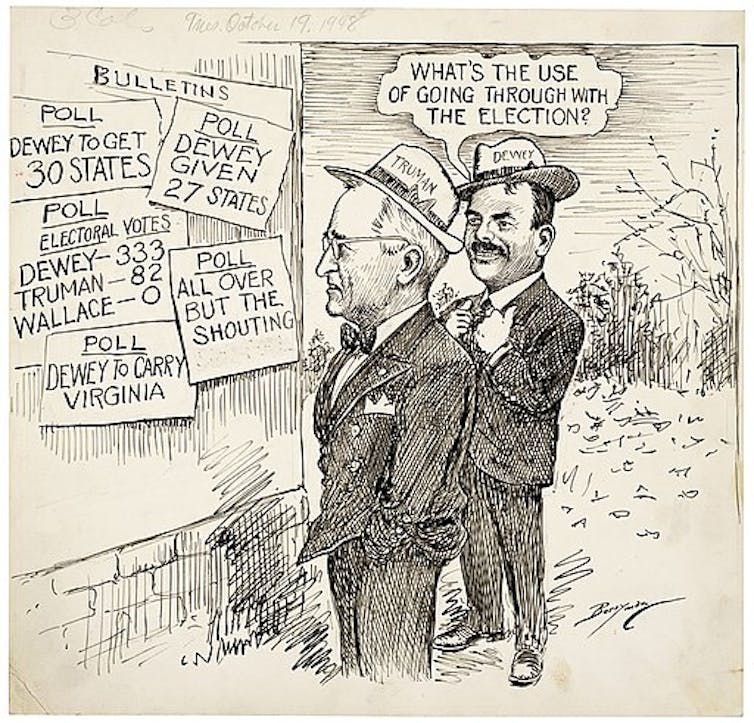
At the same time, thanks primarily to its military applications, the science of computing began to gather pace. And the growing fascination with knowing the world via data combined with the unparalleled ability of computers to crunch it appeared a match made in heaven.
In a late-in-life preface to his 1934 data-driven magnum opus on the anatomy of the shoulder, Codman had comforted himself with the thought that he was a man ahead of his time. And indeed, just a few years after his death in 1940, statistical analysis began to pick up steam in medicine.
Over the next two decades, figures such as Sir Ronald Fisher, the geneticist and statistician remembered for suggesting randomisation as an antidote to bias, and his English compatriot Sir Austin Bradford Hill, who demonstrated the connection between smoking and lung cancer, also pushed forward the integration of statistical analysis into medicine.

However, it would take many more years for word to finally leak out that, by data’s measure, both the methodologies of medical research and much of medicine itself was ineffective. In a movement led in part by outspoken Scottish epidemiologist Archie Cochrane, this unflattering statistical view of medicine finally really saw the light of day in the 1960s and 70s.
Cochrane went so far as to say that medicine was based on “a level of guesswork” so great that any return to health after a medical intervention was more a “tribute to the sheer survival power of the minds and bodies” of patients than anything else. Aghast at the revelations embedded in Cochrane’s 1972 book, Random Reflections on Health Services, the Guardian journalist Ann Shearer wrote:
Isn’t it … more than fair to ask what on Earth we – and more particularly, the medical They – have been doing all these years to let the health machine develop with such a lack of quality control?
The answer dates back to Codman’s bone cancer registry half a century earlier. The medical establishment on both sides of the Atlantic had been avoiding with all their might the scrutiny that data would bring.
Computers Finally Acquire Medical Currency
Despite their increasing ubiquity in the 1970s and 80s, computers had still only haltingly joined the medical mainstream. Though a smattering of AI applications began to appear in healthcare in the 1970s, it was only in the 1990s that computers really started to acquire some medical currency.
In a page borrowed straight from Codman’s time, the pioneering American biomedical informatician Edward Shortliffe noted in 1993 that the future of AI in medicine depended on the realisation that “the practice of medicine is inherently an information-management task”.
In the US, the Institute of Medicine and the President’s Information Technology Advisory Council released reports highlighting the failures of medicine to fully embrace information technology. By 2004, a newly appointed national coordinator for health information technology was charged with the herculean task of establishing an electronic medical record for all Americans by 2014.

This explosion of interest in bringing computers into healthcare made it an enticing and potentially lucrative area for investment. So it is no surprise that IBM celebrated Watson’s winning turn on Jeopardy! in 2011 by putting it to work on an oncology-focused programme with multiple US-based clinical partners selected on the basis of their access to medical data.
The idea was laudable. Watson would do what machine learning algorithms do best: mining the massive amounts of data these institutions had at their disposal, searching for patterns that would help to improve treatment. But the complexity of cancer and the frustratingly unique responses of patients to it, yoked together by data systems that were sometimes incomplete and sometimes incompatible with each other or with machine learning’s methods more generally, limited Watson’s ability to be useful.
One sorry example was Watson’s Oncology Expert Advisor, a collaboration with the MD Anderson Cancer Center in Houston, Texas. This had begun its life as a “bedside diagnostic tool” that pored through patient records, scientific literature and doctors’ notes in order to make real-time treatment recommendations. Unfortunately, Watson couldn’t “read” the doctors’ notes. While good at mining the scientific literature, it couldn’t apply these large-scale discussions to the specifics of the individuals in front of it. By 2017, the project had been shelved.
Elsewhere, at New York City’s famed Memorial Sloan Kettering Cancer Center, clinicians found a more elaborate – and infinitely more problematic – way forward. Rather than relying on the retrospective data that is machine learning’s usual fodder, clinicians invented new “synthetic” cases that were, by virtue of having been invented, infinitely less messy and more complete than any real data could be.
The project re-litigated the “data v expertise” debate of Codman’s time – once more in Codman’s favour – since this invented data had built into it the specifics of cancer treatment as understood by a small group of clinicians at a single hospital. Bias, in other words, was programmed directly in, and those engaged in training the system knew it.
Viewing historical patient data as too narrow, they rationalised that replacing this with data that reflected their own collective experience, intuition and judgment could build into Watson For Oncology the latest and greatest treatments. Of course, this didn’t work any better in the early 21st century than it had in the early 20th.

Furthermore, while these clinicians sidestepped the problem of real data’s impenetrable messiness, treatment options available at a wealthy hospital in Manhattan were far removed from those available in the other localities that Watson was meant to serve. The contrast was perhaps starkest when Watson was introduced to other parts of the world, only to find the treatment regimens it recommended either didn’t exist or were not in keeping with the local and national infrastructures governing how healthcare was done there.
Even in the US, the consensus, as one unnamed physician in Florida reported back to IBM, was that Watson was a “piece of shit”. Most of the time, it either told clinicians what they already knew or offered up advice that was incompatible with local conditions or the specifics of a patient’s illness. At best, it offered up a snapshot of the views of a select few clinicians at a moment in time, now reified as “facts” that ought to apply uniformly and everywhere they went.
Many of the elegies written to mark Watson’s selling-off in 2022, having failed to make good on its promise in healthcare, attributed its downfall to the same kind of overpromise and under-delivery that has spelled the end for many health technology start-ups.
Some maintained that the scaling-up of Watson from gameshow savant to oncological wunderkind might have been successful with more time. Perhaps. But in 2011, time was of the essence. To capitalise on the goodwill toward Watson and IBM that Jeopardy! had created, to be the trailblazer into the lucrative but technologically backward world of healthcare, had meant striking first and fast.
Watson’s high-profile failure highlights an overlooked barrier to modern, data-driven healthcare. In its encounters with real, human patients, Watson stirred up the same anxieties that Codman had encountered – difficult questions about what it is exactly that medicine produces: care, and the human touch that comes with it; or cure, and the information management tasks that play a critical role here?
A 2019 study of US patient perspectives of AI’s role in healthcare gave these concerns some statistical shape. Though some felt optimistic about AI’s potential to improve healthcare, a vast majority gave voice to fundamental misgivings about relinquishing medicine to machine learning algorithms that could not explain the logic they employed to reach their diagnosis. Surely the absence of a physician’s judgment would increase the risk of misdiagnosis?
The persistence of this worry has quite often resulted in caveating the work of machine learning with reassurances that humans are still in charge. In a 2020 report on the InnerEye project, for example, which used retrospective data to identify tumours on patient scans, Yvonne Rimmer, a clinical oncologist at Addenbrooke’s Hospital in Cambridge, addressed this concern:
It’s important for patients to know that the AI is helping me in my professional role. It’s not replacing me in the process. I doublecheck everything the AI does, and can change it if I need to.
Data’s Uncertain Role In The Future Of Healthcare
Today, whether a doctor gives you your diagnosis or you get it from a computer, that diagnosis is not primarily based on the intuition, judgment or experience of either doctor or patient. It’s driven by data that has made our cultures of mainstream care relatively more uniform and of a higher standard. Just as Codman foresaw, the introduction of data in medicine has also forced a greater degree of transparency, both in terms of methodologies and effectiveness.
However, the more important – and potentially intractable – problem with this modern approach to health is its lack of representation. As the Sloan Kettering dalliance with Watson began to show, datasets are not the “impersonal proofs” that Codman took them to be.
Even under less egregiously subjective conditions, data undeniably replicates and concretises the biases of society itself. As MIT computer scientist Marzyeh Ghassemi explains, data offers the “sheen of objectivity” while replicating the ethnic, racial, gender and age biases of institutionalised medicine. Thus the tools, tests and techniques that are based on this data are also not impartial.
Ghassemi highlights the inaccuracy of pulse oximeters, often calibrated on light-skinned individuals, for those with darker skin. Others might note the outcry over the gender bias in cardiology, spelled out especially in higher mortality rates for women who have heart attacks.
The list goes on and on. Remember the human genome project, that big data triumph which has, according to the US National Institutes of Health website, “accelerated the study of human biology and improved the practice of medicine”? It almost exclusively drew upon genetic studies of white Europeans. According to Esteban Burchard at the University of California, San Francisco:
96% of genetic studies have been done on people with European origin, even though Europeans make up less than 12% of the world’s population … The human genome project should have been called the European genome project.
A lack of representative data has implications for big data projects across the board – not least for precision medicine, which is widely touted as the antidote to the problems of impersonal, algorithm-driven healthcare.
Precision or “personalised” medicine seeks to address one of the essential perceived drawbacks of data-based medicine by locating finer-grained commonalities between smaller and smaller subsets of the population. By focusing on data at a genetic and cellular level, it may yet counter the criticism that the data-driven approach of recent decades is too blunt and insensitive a tool, such that “even the most frequently prescribed drugs for the most common conditions have very limited efficacy”, according to computational biologist Chloe-Agathe Azencott.
But personalised medicine still feeds on the same depersonalised data as medicine more generally, so it too is handicapped by data’s biases. And even if it could step beyond the problems of biased data – and, indeed, institutions – the question of its role in the future of our everyday healthcare does not end there.
Even taking the utopian view that personalised medicine might make possible treatments as individual as we are, pharmaceutical companies won’t develop these treatments unless they are profitable. And that requires either prices so high that only the wealthiest of us could afford them, or a market so big that these companies can “achieve the requisite return on investment”. Truly individualised care is not really on the table.
If our goal in healthcare is to help more people by being more representative, more inclusive and more attentive to individual difference in the medical everyday of diagnosis and treatment, big data isn’t going to help us out. At least not as things currently stand.
For the story of healthcare data to date has pointed us squarely in the other direction, towards homogenisation and standardisation as medical goals. Laudable as the rationales for such a focus for medicine have been at different moments in our history, our expectations for the potential for machine learning to enable all of us to live longer, healthier lives remain something of a pipe dream. Right now it is still us humans, not our computer overlords, who hold most sway over our individual health outcomes.
Dr Caitjan Gainty is a winner of The Conversation’s Sir Paul Curran award for academic communication

For you: more from our Insights series:
The discovery of insulin: a story of monstrous egos and toxic rivalries
Drugs, robots and the pursuit of pleasure – why experts are worried about AIs becoming addicts
To hear about new Insights articles, join the hundreds of thousands of people who value The Conversation’s evidence-based news. Subscribe to our newsletter.![]()
Caitjan Gainty, Senior Lecturer in the History of Science, Technology and Medicine, King's College London
This article is republished from The Conversation under a Creative Commons license. Read the original article.
Summer In Pittwater Is: Having Fun With Dad
National Seniors Welcomes New Chief Operating Officer

- Presented eight submissions to the Royal Commission into Aged Care Quality and Safety and was a significant contributor to the recommendations in the Royal Commission’s Final Report in 2021, with National Seniors Australia referenced in 50 instances.
- Influenced government from the first day of the Royal Commission to reduce the home care wait list by 25 per cent in twelve months by releasing tens of thousands of home care packages in September 2021, to help ease an unacceptable wait time for 41,000 older Australians.
- Influenced retirement income policy with National Seniors consumer research reports being referred to 10 times in the Report of the Treasury Retirement Income Review.
- Launching a successful Older Persons COVID-19 Support Line to reach out to older Australians particularly those living in the most isolated communities and people in COVID-19 ‘hot spots’ during the many lockdowns and restrictions.
- National Seniors was one of 142 participants invited to the Jobs and Skills Summit in September 2022 at the Great Hall of Parliament, and the only organisation representing older Australians, resulting in the announcement of the $4,000 income credit – an important first step in addressing jobs and skills shortages in the workforce.
- Achieved wins with the advocacy team to improve the lives of older Australians including extending eligibility for concessions, freezing deeming rates for two years, extending the Pension Loan Scheme, opposing the scraping of franking credits.
- Appointed by the Prime Minister to the new 14-member, independent Council of Elders to advise the Minister and Government on aged care reform.
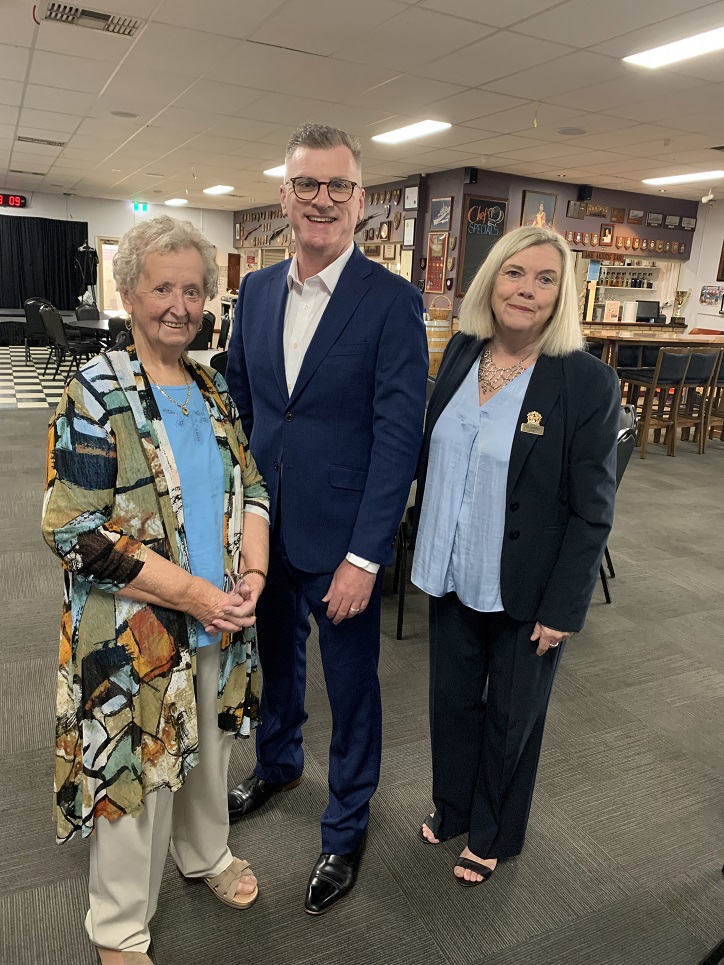
Oxfam Report States Richest 1% Bag Nearly Twice As Much Wealth As The Rest Of The World Put Together Over The Past Two Years: They Are Also The Highest Carbon Polluters - One Million Times More Than Average Person
- Super-rich outstrip their extraordinary grab of half of all new wealth in past decade.
- Billionaire fortunes are increasing by $2.7 billion a day even as at least 1.7 billion workers now live in countries where inflation is outpacing wages.
- A tax of up to 5 percent on the world’s multi-millionaires and billionaires could raise $1.7 trillion a year, enough to lift 2 billion people out of poverty.
- Introduce one-off solidarity wealth taxes and windfall taxes to end crisis profiteering.
- Permanently increase taxes on the richest 1 percent, for example to at least 60 percent of their income from labor and capital, with higher rates for multi-millionaires and billionaires. Governments must especially raise taxes on capital gains, which are subject to lower tax rates than other forms of income.
- Tax the wealth of the richest 1 percent at rates high enough to significantly reduce the numbers and wealth of the richest people, and redistribute these resources. This includes implementing inheritance, property and land taxes, as well as net wealth taxes.
China’s COVID cases may have hit 900 million. What’s headed our way?
Michael Toole, Burnet InstituteOver the weekend, Peking University released a study that estimated 900 million Chinese had been infected with COVID up until January 11, representing 64% of the population.
This compares with 43% of Australians testing positive, although antibody studies indicate a much higher proportion is likely.
With Lunar New Year approaching, what will this massive wave mean for China and the rest of the world, including Australia?
Numbers Are Not The Whole Story
The Chinese government says there have been almost 60,000 deaths of people with COVID in hospitals in the past five weeks. However, under China’s narrow definition of COVID deaths, the government claims COVID caused only 5,500 of these deaths because they died of respiratory failure.
Since early December, media reports have revealed a major surge of cases is overwhelming hospitals, funeral homes and crematoriums. Yet throughout December the government reported fewer than 10,000 daily cases and single-digit daily deaths. There have been no official reports since January 12.
This lack of transparency led the director-general of the World Health Organization to plead for more timely information in order to make a thorough risk assessment of the situation on the ground.

Do These New Data Help Us Understand The Situation?
Not really. The figure of 900 million cases compares to the official tally of 503,000 – a huge gap that could only be resolved by a systematic collection of COVID infection data from all provinces.
The reported deaths all occurred in hospitals. There is no indication of how many people have died at home or in aged care facilities. Most cities and counties in China have a routine death certification system and this information should be available to the National Health Commission.
If we accept both the Peking University case data and the government report on deaths (adding the previous 5,300 reported deaths), the cumulative case fatality ratio is 0.07 per 1,000 cases. This compares with 1.5 per 1,000 in Australia, which arguably has a better hospital system.
So, the Chinese figure is not plausible; either cases have been overestimated or deaths have been underestimated. Even if China has not yet reached 900 million cases, lessons from other countries with similarly abandoned public health measures say it soon will.
Why Has This Surge Happened?
The surge has coincided with the abandonment of China’s Zero COVID policy and the removal of almost all preventive measures. But the underlying reason is low population immunity due to both a previous low rate of infections and a relatively low vaccination rate. While around 90% of the population has received two doses of the vaccine, only 58% have received a third dose booster.
Vaccination rates among elderly Chinese are much lower. The government recently announced that around 30% of people aged 60 and over – roughly 80 million people – were not vaccinated and boosted. Among those 80 or older, it was closer to 60%.
Vaccine hesitancy is very common among the elderly in China and Hong Kong. While two doses of the main Chinese vaccines – Sinopharm and Sinovac – have proved effective, they are far less effective as boosters than mRNA vaccines, which China refuses to import.
Shortage Of Antivirals May Increase Death Toll
Given the vaccination rate is so low among the elderly, ready access to antiviral drugs is essential. However, the government did not stock up on these drugs and they are almost impossible to get except on the black market where a five-day course of Paxlovid costs at least US$2,300 (A$3,300).
Negotiations with Pfizer, the manufacturer of Paxlovid, and Merck, which makes Lagevrio, have broken down because of China’s insistence on a lower price.
Implications For The Rest Of The World, Including Australia
With international travel to and from China resuming, it’s inevitable the virus will spread to other countries.
Many countries, including Australia, insist on travellers having a negative COVID test within 48 hours of departure. Others like South Korea, Taiwan, Japan and Italy also require tests on arrival. South Korea has reported 23% of travellers from China tested COVID-positive. In Taiwan it was 21%.
The world may not see the full impact of the surge in China for another month or so. During the Lunar New Year period, an expected 2 billion trips will be made within China. This will transmit the virus to remote rural villages where there is minimal health care and no genomic sequencing facilities. So, the virus could infect an immunocompromised individual who may harbour the virus for months. This could result in a mutation that emerges as a more transmissible variant.

So, the Australian policy of pre-departure testing makes sense but should also include the routine testing of wastewater from planes arriving from China. That said, a new variant originating in China may not arrive directly but via countries, such as Indonesia, that do not require pre-departure testing. Random testing of wastewater on all arriving international flights would be helpful.
Most importantly, Australia needs to be prepared for a change in the dynamics of the pandemic either due to a new variant from China or the XBB.1.5 subvariant raging through the United States. And we are not coping well as it is.
We need to improve our vaccination booster rate, make a serious investment in clean indoor air, use high-quality masks in poorly ventilated settings and provide easy access to COVID testing. Currently, because of our misplaced comfort with widespread transmission, these measures are flagging or absent. That’s at our peril.![]()
Michael Toole, Associate Principal Research Fellow, Burnet Institute
This article is republished from The Conversation under a Creative Commons license. Read the original article.
Separation Leads To Significant But Temporary Gender Differences In Parent-Child Time
- Parental separation leads to strong increases in gender inequalities in childcare time. After separation, mother-child time doubles, two-parent time declines threefold, and father-child time remains low.
- Parental separation also leads to a decline in children's time allocated to educational activities (e.g., studying, reading) and an increase in children's time in unstructured activities (e.g., TV watching, video gaming, smartphone use).
- The effect of separation on children's time use is twice as large for boys than for girls, with gender gaps in children's unstructured time increasing over time.
- These effects of separation, particularly regarding mother-child time, is temporary, with strong effects in the short run, and a return to pre-separation levels after 2-4 years.
Australian Breakthrough In Fighting Legionnaires' Disease

People with disabilities in group homes are suffering shocking abuse. New housing models could prevent harm

The National Disability Insurance Scheme (NDIS) was designed to be a market-based system that would shift power from government and providers to consumers.
The NDIS Quality and Safeguards Commission’s Own Motion Inquiry report demonstrates that for the most vulnerable NDIS participants, there is still a power imbalance, with providers and workers still in charge.
The Commission found more than 7,000 serious incidents were reported in a sample of seven disability group homes over the past four years. Given that many people living in group homes are voiceless and unable to report, this is likely to be a significant underestimate of incidents. This latest report shows 17,000 Australians living in group homes are too frequently subjected to sexual misconduct, coercion, serious injury, abuse and neglect.
Most people living in group homes are “captive” to traditional disability providers. They are locked into arrangements where they have little or no choice about where they live, who they live with or who provides personal and other supports. But we know there are far better options.
The Right To Choose Where You Live
In addition to the quality of support being a problem in group homes, the physical environment is often also inadequate. Most group homes are old housing stock that does not meet contemporary standards. Most of this stock is owned by state governments.
The buildings do not foster independence, dignity or privacy. The redevelopment of this stock into contemporary housing that incorporates assistive technology and is designed to maximise independence has the potential to reduce the cost of paid supports and the liability of the scheme.
Australia is a signatory to the United Nations Convention on the Rights of Persons with Disabilities that states people with disabilities should:
[…] have the opportunity to choose their place of residence and where and with whom they live on an equal basis with others and are not obliged to live in a particular living arrangement.
Many people now living in group homes across Australia have the capacity to move to more individualised and inclusive living arrangements. A further 2,500 younger people with disability live in aged care. To explore alternatives and make an informed choice, NDIS participants in group homes and aged care need skilled and patient support from independent experts.

More Independent Options
Under the Coalition government, the National Disability Insurance Agency (NDIA) saw independent living options as a short-term solution to cut costs. Instead, it could improve participant outcomes, increase independence and reduce lifetime care costs.
While many people with disabilities are living good lives in individual supported living arrangements with funding from the NDIS, most require enormous effort and commitment from family members to set up and maintain.
The NDIA needs to fund expert support so a greater range of NDIS participants, including those with limited social support, can set up and maintain high quality independent living options.
Co-Located Apartments
New disability housing in Australia includes more than 1,300 single occupancy apartments being developed by specialist disability accommodation providers.
These apartments generally have ten apartments co-located in a mainstream development so NDIS participants are not segregated. They have neighbours like everyone else and can live with their partner or children.
There is smart home and communication technology built into each apartment and an additional apartment that is a base for support workers to enable the cost-effective delivery of support. While this model does not suit everyone, early research shows it has the potential to increase the health, wellbeing and independence of people with disability and reduce support costs.
Under the previous government, the NDIA undermined rather than embraced this innovation in disability housing.
Not Everyone Has Family To Rely On
The most vulnerable people with disability are those who do not have family or friends in their lives. They are totally dependent on people who are paid to support them.
At worst, all the paid people in their lives may be employed by one organisation, such as in a group home. This increases their vulnerability to mistreatment and might make them less likely to feel they can report abuse or neglect to a trusted or independent person.
For this reason, the proposed increased regulation for group homes is unlikely to improve lives or keep people safe.
Not everyone will be able to move out of group homes into more independent living options. However, there are a range of solutions that will transform disability housing and support in Australia:
growing evidence-based programs that support NDIS participants to maintain and develop social relationships, and increase community participation
information and resources co-designed by people with disability for people with disability about exploring housing options, support and moving house
independent experts to support people in group homes to explore housing and support options, make an informed choice and move out if and when they want to
peer support services that provide the wisdom and expertise of other people with disability who have made a move
decision-making support for people with cognitive and communication impairments
scaling up evidence-based interventions such as participant-led videos that enable NDIS participants to train and direct the disability support workers who work for them
developing new training courses for disability support workers that are evidence based and co-designed by people with disability
developing a range of individualised and contemporary models of housing and support
government to address third line forcing ie, where people living in an group home are required to used one provider for all of their disability supports (sometimes includes support coordination and allied health)
measuring the outcomes and experiences of NDIS participants who move to inform ongoing innovation and foster a truly consumer-driven market.
Empowering People With Disabilities
An effective market-based system requires empowered consumers who are able to make informed decisions about the services and products they use.
At the start of the scheme, more than A$100 million was invested in supporting providers to make the transition to a market-based system.
The latest findings are shocking and show Australia needs to invest now in the capacity of NDIS participants to be part of an effective and safe disability housing market driven by the people living in it.
The real solutions to the abuse and neglect in group homes involve supporting people with disability to become informed and empowered consumers, exercise choice and control and realise their citizenship.![]()
Di Winkler, Adjunct Associate Professor, La Trobe University
This article is republished from The Conversation under a Creative Commons license. Read the original article.
Murray Valley encephalitis has been detected in mozzies in NSW and Victoria. Here’s what you need to know
Cameron Webb, University of SydneyWhere there’s water, you’ll find mosquitoes – including some that transmit viruses that can make us seriously ill.
Authorities have been on alert after an outbreak of Japanese encephalitis last summer which resulted in 45 human cases and seven deaths. Favourable conditions for mosquitoes continued.
Now, we’ve seen the return of another pathogen to southeastern Australia: Murray Valley encephalitis virus. Mosquitoes carrying the virus have been detected in New South Wales and northern Victoria.
While Murray Valley encephalitis is endemic in Northern Australia, meaning it is always present in mosquitoes, it’s not often detected in southeastern Australia. No human cases have yet been reported in the southern states, but past outbreaks after floods show we need to be cautious.
What Is Murray Valley Encephalitis Virus?
Murray Valley encephalitis virus is a member of the Flavivirus family, which includes Japanese encephalitis, dengue, yellow fever and West Nile viruses.
Murray Valley encephalitis causes similar symptoms to Japanese encephalitis virus. Encephalitis means inflammation, or swelling, of the brain.
Only a small proportion of people infected, perhaps as few as one in 1,000, will develop symptoms. These include fever, headache and vomiting, as well as neurological problems resulting in confusion, dizziness, or loss of consciousness.
The disease, like that caused by Japanese encephalitis virus, is fatal in up to 30% of those who get symptoms.
People who survive may have permanent neurological complications that require life-long medical care. Only around 40% of those experiencing severe symptoms recover completely.
How Does It Spread?
Waterbirds such as herons and egrets are the natural hosts of the virus. Mosquitoes pick up the virus as they feed on the blood of birds, and then pass it on to people when the mosquitoes bite again.
The key mosquito driving spread of the virus is Culex annulirostris. It thrives in freshwater habitats and travels many kilometres from local wetlands.
The virus circulates between mosquitoes and waterbirds during the wet season in northern Australia, particularly in the Kimberley region.
After flooding, the virus makes its way into southeastern Australia from northern regions of the country. Waterbirds travel to newly flooded areas for favourable feeding and breeding conditions.
With flooding continuing in southeastern Australia, as well as Queensland and Western Australia, mosquito numbers are expected to remain high in many regions of Australia for months ahead. More mosquitoes and more waterbirds increase the likelihood of infection in people.

What Happened In Past Outbreaks?
The virus was first isolated in 1951 from patients who died from encephalitis in the Murray Valley. The outbreak included 45 reported cases, including 19 deaths.
But that wasn’t the first or last outbreak. There is evidence the virus was causing human disease in the early 1900s and at the time was known as “Australian X disease”.
The most significant outbreak occurred in 1974 with 58 cases reported including 13 fatalities. Seasonal agricultural workers became reluctant to travel to the regions impacted by the virus.
The virus didn’t disappear after 1974. It has been sporadically detected in humans, mosquitoes, or other animals, most commonly in northern and central Australia.
The largest outbreak since 1974 in southeastern Australia was in 2011, with a total of 17 cases reported including three deaths.
The major trigger for previous outbreaks has always been above average rainfall.
What Can We Do About It?
Unlike Japanese encephalitis, there is no vaccine for Murray Valley encephalitis.
Preventing mosquito bites is critical to stop infection. The steps you take to stop mosquito bites every other summer will reduce the spread of Murray Valley encephalitis virus too.
Those spending lots of time outdoors face the greatest risk. To reduce mosquito bites:
avoid outdoor activity at dusk and during evening near wetlands or bushland areas where mosquitoes are active
cover up with light coloured, loose-fitting, long-sleeved shirts with long pants and covered shoes
use topical insect repellents containing diethytoluamide, picaridin, or oil of lemon eucalyptus. These formulations will provide the longest-lasting protection against mosquito bites if applied to all exposed areas of skin
use insect screens and nets around the home on windows and doors, and while camping
use “knockdown” insect sprays and plug-in repellent devices indoors or in sheltered outdoor areas.
The risk of Murray Valley encephalitis virus will remain for months ahead. It’s not until the colder weather of autumn arrives that mosquito populations will decline and with them the risks of disease.
Perhaps the return of El Niño dominated weather patterns in coming years, with less rainfall and fewer favourable breeding spots for mosquitoes and waterbirds, the virus will disappear from southeastern Australia. But for how long?![]()
Cameron Webb, Clinical Associate Professor and Principal Hospital Scientist, University of Sydney
This article is republished from The Conversation under a Creative Commons license. Read the original article.
Moderna’s experimental cancer vaccine treats but doesn’t prevent melanoma – a biochemist explains how it works

Media outlets have reported the encouraging findings of clinical trials for a new experimental vaccine developed by the biotech company Moderna to treat an aggressive type of skin cancer called melanoma.
Although this is potentially very good news, it occurred to me that the headlines may be unintentionally misleading. The vaccines most people are familiar with prevent disease, whereas this experimental new skin cancer vaccine treats only patients who are already sick. Why is it called a vaccine if it does not prevent cancer?
I am a biochemist and molecular biologist studying the roles that microbes play in health and disease. I also teach cancer genetics to medical students and am interested in how the public understands science. While preventive and therapeutic vaccines are administered for different health care goals, they both train the immune system to recognize and fight off a specific disease agent that causes illness.

How Do Preventive Vaccines Work?
Most vaccines are administered to healthy people before they get sick to prevent illnesses caused by viruses or bacteria. These include vaccines that prevent polio, measles, COVID-19 and many other diseases. Researchers have also developed vaccines to prevent some types of cancers that are caused by such viruses as the human papillomaviruses and Epstein-Barr virus.
Your immune system recognizes objects such as certain microbes and allergens that do not belong in your body and initiates a series of cellular events to attack and destroy them. Thus, a virus or bacterium that enters the body is recognized as something foreign and triggers an immune response to fight off the microbial invader. This results in a cellular memory that will elicit an even faster immune response the next time the same microbe intrudes.
The problem is that sometimes the initial infection causes serious illness before the immune system can mount a response against it. While you may be better protected against a second infection, you have suffered the potentially damaging consequences of the first one.
This is where preventive vaccines come in. By introducing a harmless version or a portion of the microbe to the immune system, the body can learn to mount an effective response against it without causing the disease.
For example, the Gardasil-9 vaccine protects against the human papillomavirus, or HPV, which causes cervical cancer. It contains protein components found in the virus that cannot cause disease but do elicit an immune response that protects against future HPV infection, thereby preventing cervical cancer.
How Does The Moderna Cancer Vaccine Work?
Unlike cervical cancer, skin melanoma isn’t caused by a viral infection, according the latest evidence. Nor does Moderna’s experimental vaccine prevent cancer as Gardasil-9 does.
The Moderna vaccine trains the immune system to fight off an invader in the same way preventive vaccines most people are familiar with do. However, in this case the invader is a tumor, a rogue version of normal cells that harbors abnormal proteins that the immune system can recognize as foreign and attack.
What are these abnormal proteins and where do they come from?
All cells are made up of proteins and other biological molecules such as carbohydrates, lipids and nucleic acids. Cancer is caused by mutations in regions of genetic material, or DNA, that encode instructions on what proteins to make. Mutated genes result in abnormal proteins called neoantigens that the body recognizes as foreign. That can trigger an immune response to fight off a nascent tumor. However, sometimes the immune response fails to subdue the cancer cells, either because the immune system is unable to mount a strong enough response or the cancer cells have found a way to circumvent the immune system’s defenses.
Moderna’s experimental melanoma vaccine contains genetic information that encodes for portions of the neoantigens in the tumor. This genetic information is in the form of mRNA, which is the same form used in the Moderna and Pfizer-BioNtech COVID-19 vaccines. Importantly, the vaccine cannot cause cancer, because it encodes for only small, nonfunctional parts of the protein. When the genetic information is translated into those protein pieces in the body, they trigger the immune system to mount an attack against the tumor. Ideally, this immune response will cause the tumor to shrink and disappear.
Notably, the Moderna melanoma vaccine is tailor-made for each patient. Each tumor is unique, and so the vaccine needs to be unique as well. To customize vaccines, researchers first biopsy the patient’s tumor to determine what neoantigens are present. The vaccine manufacturer then designs specific mRNA molecules that encode those neoantigens. When this custom mRNA vaccine is administered, the body translates the genetic material into proteins specific to the patient’s tumor, resulting in an immune response against the tumor.
Combining Vaccination With Immunotherapy
Vaccines are a form of immunotherapy, because they treat diseases by harnessing the immune system. However, other immunotherapy cancer drugs are not vaccines because, while they also stimulate the immune system, they do not target specific neoantigens.
In fact, the Moderna vaccine is co-administered with the immunotherapy drug pembrolizumab, which is marketed as Keytruda. Why are two drugs needed?
Certain immune cells called T-cells have molecular accelerator and brake components that serve as checkpoints to ensure they are revved up only in the presence of a foreign invader such as a tumor. However, sometimes tumor cells find a way to keep the T-cell brakes on and suppress the immune response. In these cases, the Moderna vaccine correctly identifies the tumor, but T-cells cannot respond to it.
Pembrolizumab, however, can bind directly to a brake component on the T-cell, inactivating the brake system and allowing the immune cells to attack the tumor.
Not A Preventive Cancer Vaccine
So why can’t the Moderna vaccine be administered to healthy people to prevent melanoma before it arises?
Cancers are highly variable from person to person. Each melanoma harbors a different neoantigen profile that cannot be predicted in advance. Therefore, a vaccine cannot be developed in advance of the illness.
The experimental mRNA melanoma vaccine, currently still in early-phase clinical trials, is an example of the new frontier of personalized medicine. By understanding the molecular basis of diseases, researchers can explore how their underlying causes vary among people, and offer personalized therapeutic options against those diseases.![]()
Mark R. O'Brian, Professor and Chair of Biochemistry, Jacobs School of Medicine and Biomedical Sciences, University at Buffalo
This article is republished from The Conversation under a Creative Commons license. Read the original article.
Astronomers reveal the most detailed radio image yet of the Milky Way’s galactic plane

Two major astronomy research programs, called EMU and PEGASUS, have joined forces to resolve one of the mysteries of our Milky Way: where are all the supernova remnants?
A supernova remnant is an expanding cloud of gas and dust marking the last phase in the life of a star, after it has exploded as a supernova. But the number of supernova remnants we have detected so far with radio telescopes is too low. Models predict five times as many, so where are the missing ones?
We have combined observations from two of Australia’s world-leading radio telescopes, the ASKAP radio telescope and the Parkes radio telescope, Murriyang, to answer this question.
The Gas Between The Stars
Images: R. Kothes (NRC) and E. Carretti (INAF).
The new image reveals thin tendrils and clumpy clouds associated with hydrogen gas filling the space between the stars. We can see sites where new stars are forming, as well as supernova remnants.
In just this small patch, only about 1% of the whole Milky Way, we have discovered more than 20 new possible supernova remnants where only seven were previously known.
These discoveries were led by PhD student Brianna Ball from Canada’s University of Alberta, working with her supervisor, Roland Kothes of the National Research Council of Canada, who prepared the image. These new discoveries suggest we are close to accounting for the missing remnants.
So why can we see them now when we couldn’t before?

The Power Of Joining Forces
I lead the Evolutionary Map of the Universe or EMU program, an ambitious project with ASKAP to make the best radio atlas of the Southern Hemisphere.
EMU will measure about 40 million new distant galaxies and supermassive black holes, to help us understand how galaxies have changed over the history of the universe.
Early EMU data have already led to the discovery of odd radio circles (or “ORCs”), and revealed rare oddities like the “Dancing Ghosts”.
For any telescope, the resolution of its images depends on the size of its aperture. Interferometers like ASKAP simulate the aperture of a much larger telescope. With 36 relatively small dishes (each 12m in diameter) but a 6km distance connecting the farthest of these, ASKAP mimics a single telescope with a 6km wide dish.
That gives ASKAP a good resolution, but comes at the expense of missing radio emission on the largest scales. In the comparison above, the ASKAP image alone appears too skeletal.

To recover that missing information, we turned to a companion project called PEGASUS, led by Ettore Caretti of Italy’s National Institute of Astrophysics.
PEGASUS uses the 64m diameter Parkes/Murriyang telescope – one of the largest single-dish radio telescopes in the world – to map the sky.
Even with such a large dish, Parkes has rather limited resolution. By combining the information from both Parkes and ASKAP, each fills in the gaps of the other to give us the best fidelity image of this region of our Milky Way galaxy. This combination reveals the radio emission on all scales to help uncover the missing supernova remnants.
Linking the datasets from EMU and PEGASUS will allow us to reveal more hidden gems. In the next few years we will have an unprecedented view of almost the entire Milky Way, about a hundred times larger than this initial image, but with the same level of detail and sensitivity.
We estimate there may be up to 1,500 or more new supernova remnants yet to discover. Solving the puzzle of these missing remnants will open new windows into the history of our Milky Way.
ASKAP and Parkes are owned and operated by CSIRO, Australia’s national science agency, as part of the Australia Telescope National Facility. CSIRO acknowledge the Wajarri Yamaji people as the Traditional Owners and native title holders of Inyarrimanha Ilgari Bundara, the CSIRO Murchison Radio-astronomy Observatory, where ASKAP is located, and the Wiradjuri people as the traditional owners of the Parkes Observatory.![]()
Andrew Hopkins, Professor of Astronomy, Macquarie University
This article is republished from The Conversation under a Creative Commons license. Read the original article.
The last 5 kilos really are the hardest to lose. Here’s why, and what you can do about it

Anyone who has tried to lose weight will be familiar with these nine frustrating words: the last five kilos are the hardest to lose.
You’re just about to hit your target weight, but suddenly the scales won’t budge – even though you’re still following the same healthy diet, lifestyle habits and exercise plan.
There’s a scientific basis for why losing the last few kilos is hard, called the weight-loss plateau. But before you hit Google for one of those programs promising to help you lose the last five kilos, here’s some important information about why it occurs, and five simple things you can do to break through it.
Understanding The Weight-Loss Plateau
The weight-loss plateau is basic biology.
When your body registers something threatening its survival, it automatically triggers a series of physiological responses to protect against the threat.
So when we adjust our diet and reduce our calorie intake, our body registers we’re losing weight and believes it’s under threat. It makes adjustments for protection, reducing our metabolic rate and burning less energy, slowing the rate at which we lose weight.
It also secretes higher levels of an appetite hormone called ghrelin, which is known to increase hunger and promote the conservation of fat stores.
Research has shown this plateau starts to creep in anywhere between three and six months of weight loss, and then typically weight regain occurs. So for those needing to lose a large amount of weight, the plateau will be evident well before the last five kilos.

A weight-loss plateau can be hard to break. Whatever the time frame, it’s a sign your previously successful approach to losing weight needs modification.
Here’s what you can do.
1. Revisit Your Weight-Loss Goal
The first and most important thing you may need to modify when you hit a weight-loss plateau is your definition of healthy body weight.
Ask yourself: what’s so special about the weight I’m trying to achieve?
Many people use the body mass index (BMI) to set their weight-loss goal but the number on the scales – and the score generated when you enter your weight and height into the BMI calculator – is nonsense. It doesn’t tell the whole story of what it means to be a healthy weight.
This is because the BMI calculator misses two more meaningful measures: body fat percentage and body fat distribution.
If you’ve been exercising regularly as part of your weight-loss plan, you’ll have gained muscle, or improved your muscle-to-fat ratio, and muscle is heavier than body fat, impacting the number on the scales.
You’re also likely to have changed where fat is distributed in your body, reducing the amount of unhealthy fat stored around the stomach, close to the organs, thus reducing your risk of disease.
So grab the tape measure, check how your clothes fit, and think about how you feel to confirm whether you really need to lose those final few kilos. Work towards a waist circumference of about 80cm for women and about 90-94cm for men.

2. Focus On Meal Size Throughout The Day
The current fad is intermittent fasting. This often means breakfast is the first to be scrapped from the menu in an attempt to cut calories from the diet and shorten the time you’re allowed to eat throughout the day. But when you eat and how much you eat at each meal does matter, and it’s breakfast that’s the most important.
Controlled research studies have shown this is the time when your body best uses the calories you put in – in fact, it burns the calories from a meal two-and-a-half times more efficiently in the morning compared with the evening. Instead of reducing your eating window, load up your breakfast and reduce the size of your evening meal.
3. Consider More Strength-Building Exercises
Relying on diet alone to lose weight can reduce muscle along with body fat. This slows your metabolism, and makes it harder to keep the weight off in the long term.
Any physical activity will go a long way to preserving your muscle mass, but it’s important to incorporate a couple of days of strength-building exercises in your weekly exercise routine. Exercises using body weight – like push-ups, pull-ups, planks and air squats – are just as effective as lifting weights in the gym.
4. Review Your Food Intake
As you lose weight, your body requires less fuel, so reviewing and adjusting your calorie intake is essential when you hit a weight-loss plateau.
Generally speaking, you need to consume 10% fewer calories when you reduce your weight by 10%, just to maintain the new weight. But this shouldn’t mean deprivation or starvation. Instead, you should be focusing on an abundance of nutrient-dense foods and keeping the treats and takeaway to just once per week.
5. Check Your Stress
Stress will derail your weight-loss success. Stress increases your body’s production of cortisol, promoting fat storage and triggering unhealthy food cravings.
The best type of stress management is exercise. To encourage more exercise, take up something you enjoy, no matter what it is. But make sure to include variety, as doing the same routine every day is a sure-fire way to get bored and avoid activity, and can also make it hard to hit your goals.
The Bottom Line
A weight-loss plateau is frustrating and can derail your diet attempt.
Understanding why the weight-loss plateau occurs, making sure the weight-loss target you’ve set is realistic, and following the steps above will get you back on track.![]()
Nick Fuller, Charles Perkins Centre Research Program Leader, University of Sydney
This article is republished from The Conversation under a Creative Commons license. Read the original article.
Disclaimer: These articles are not intended to provide medical advice, diagnosis or treatment. Views expressed here do not necessarily reflect those of Pittwater Online News or its staff.
